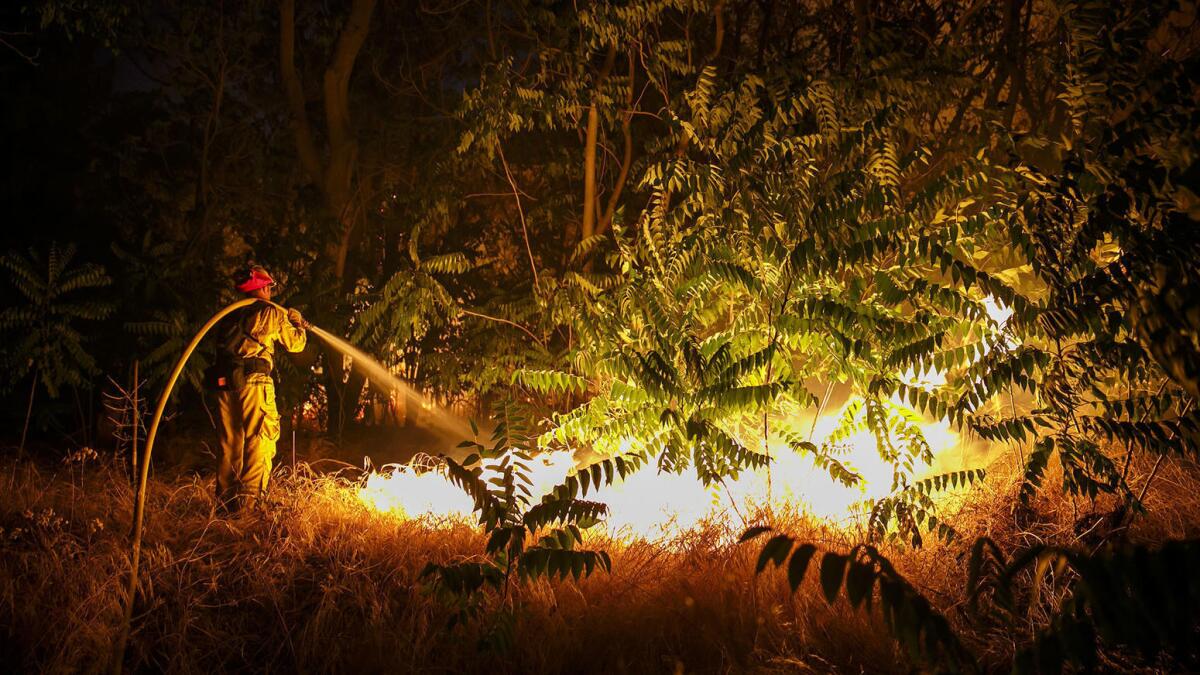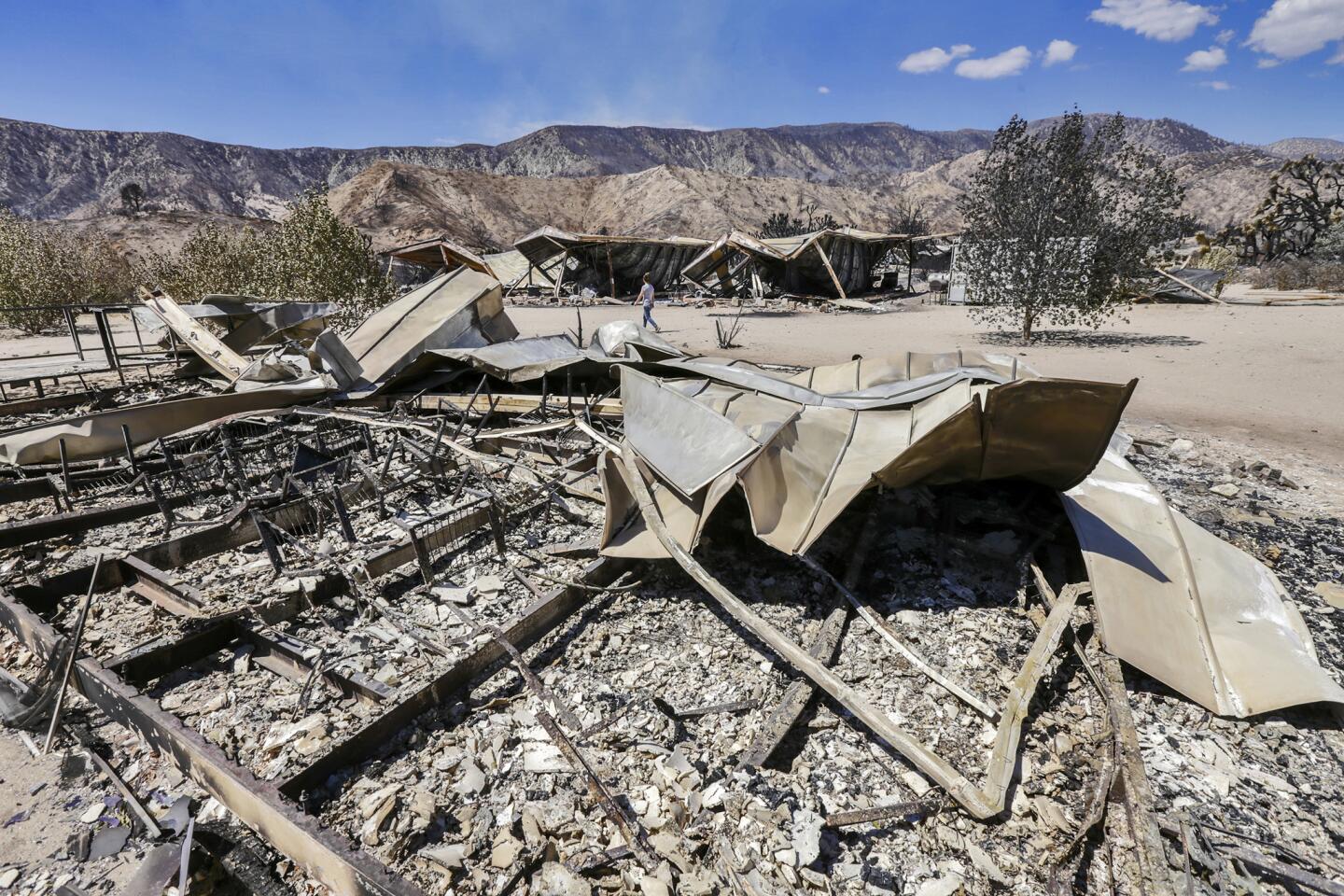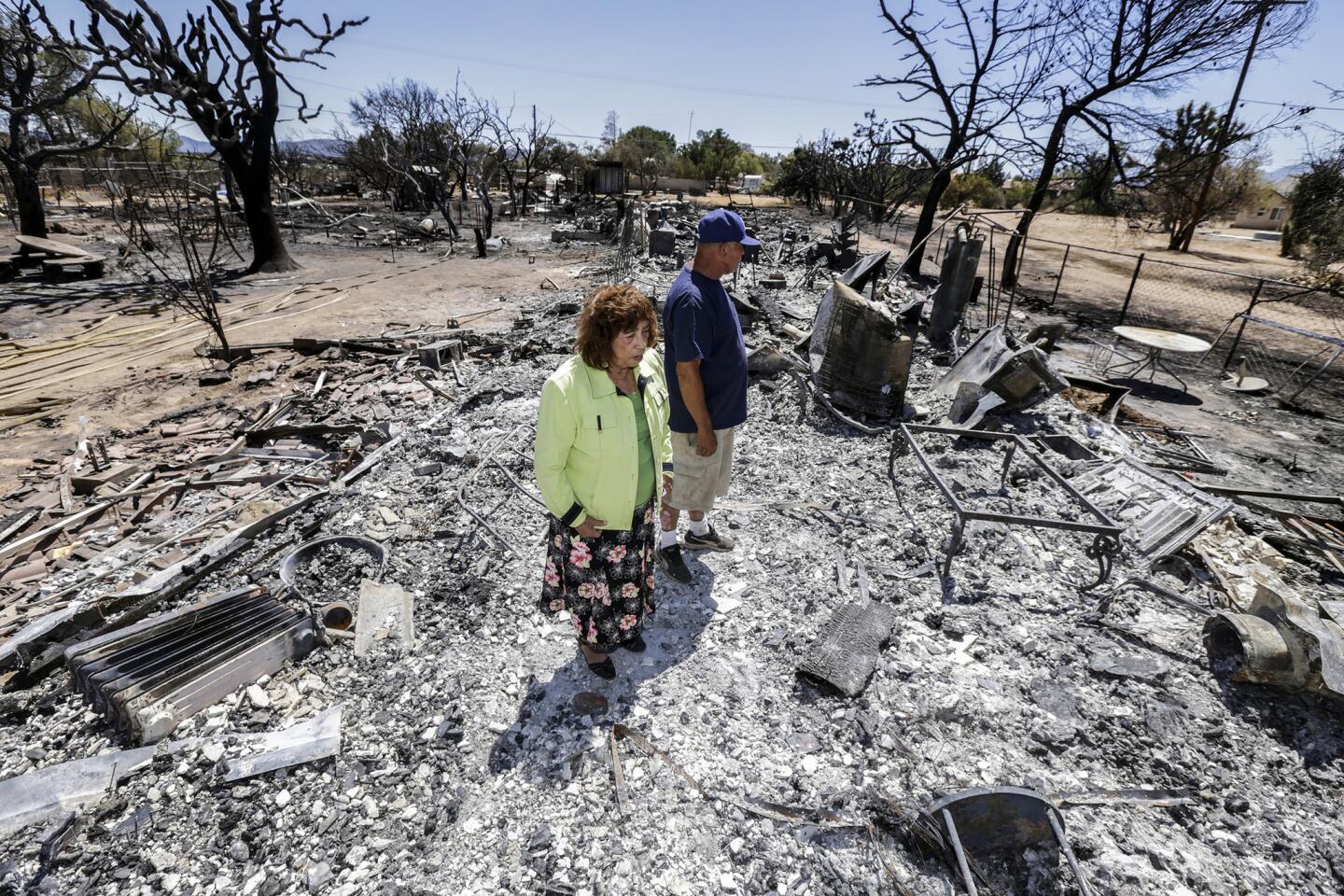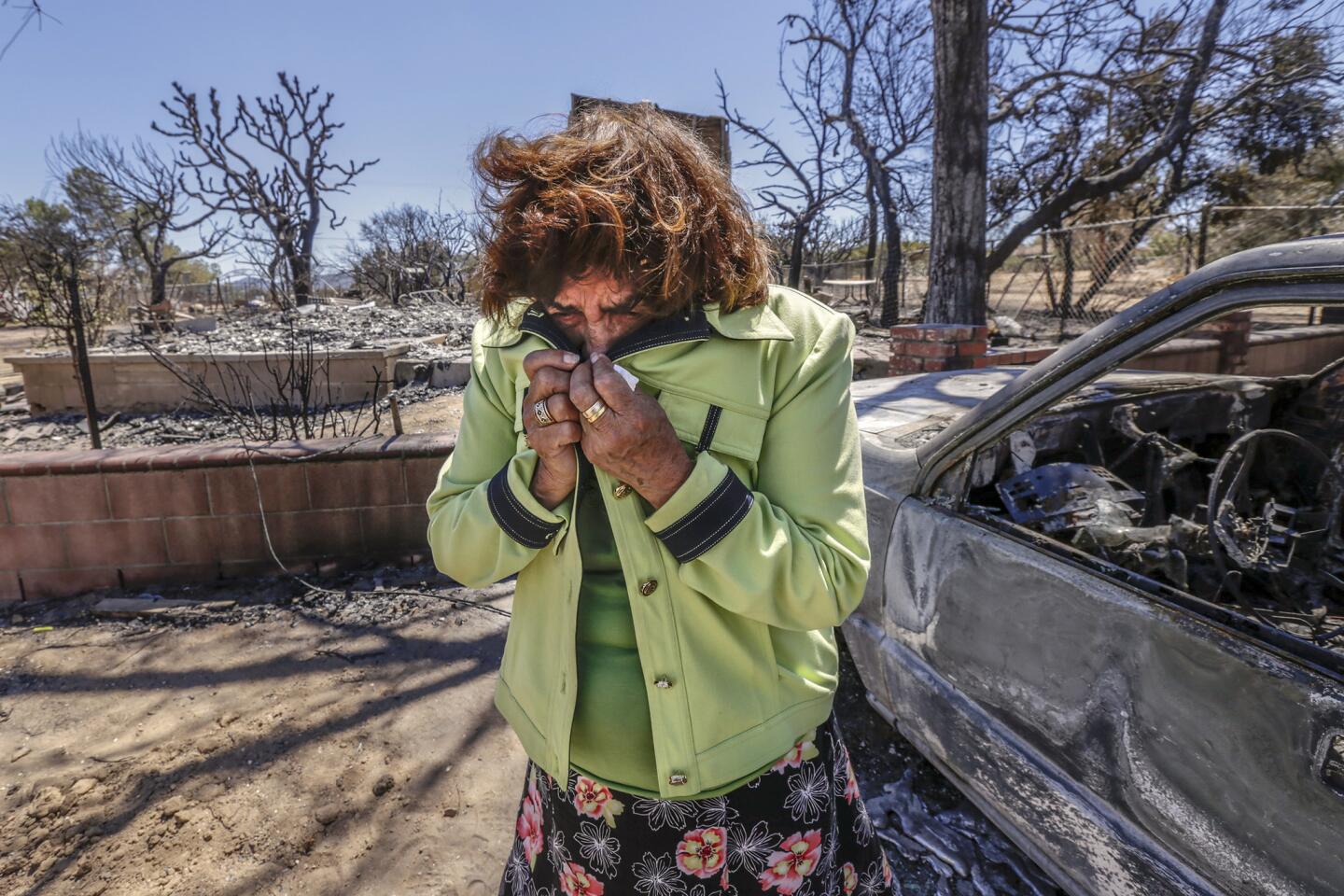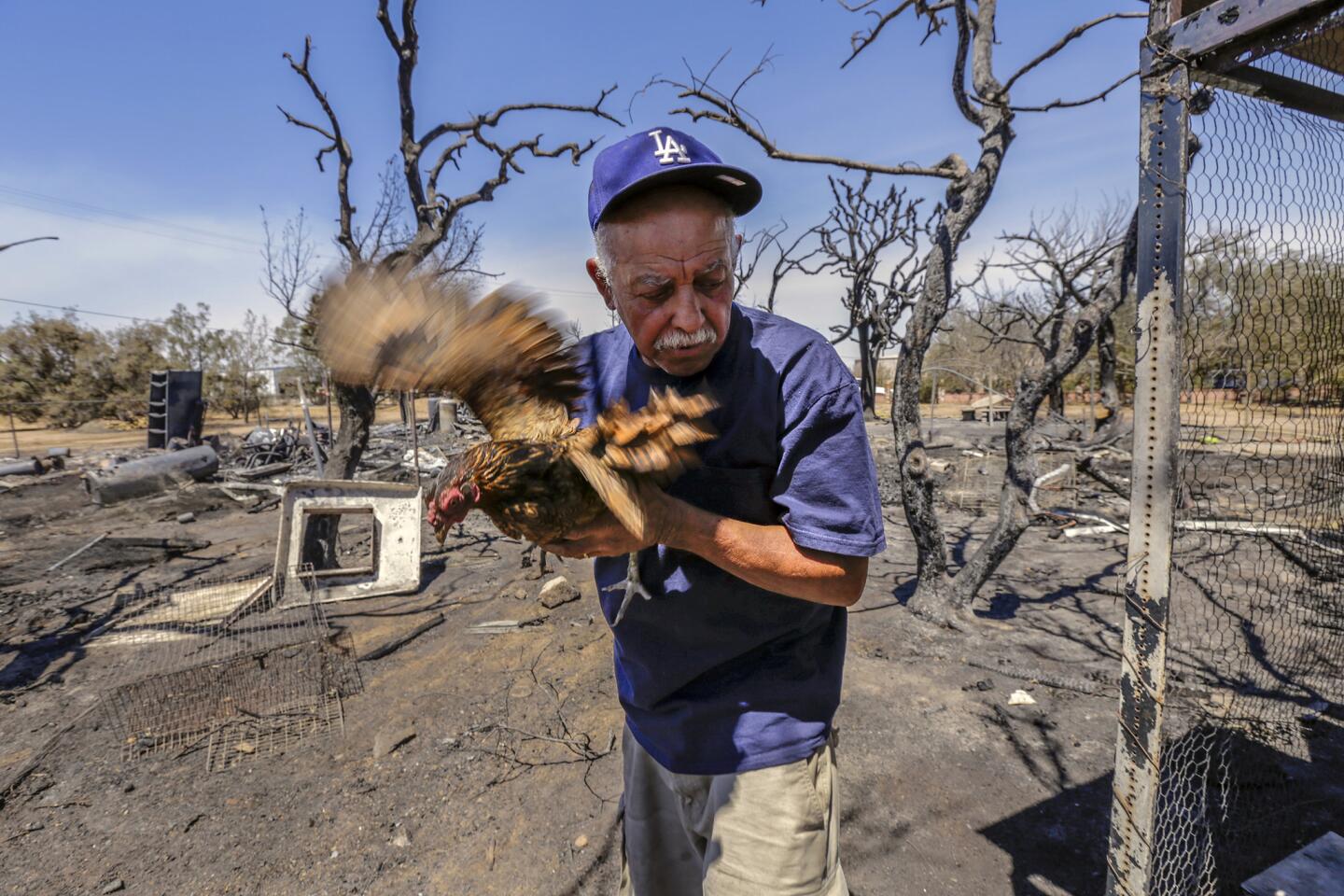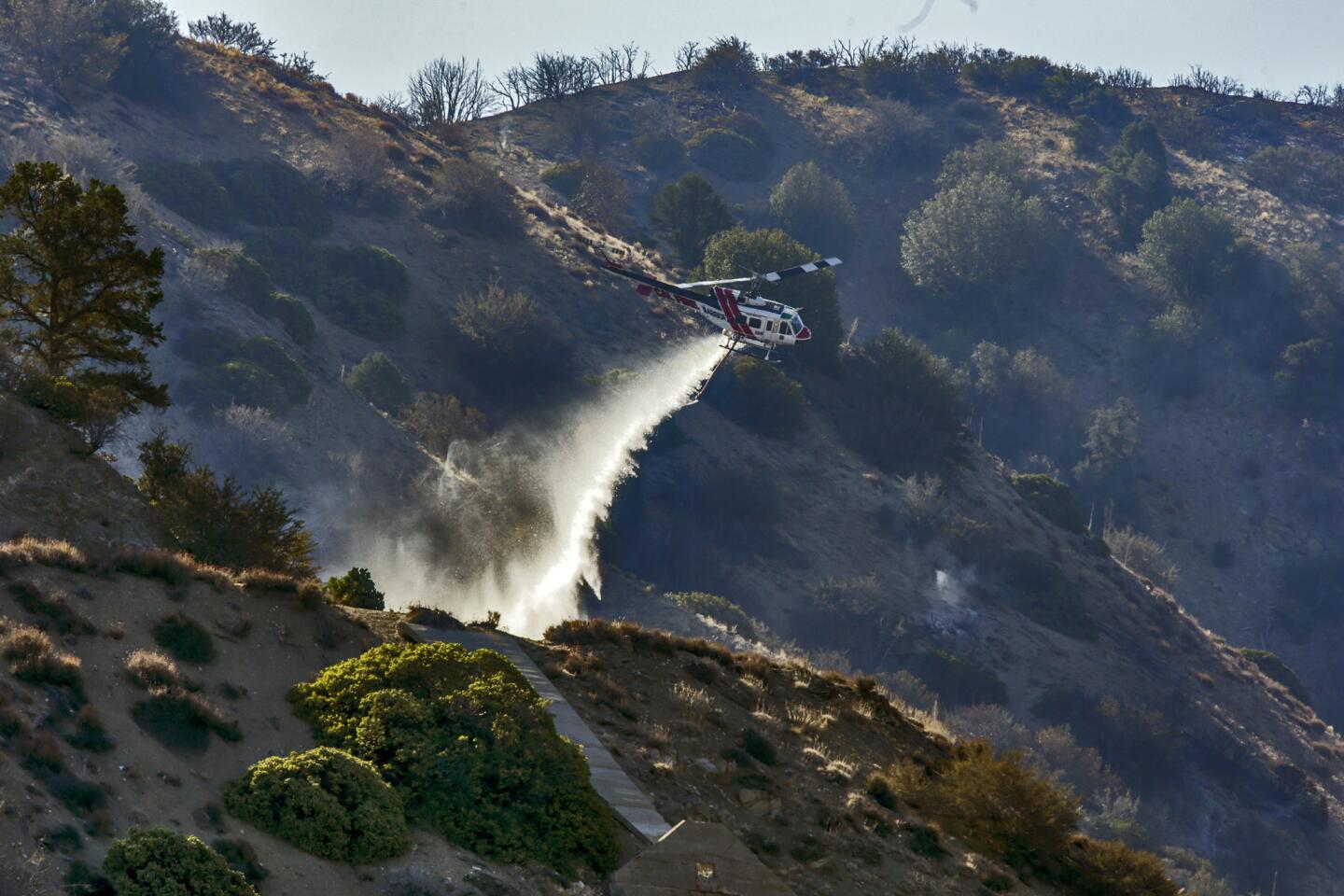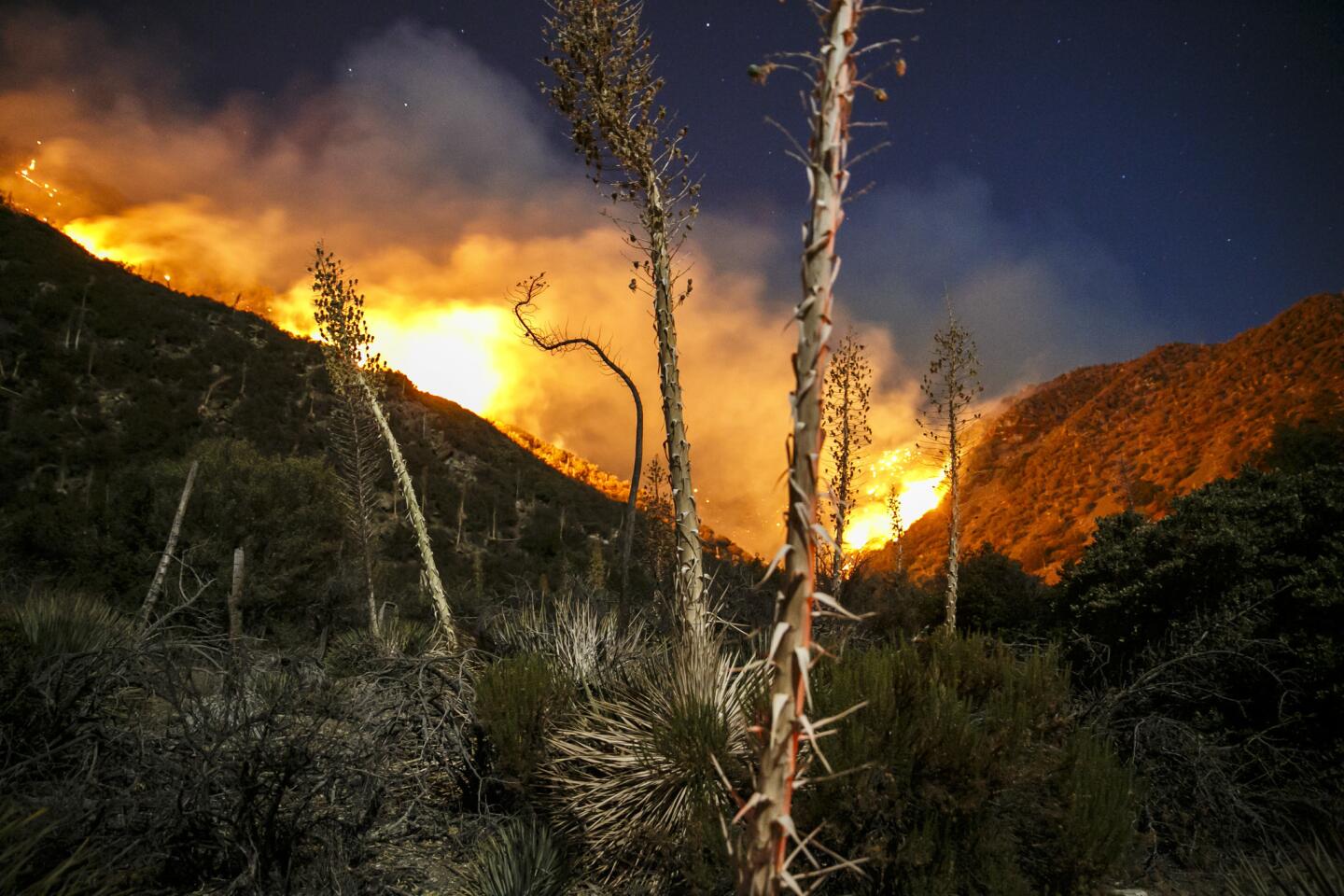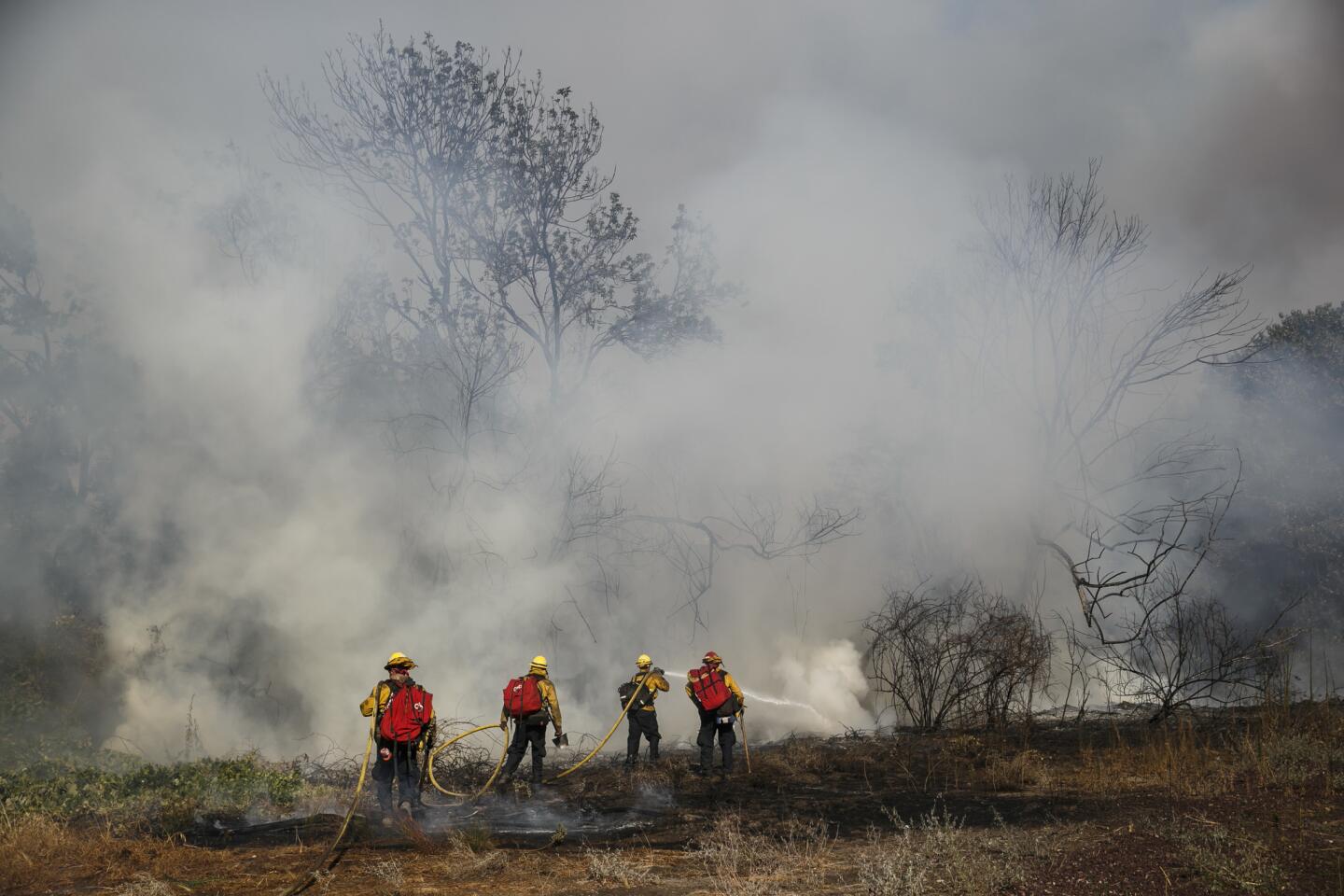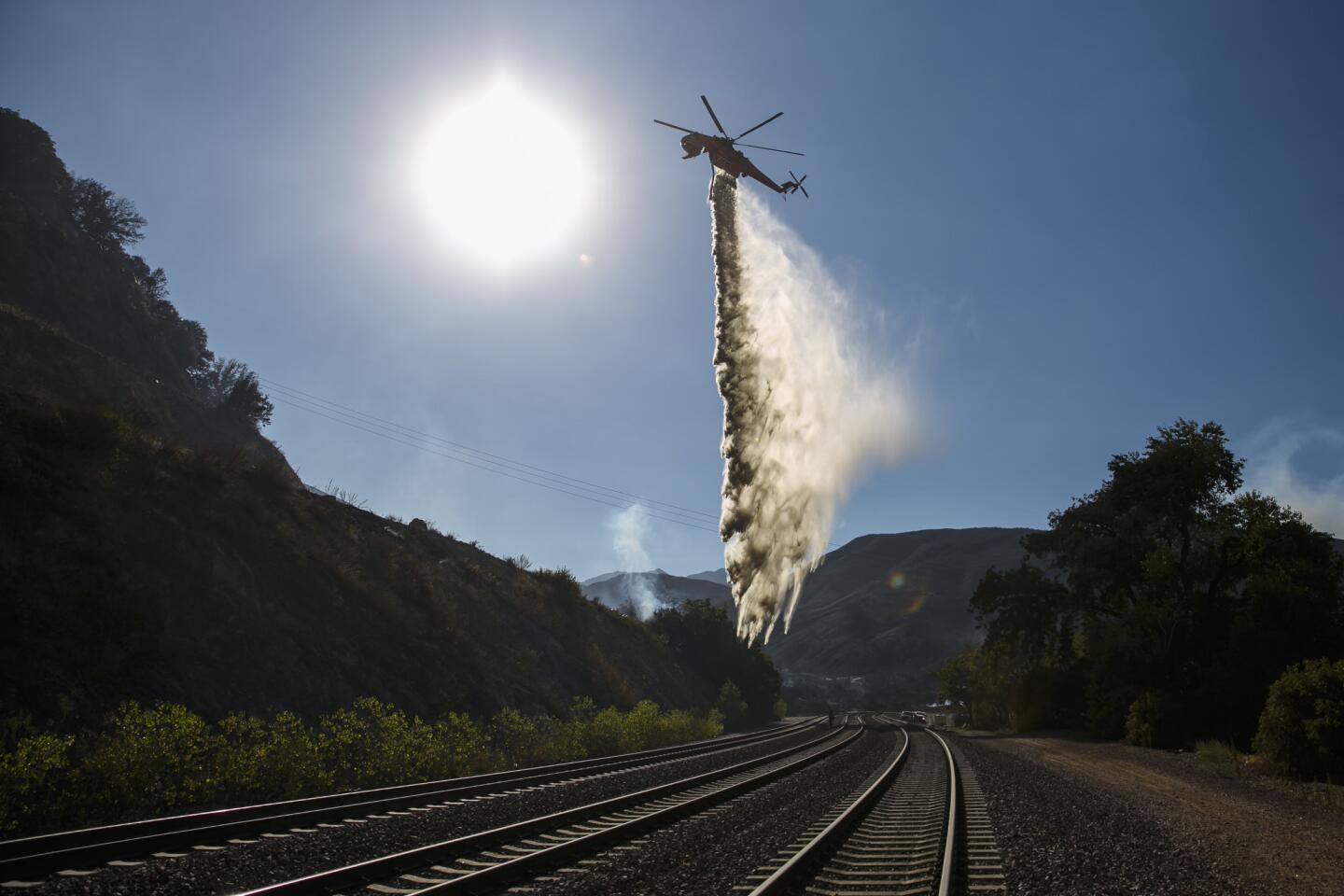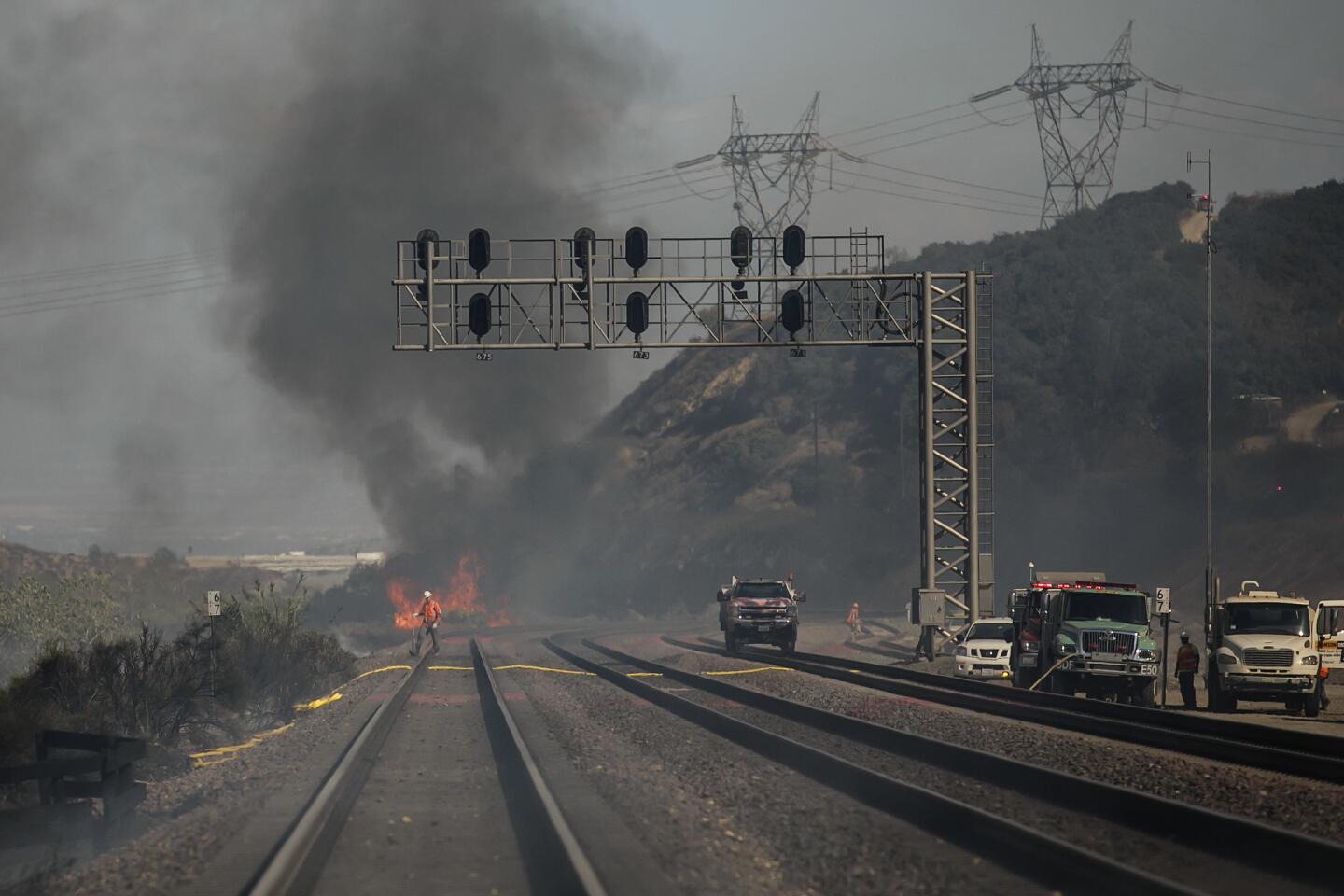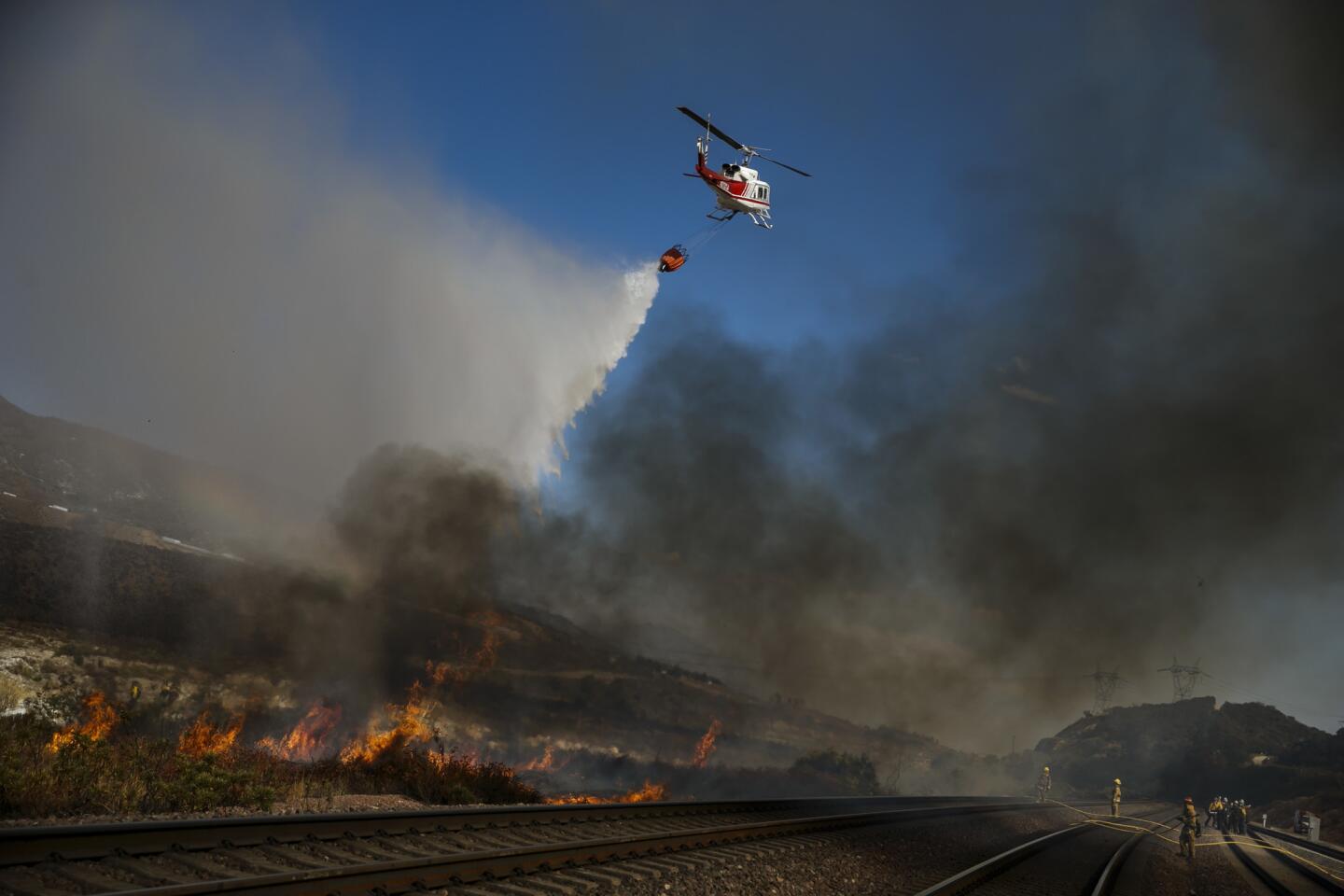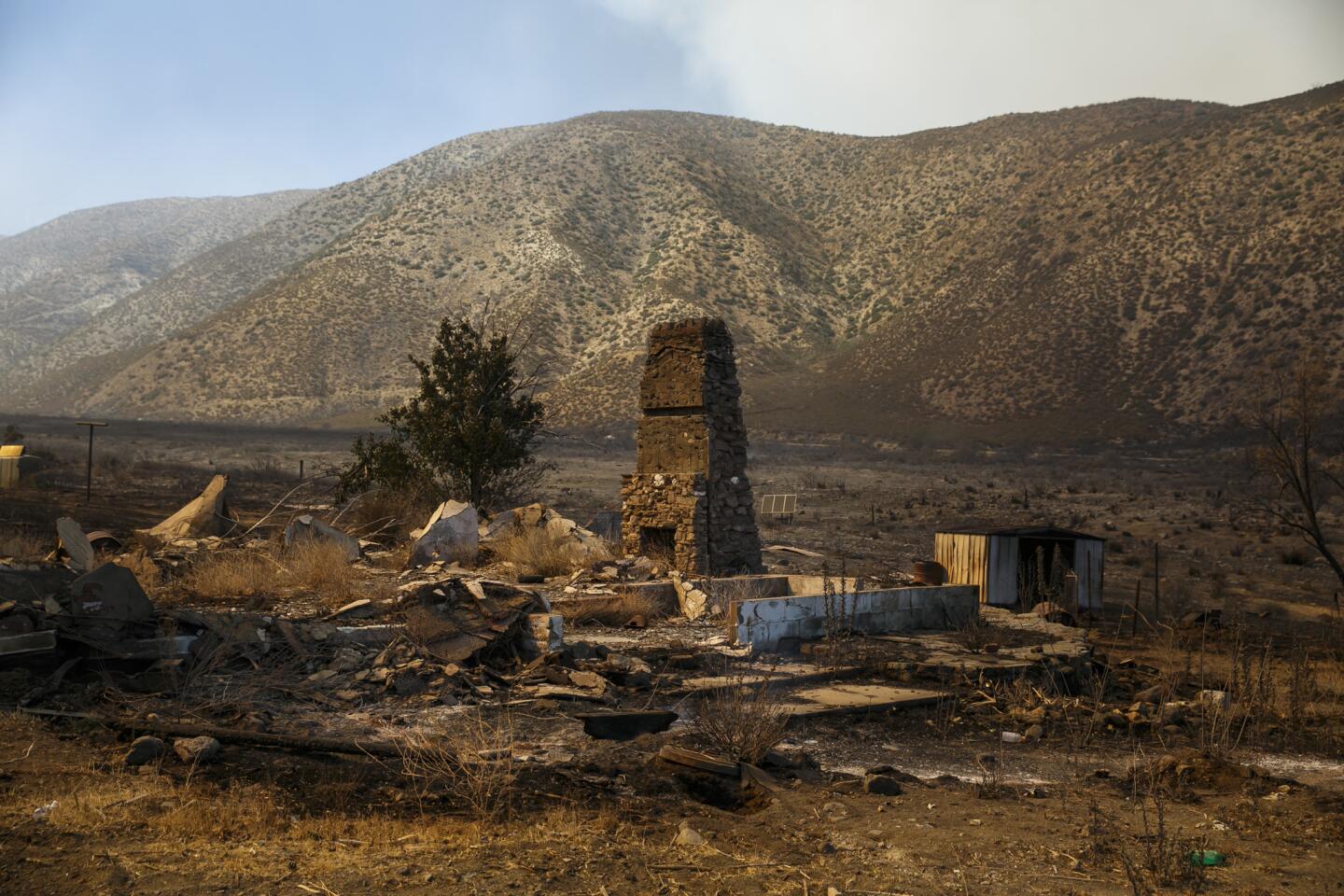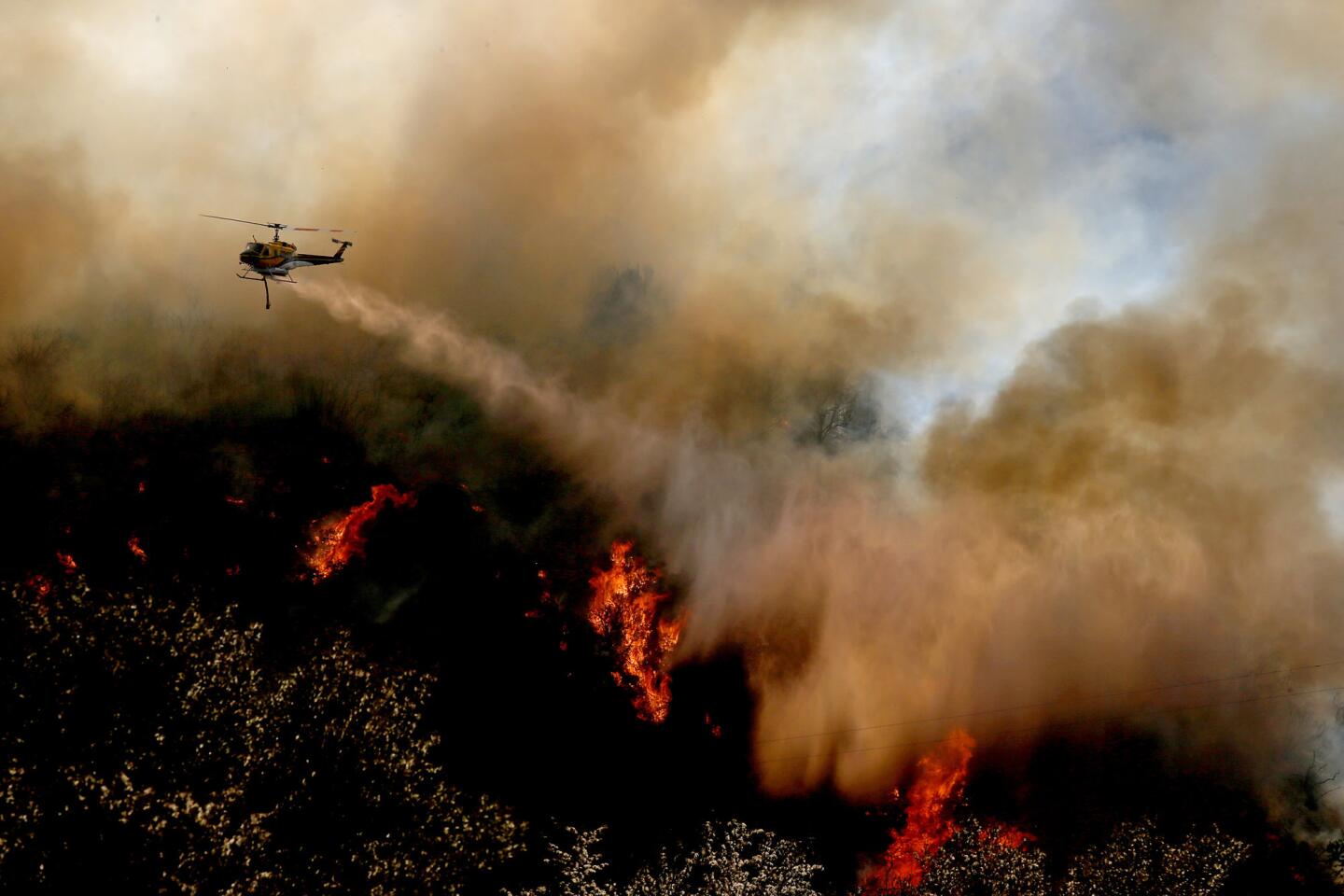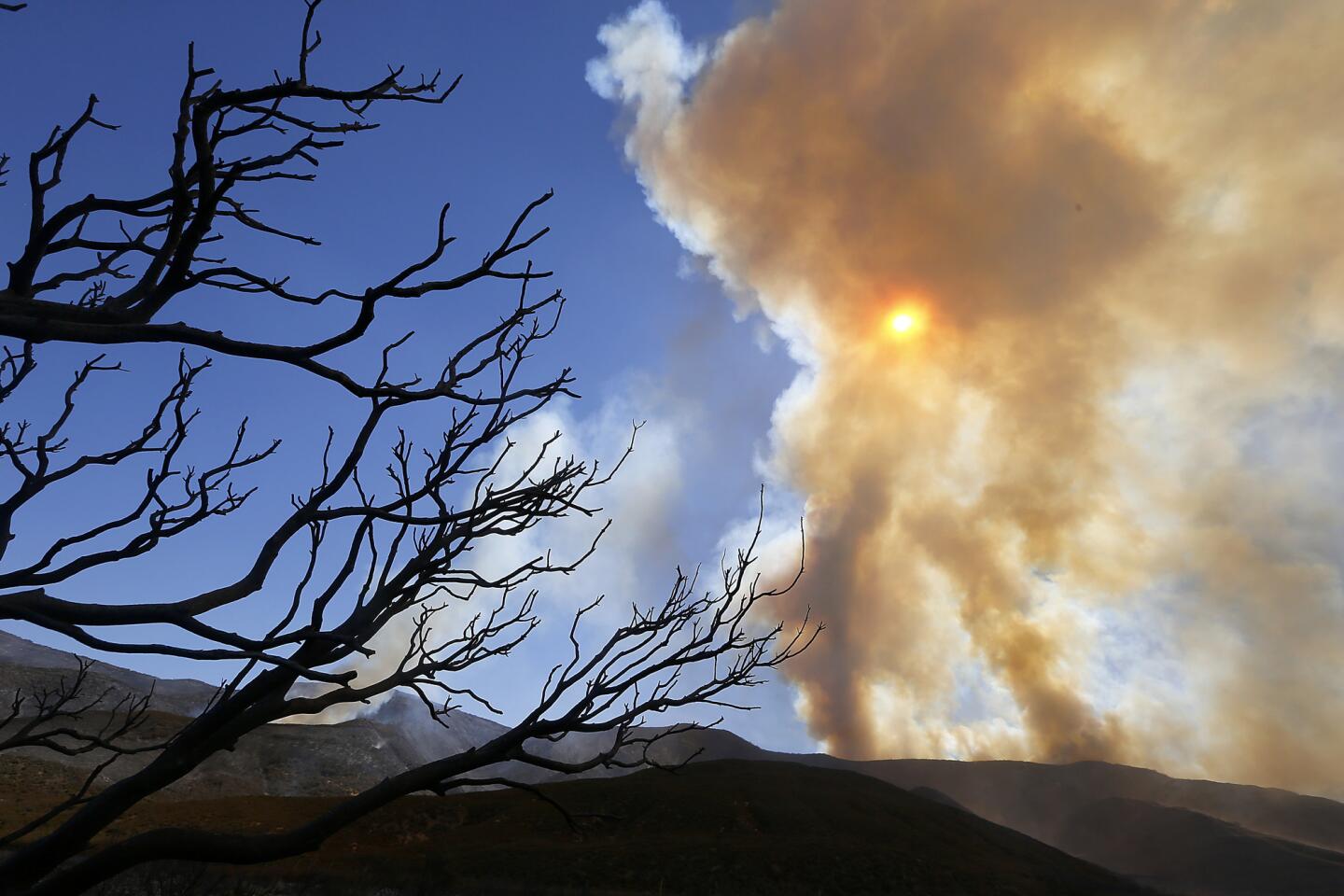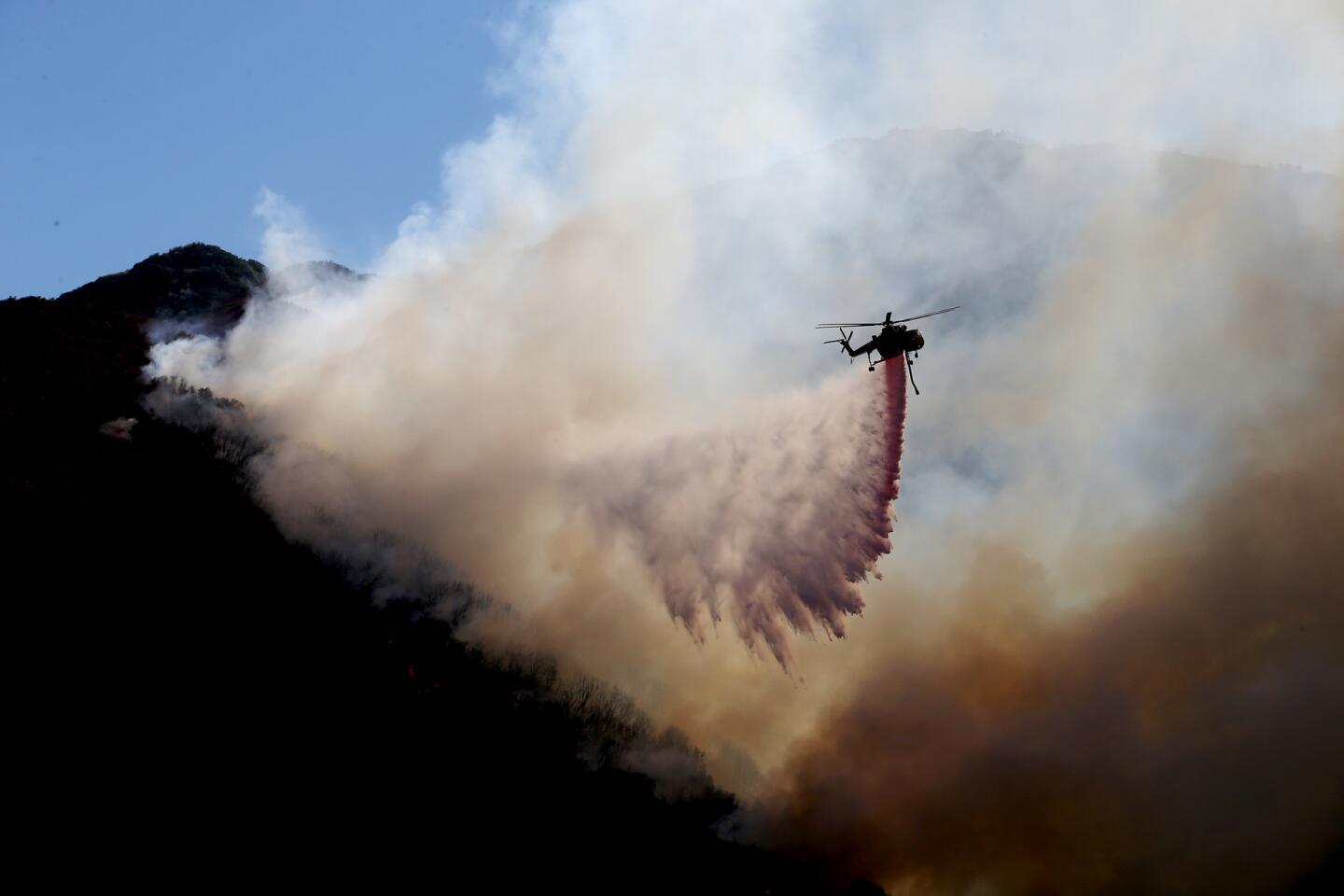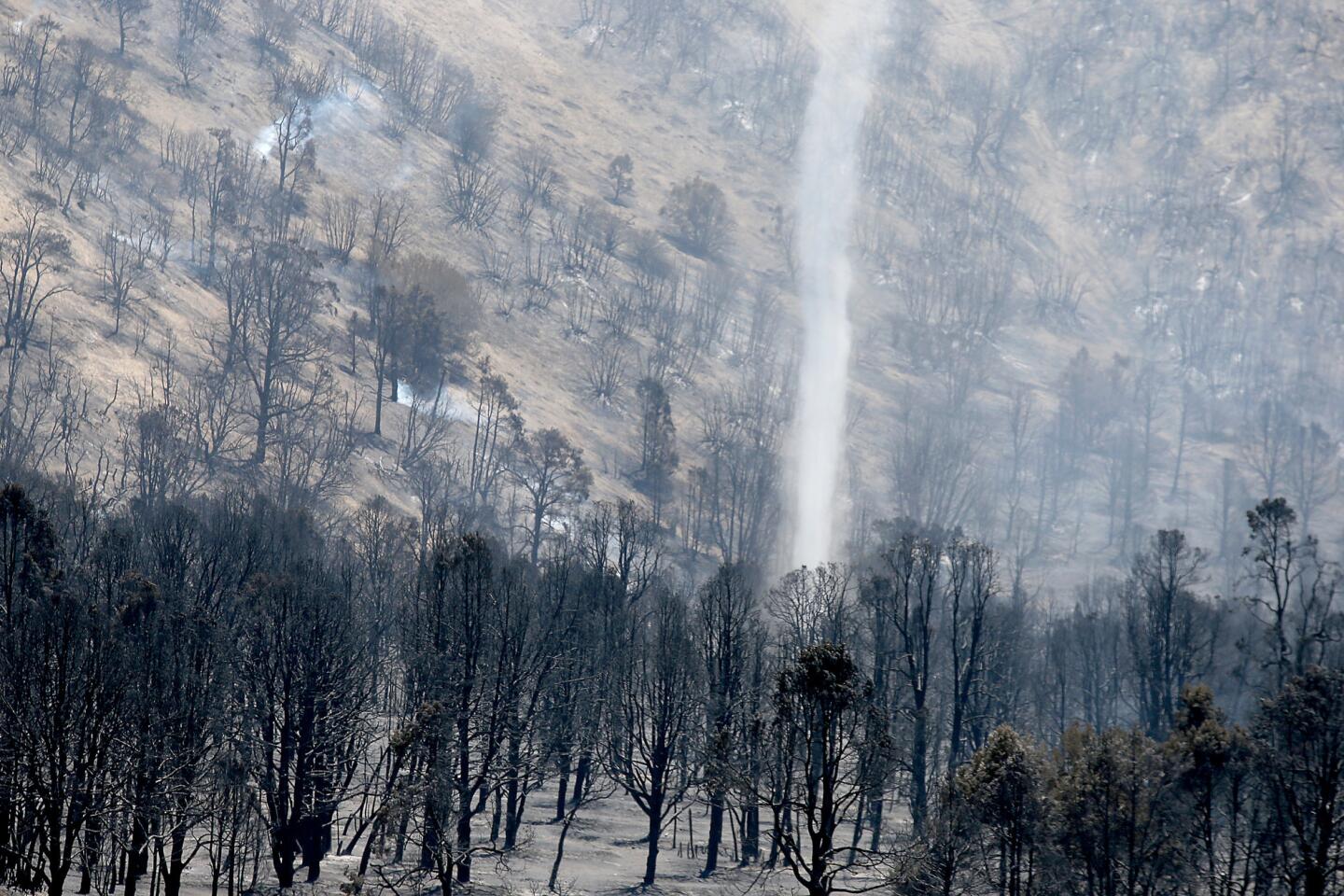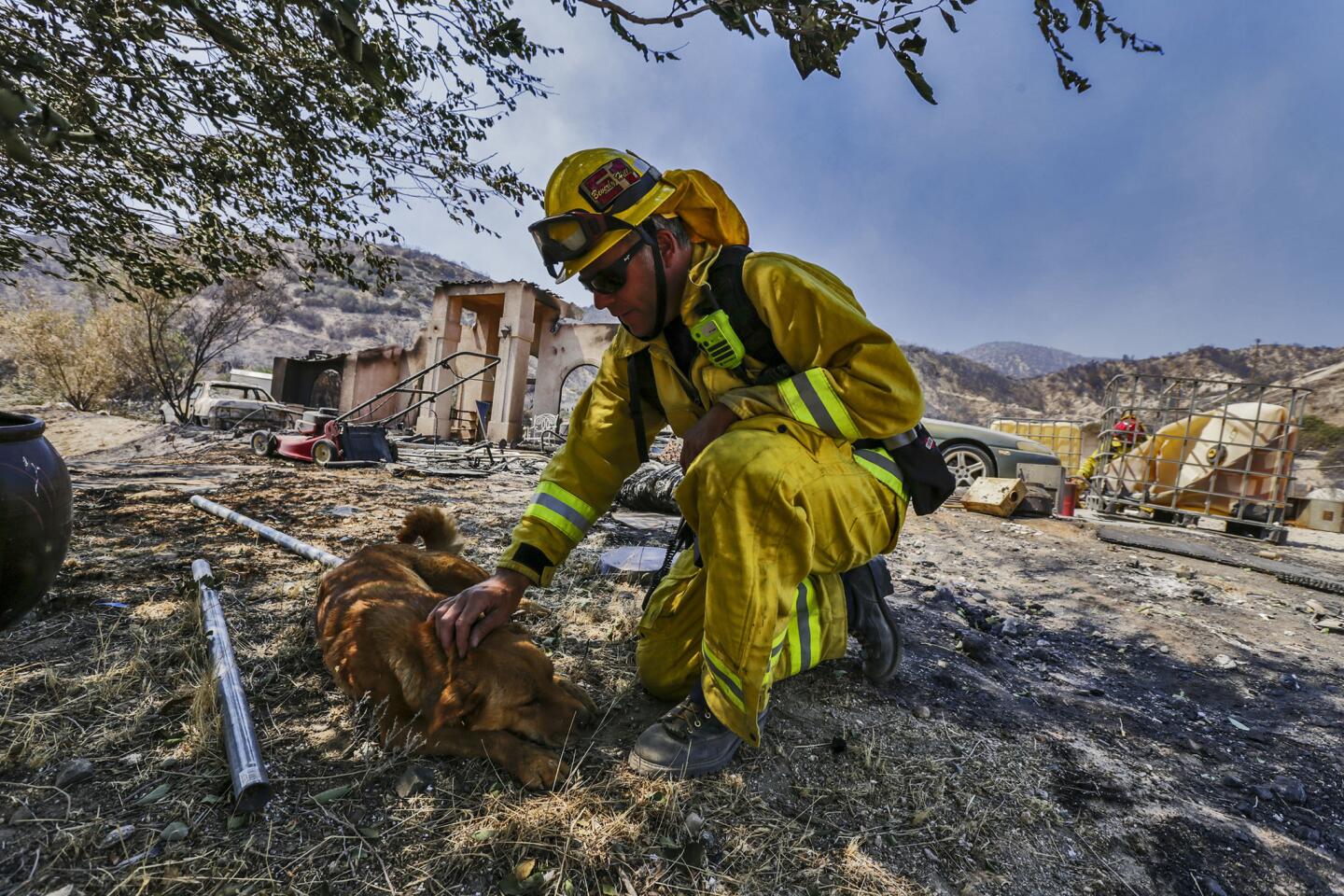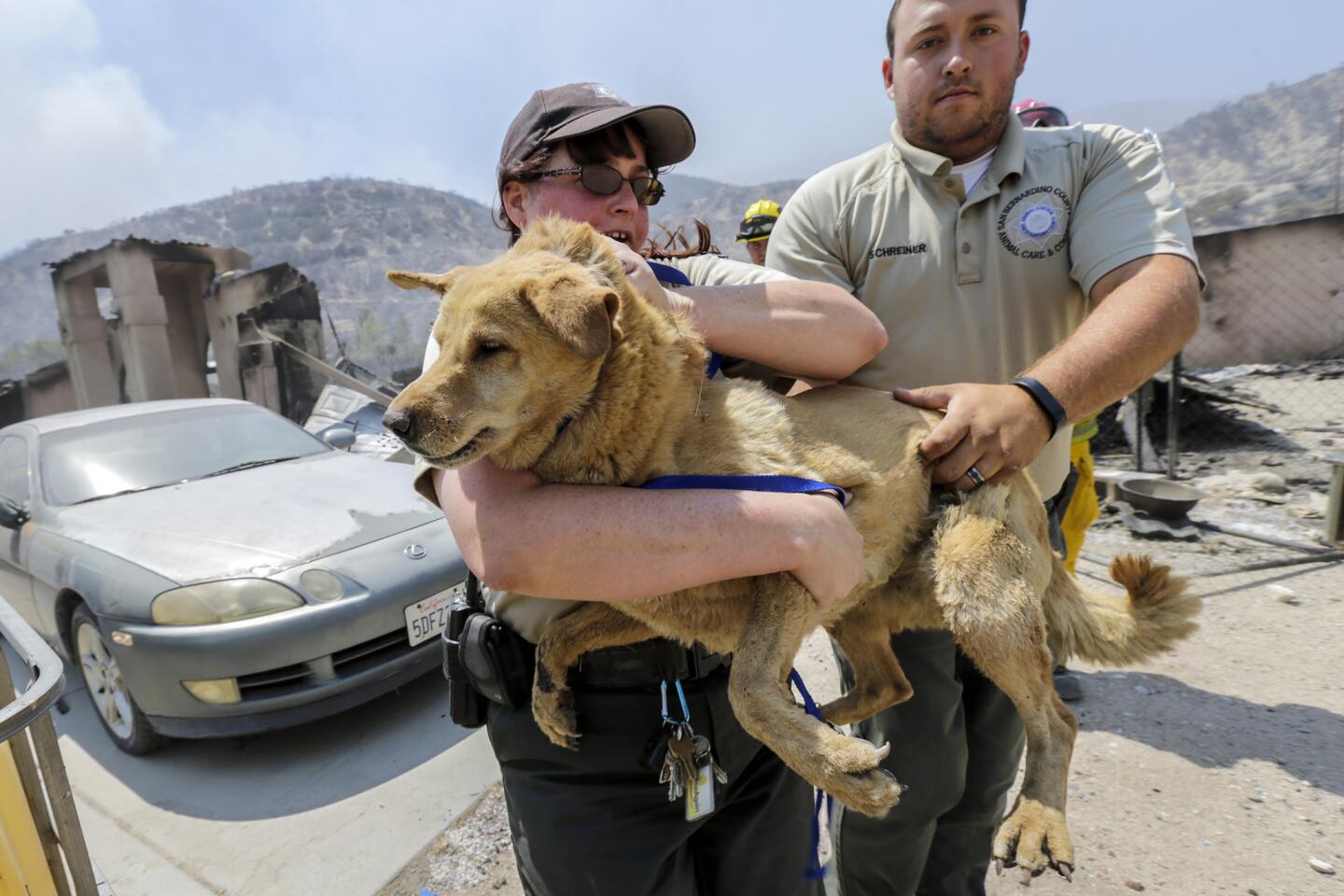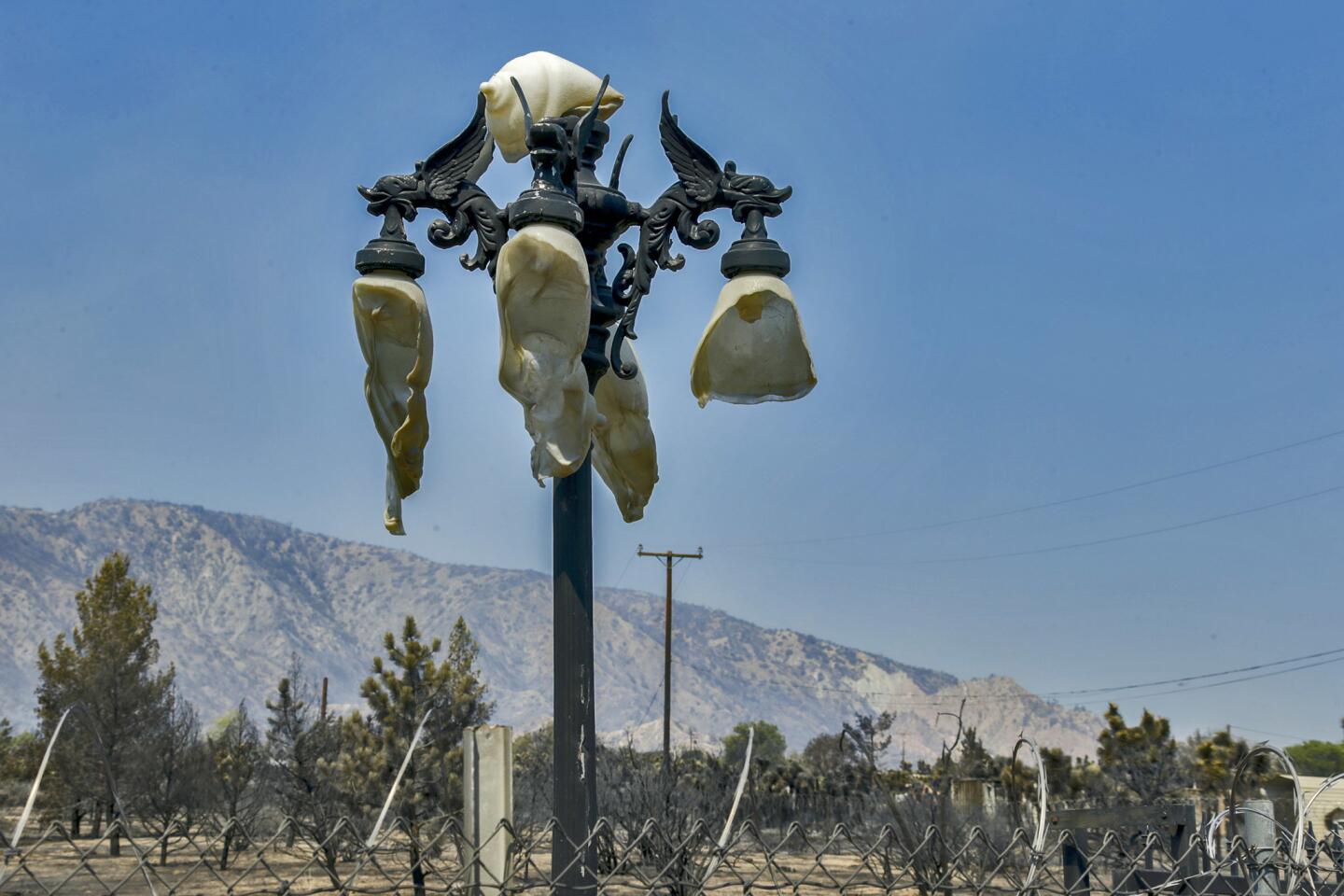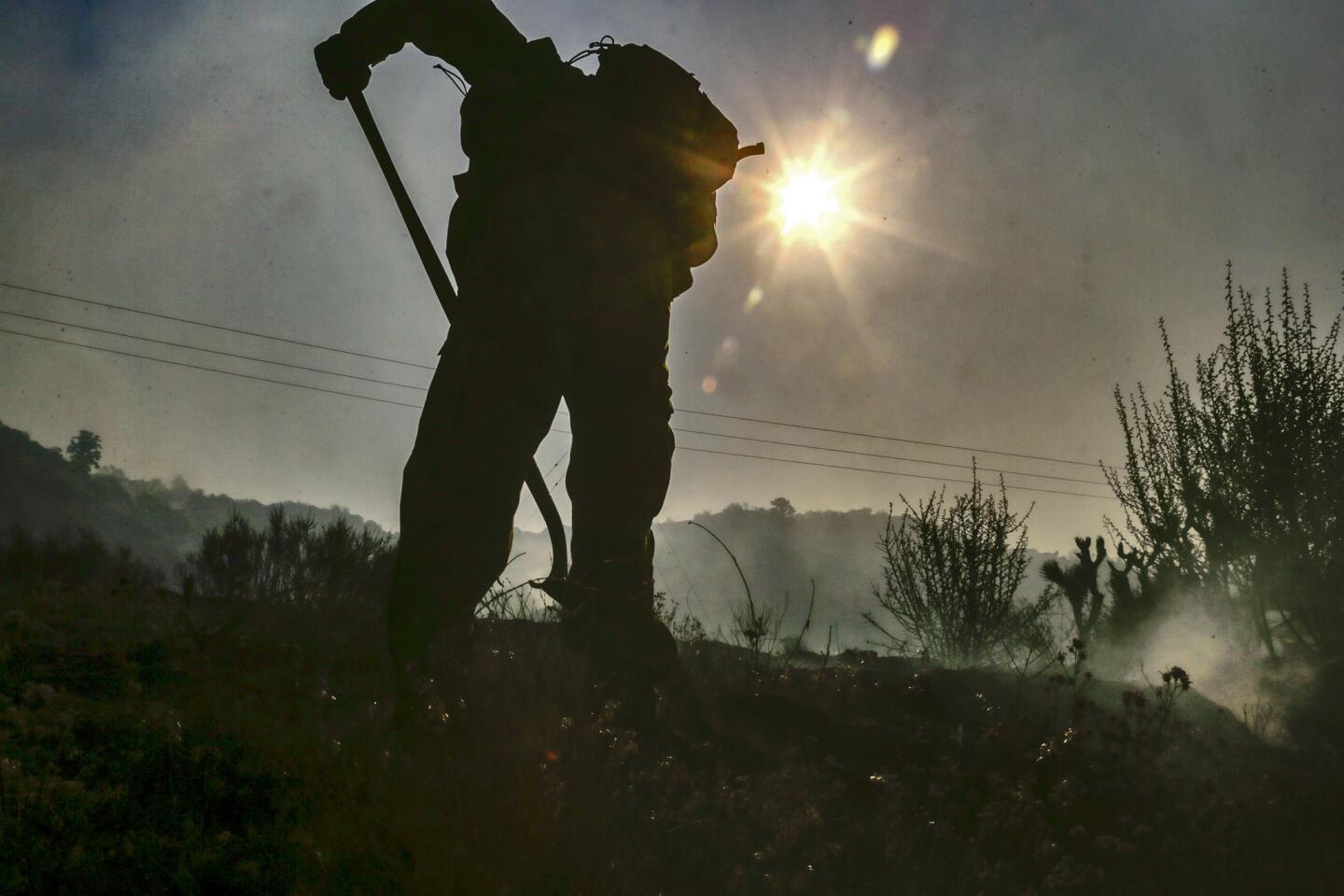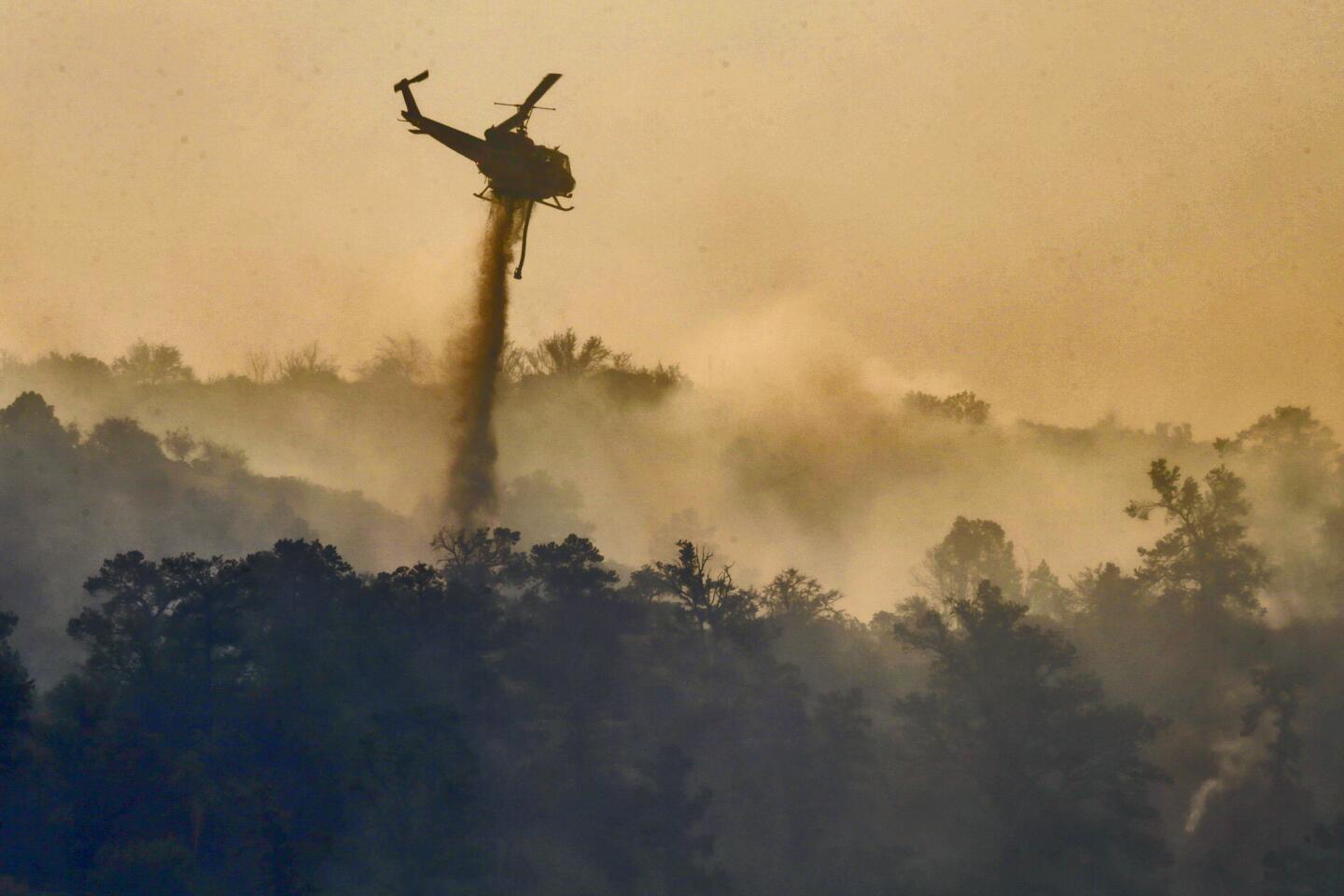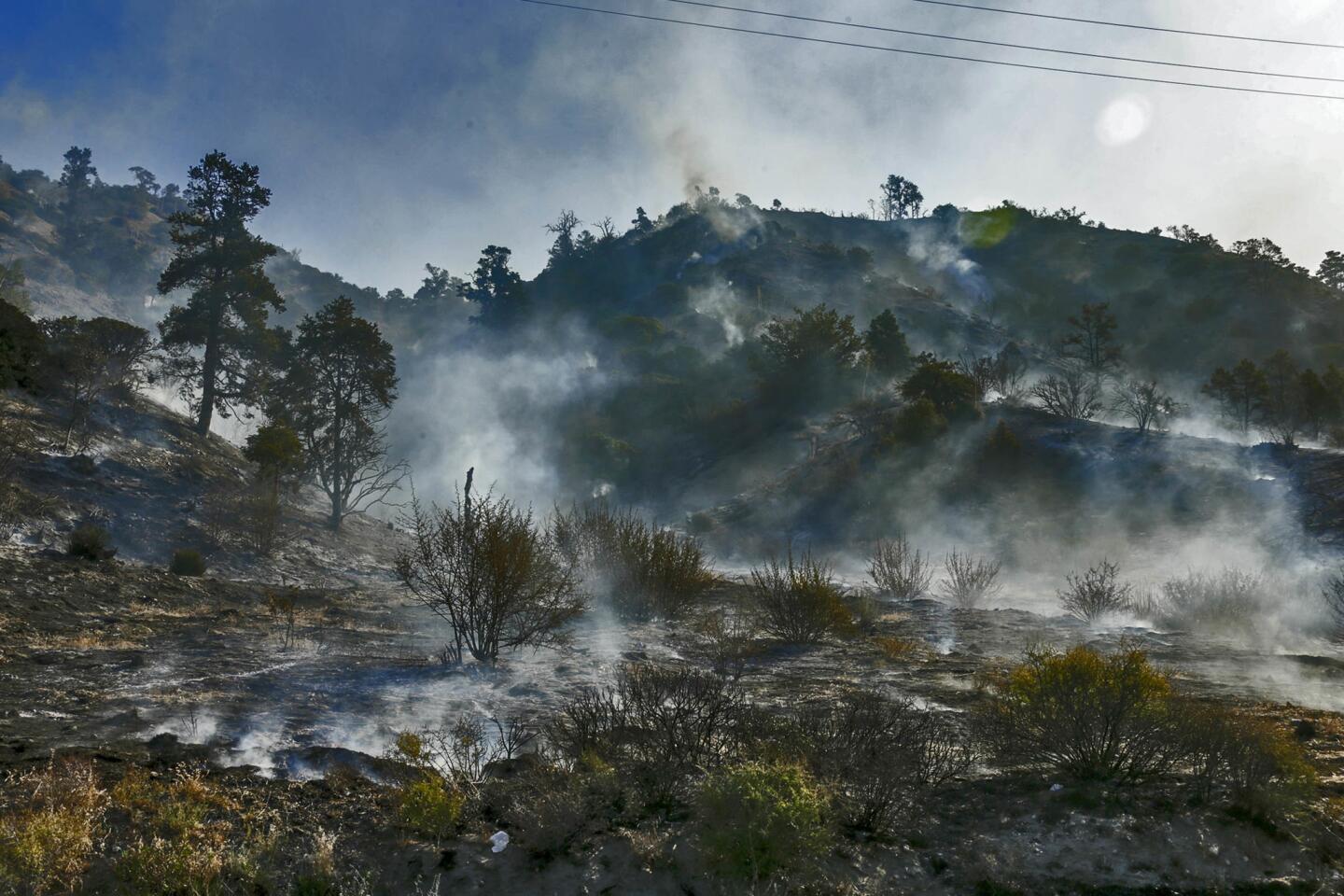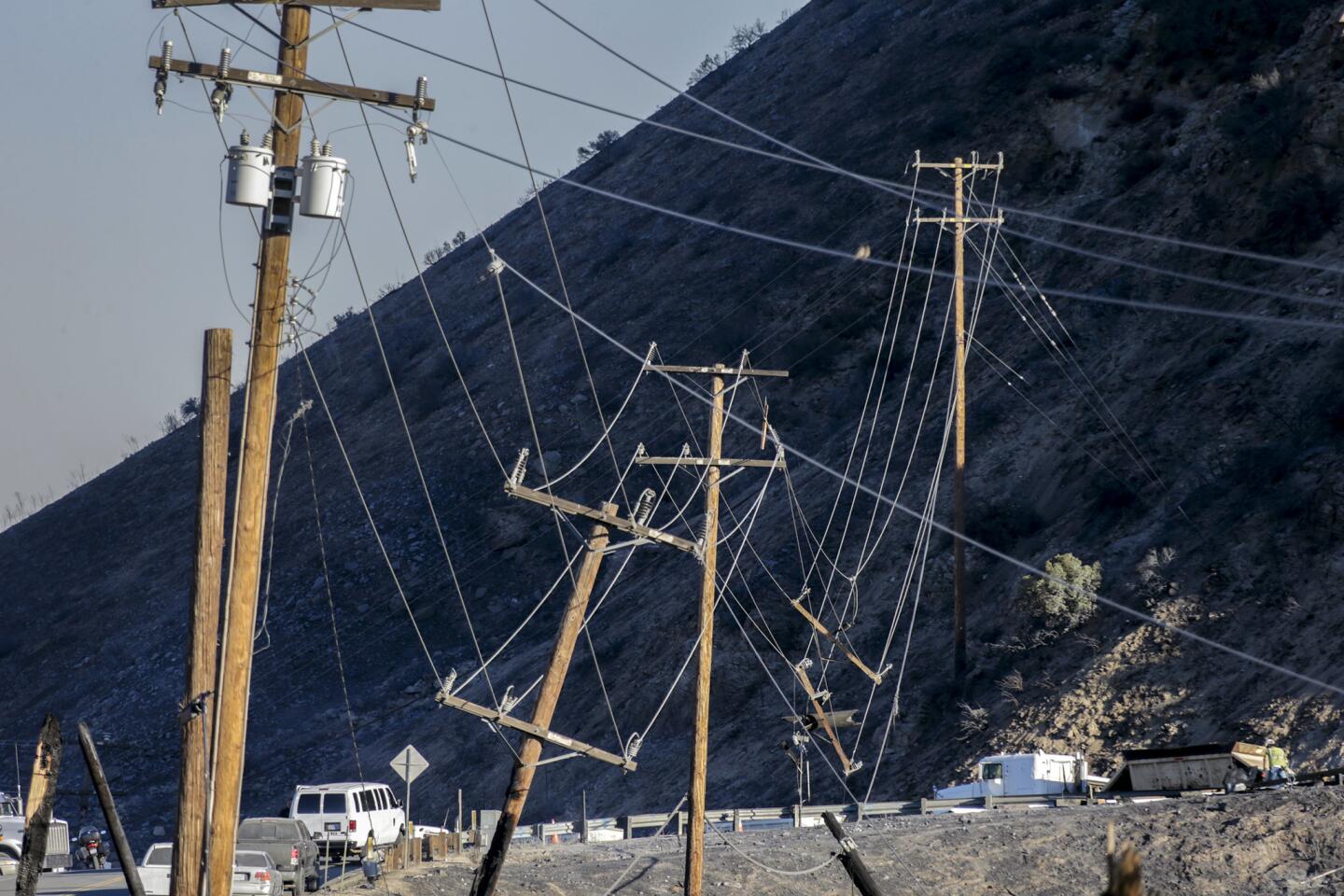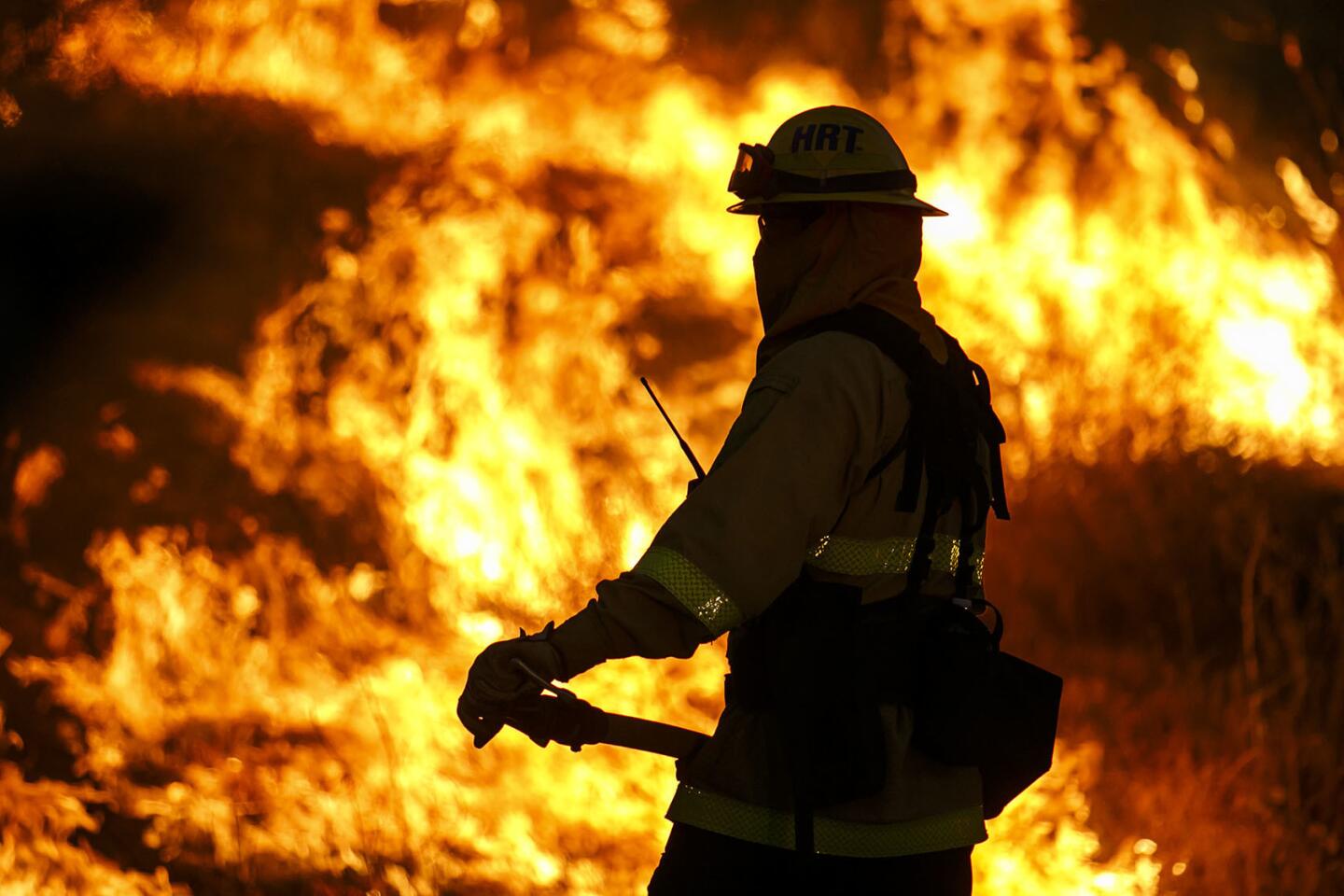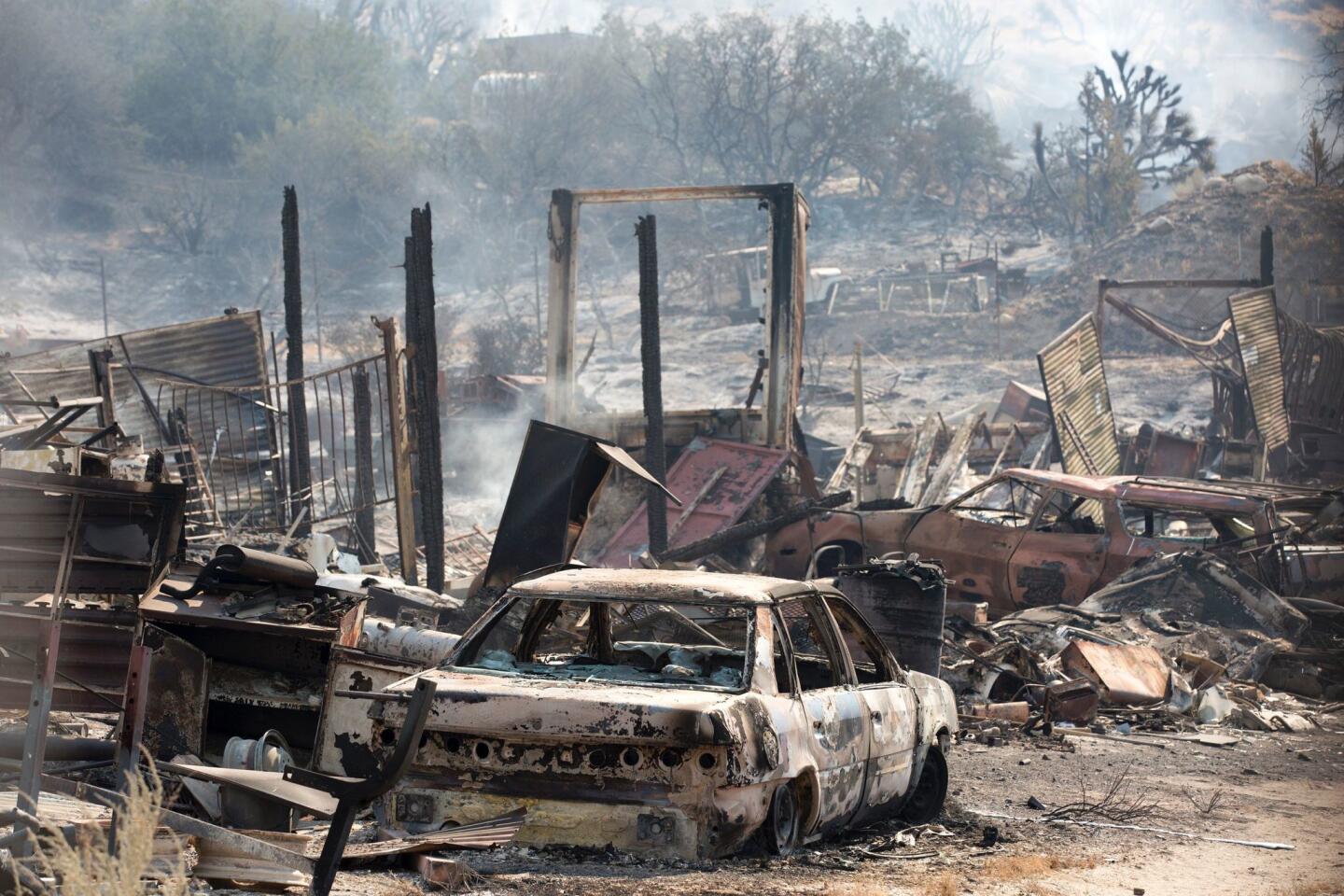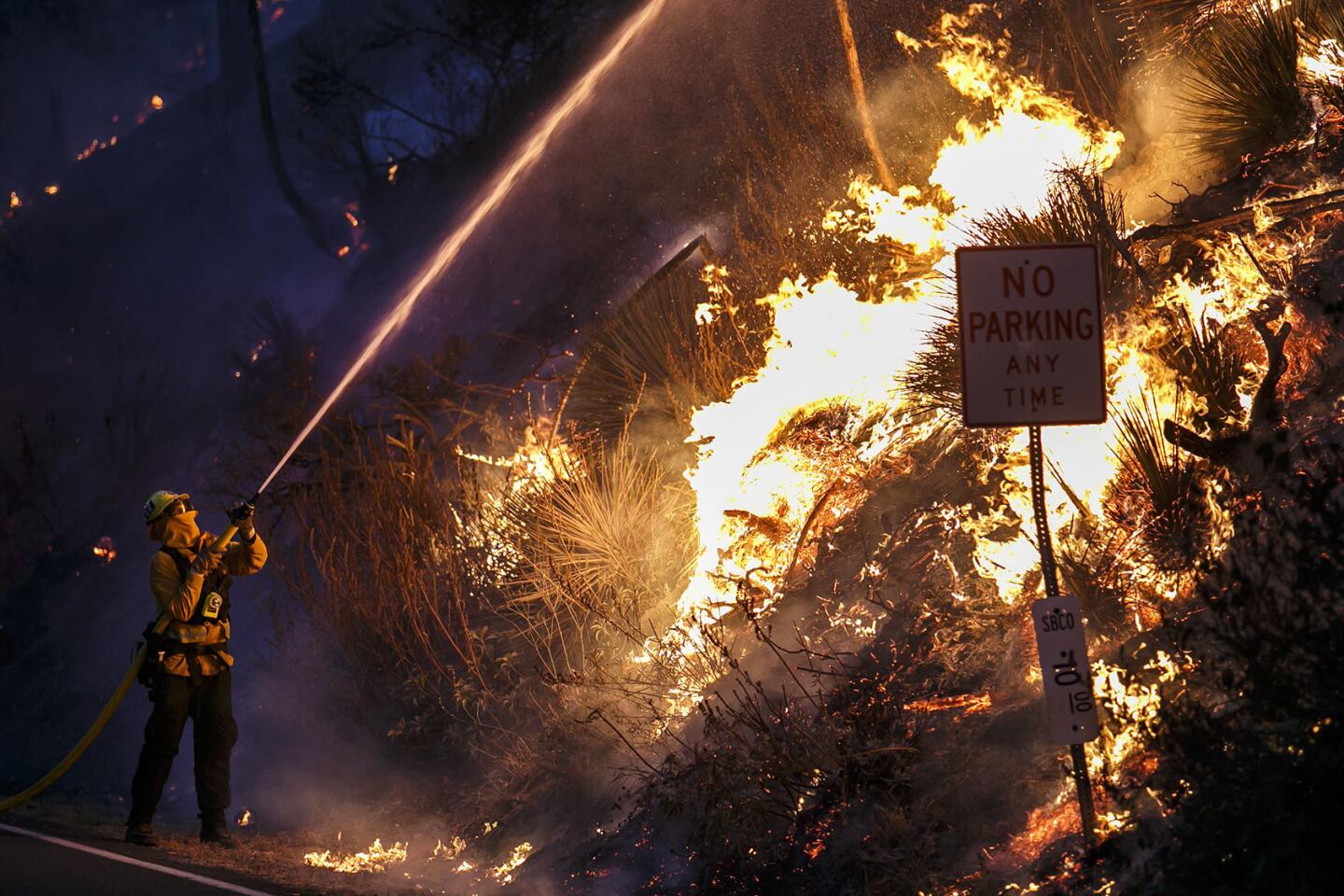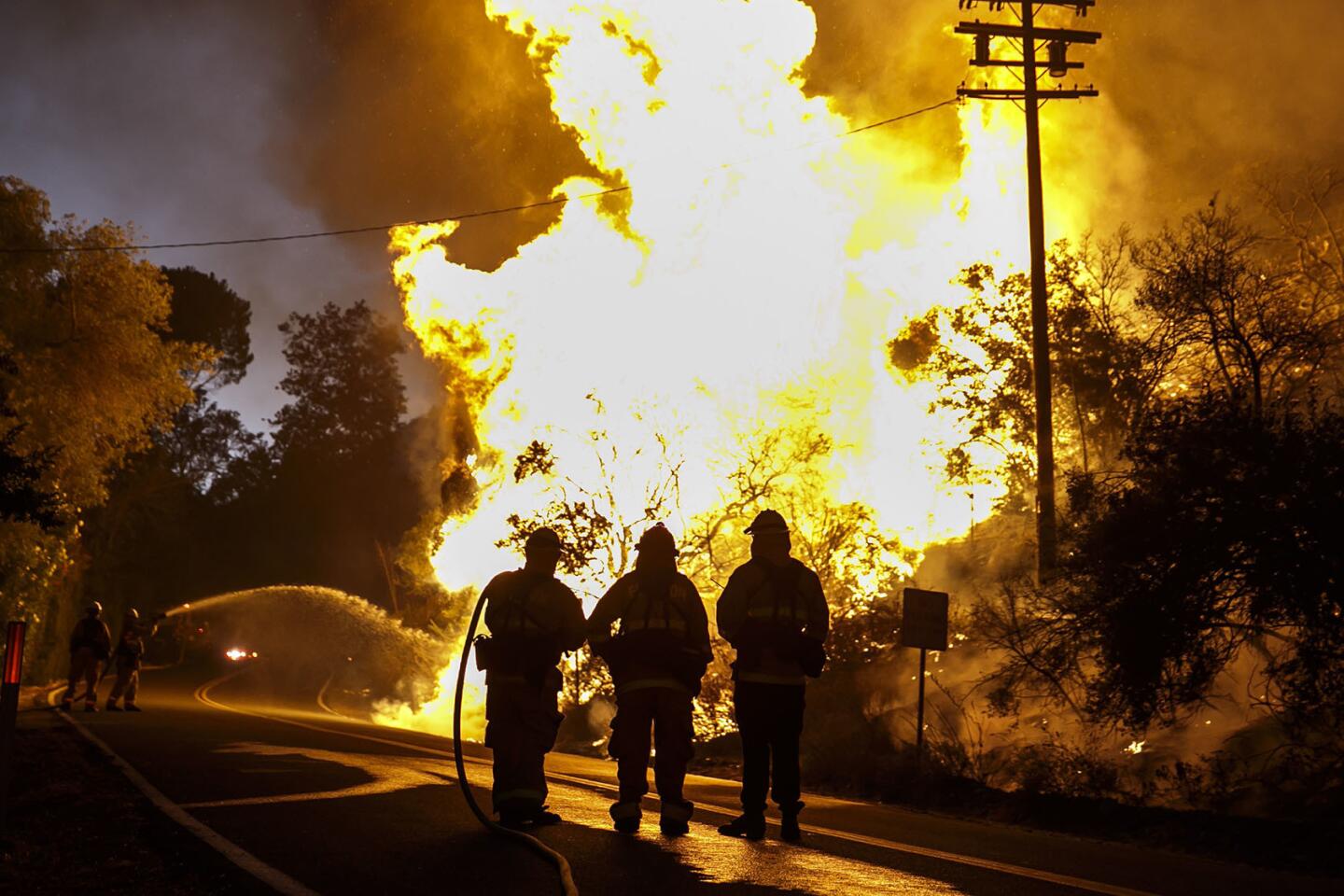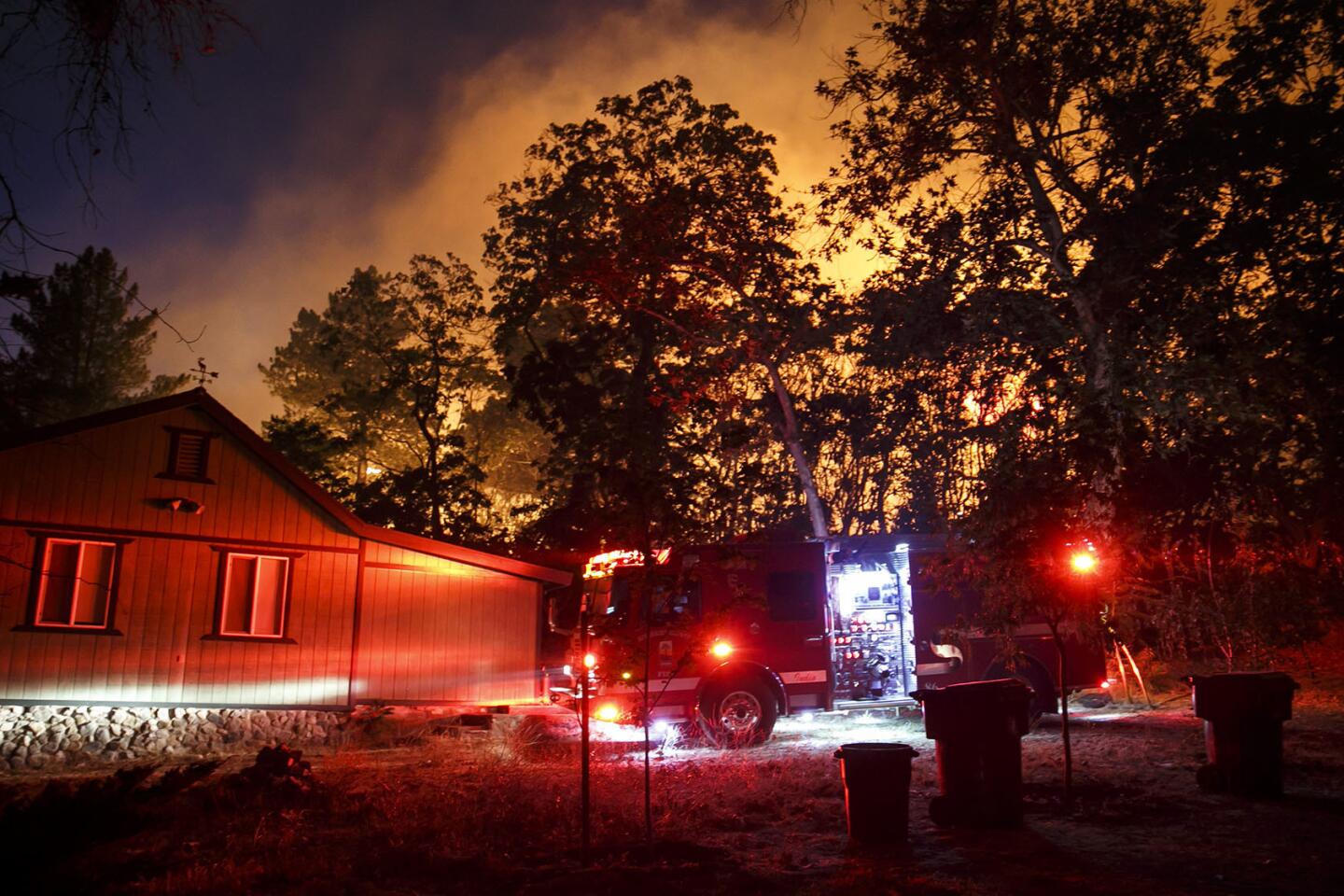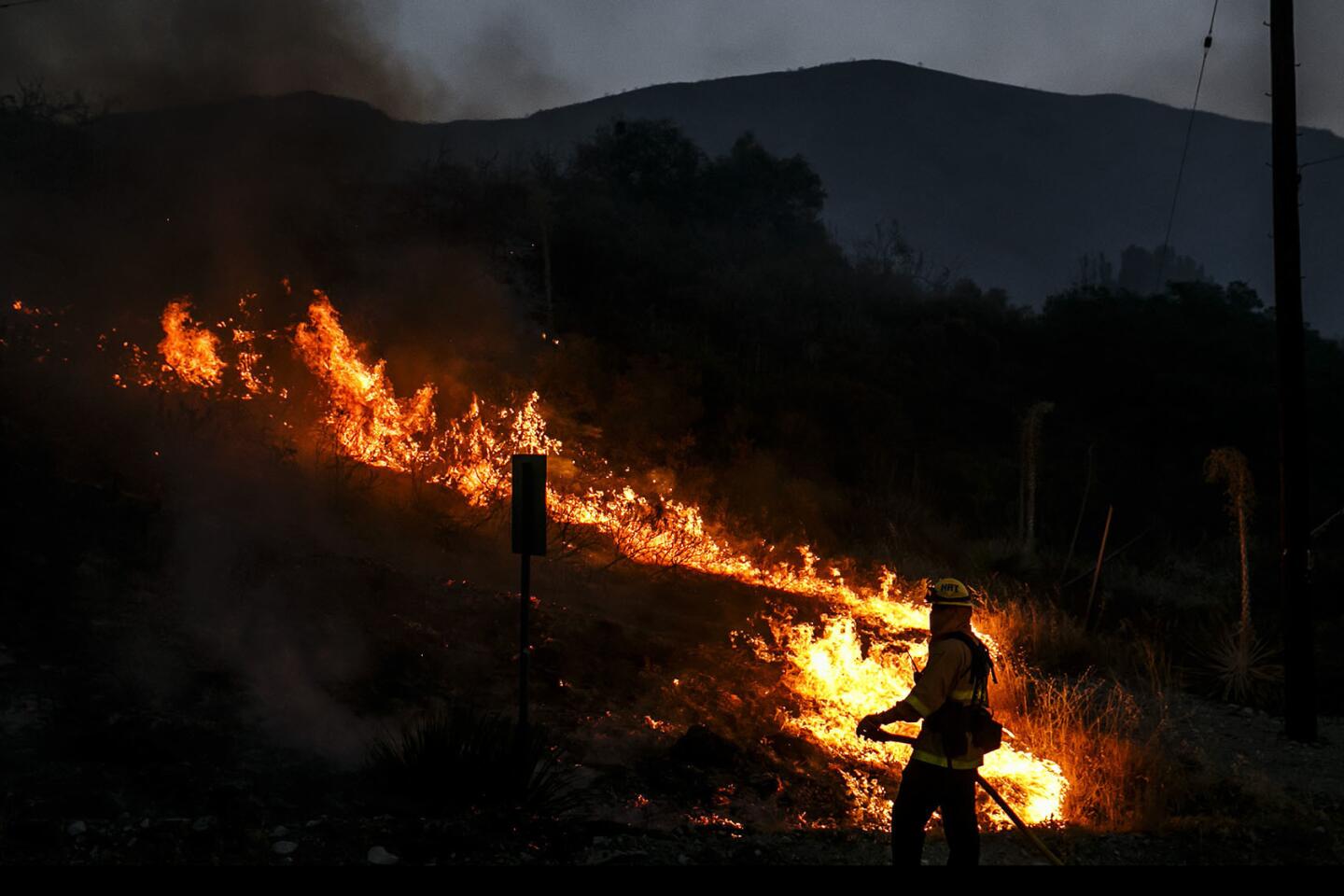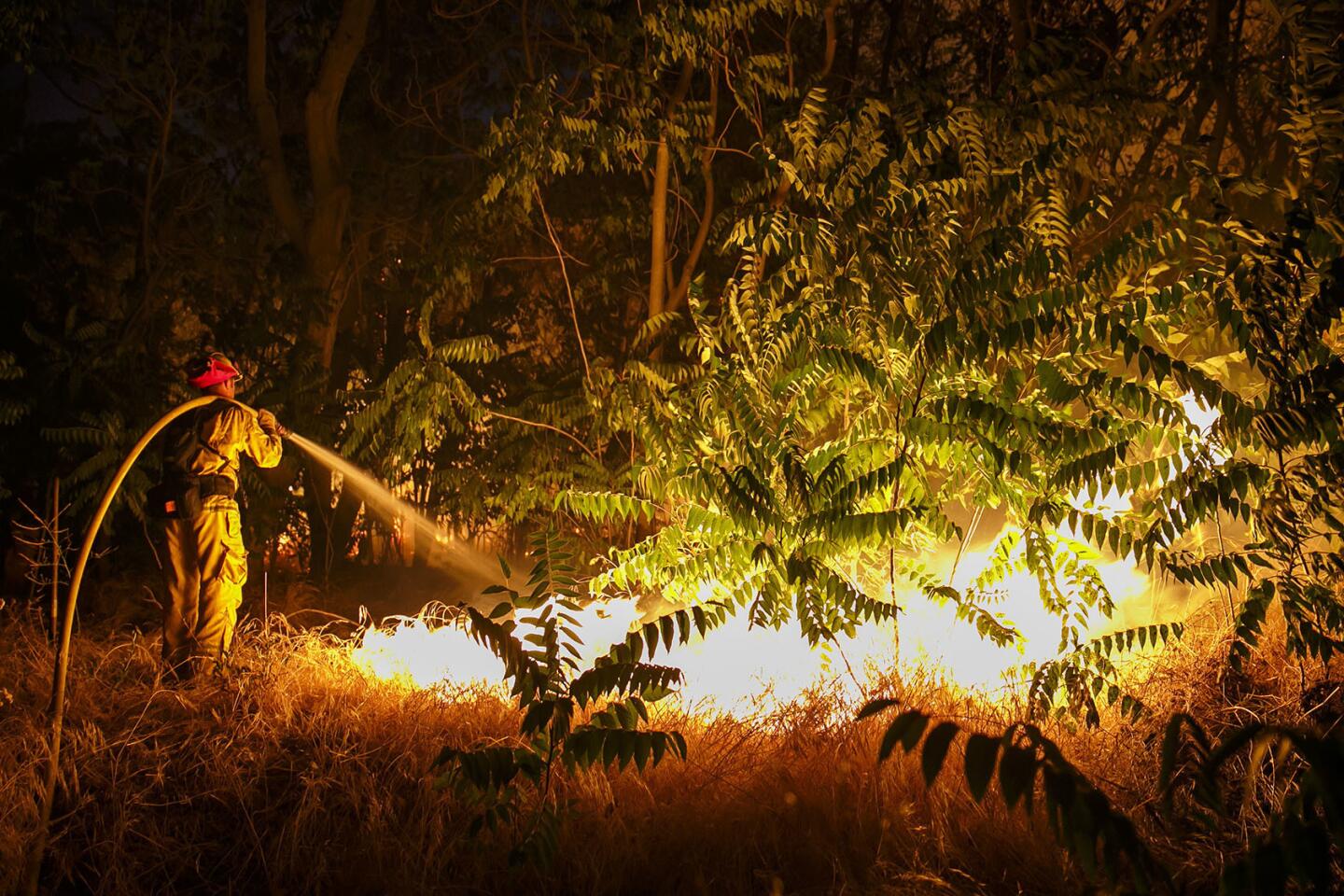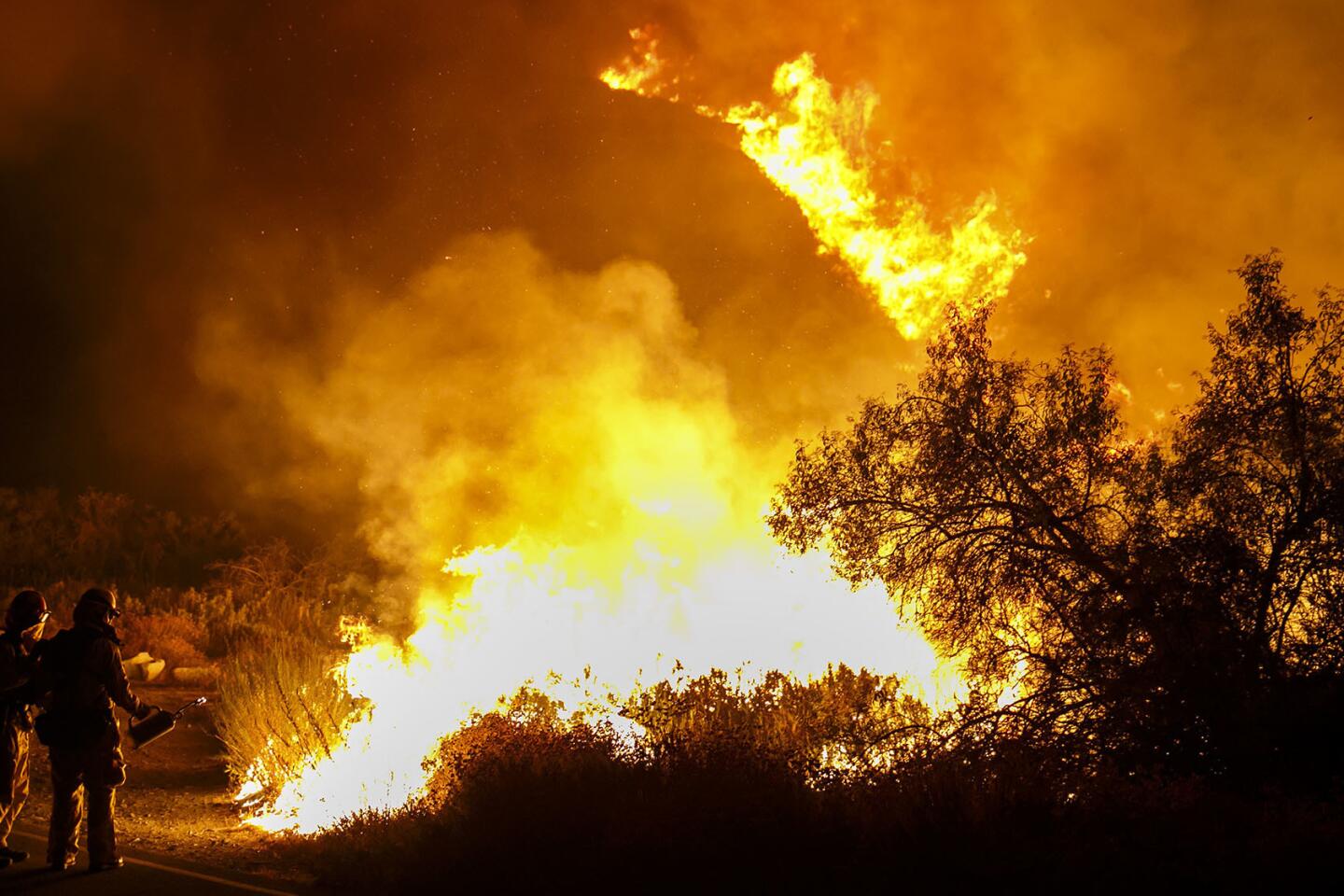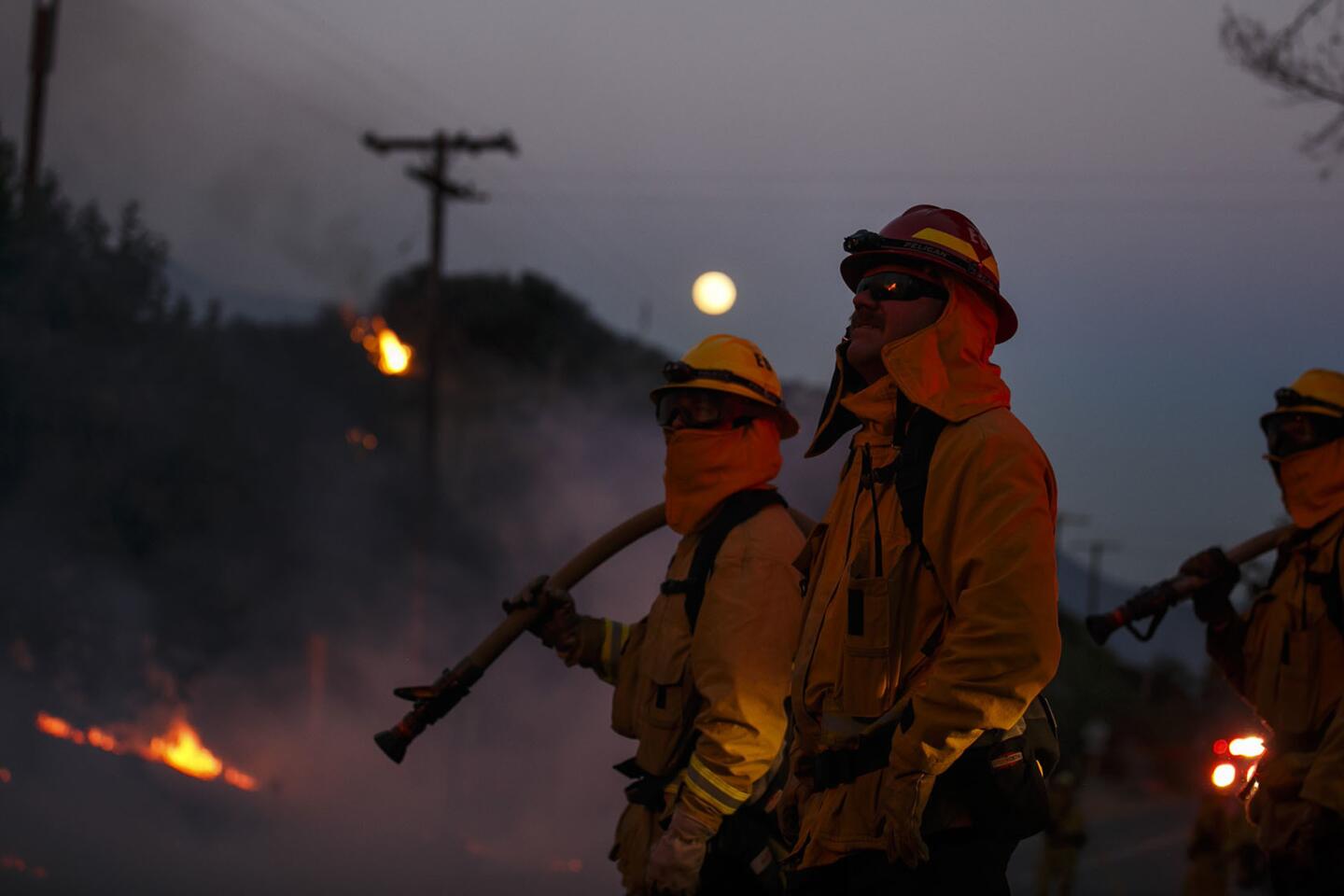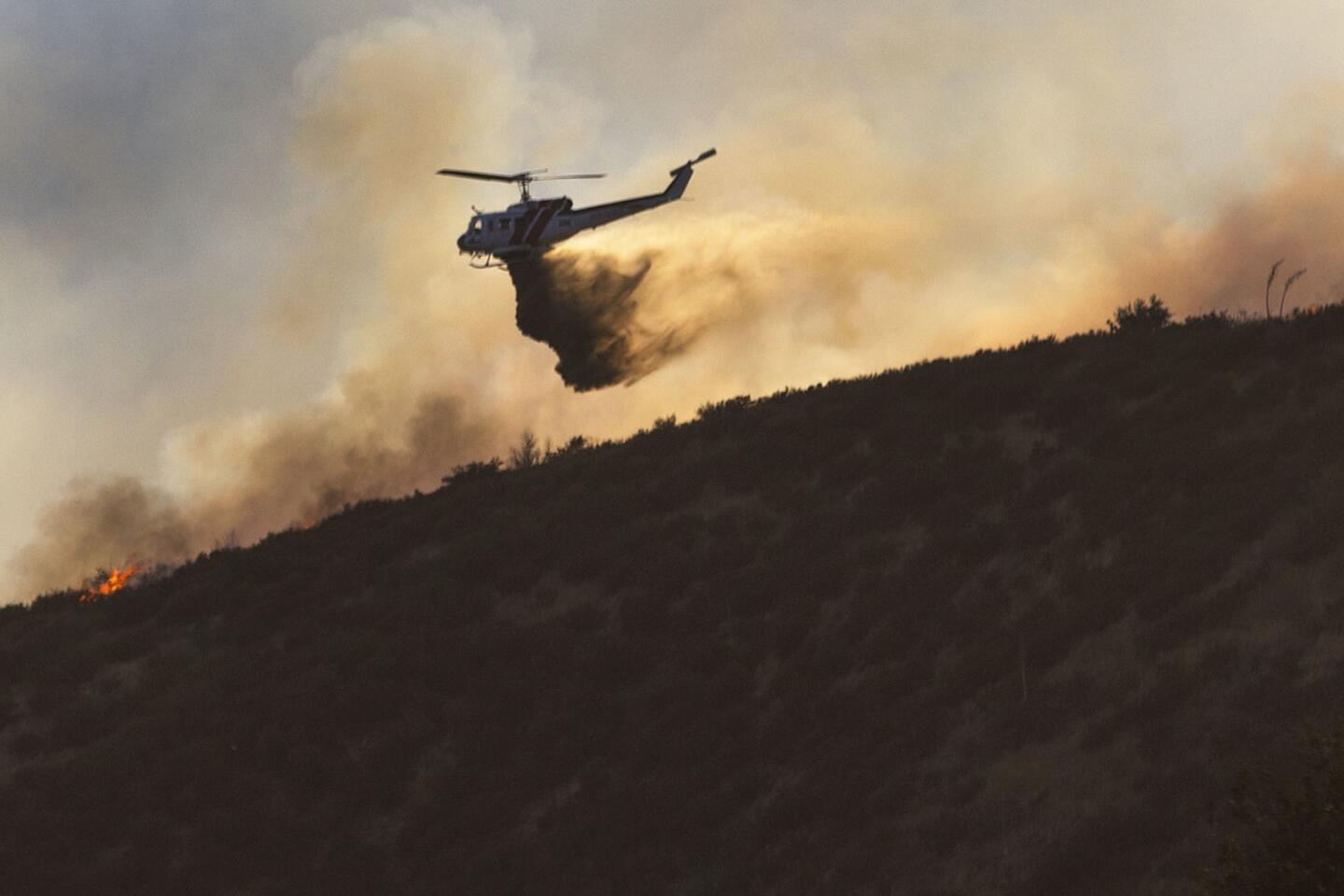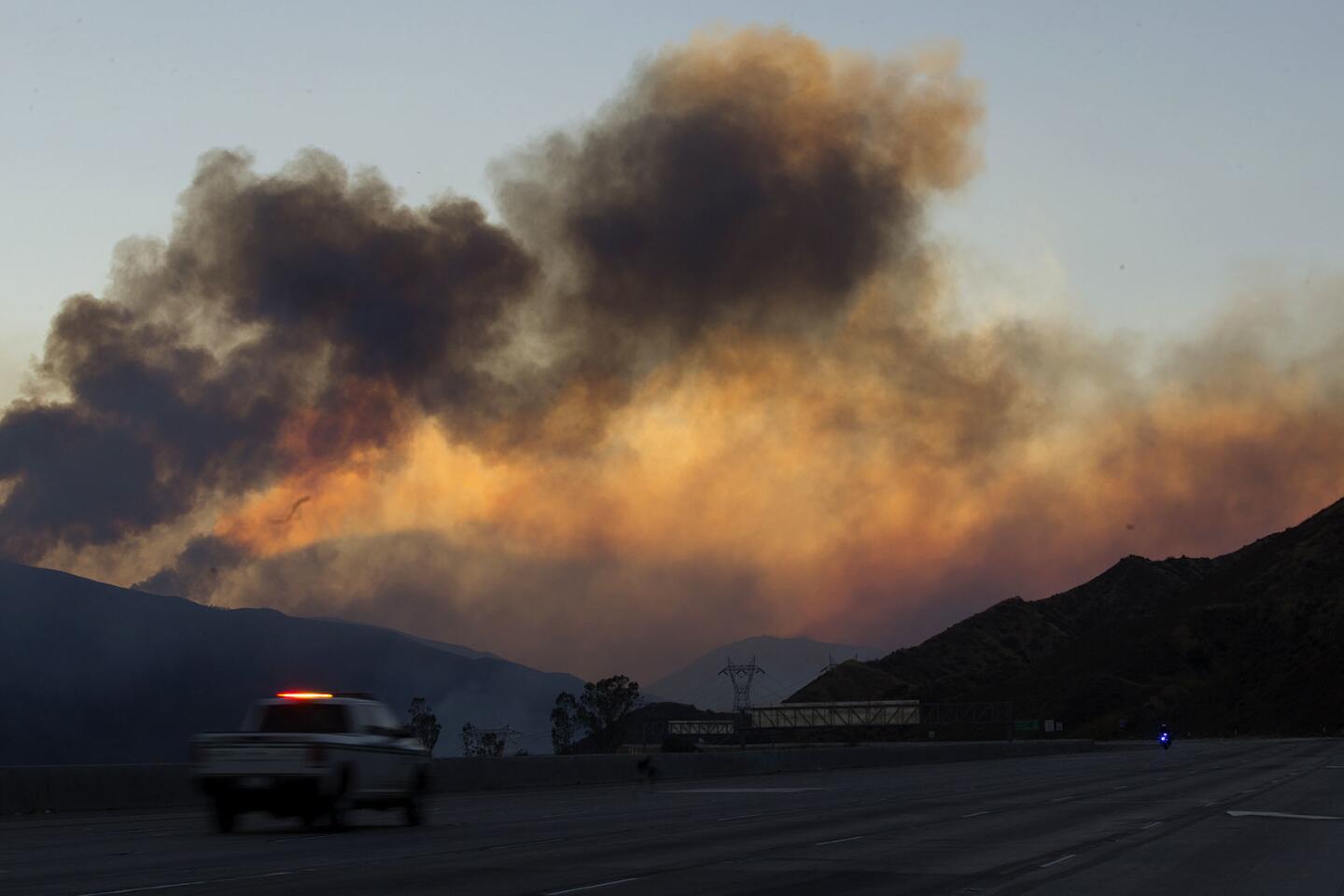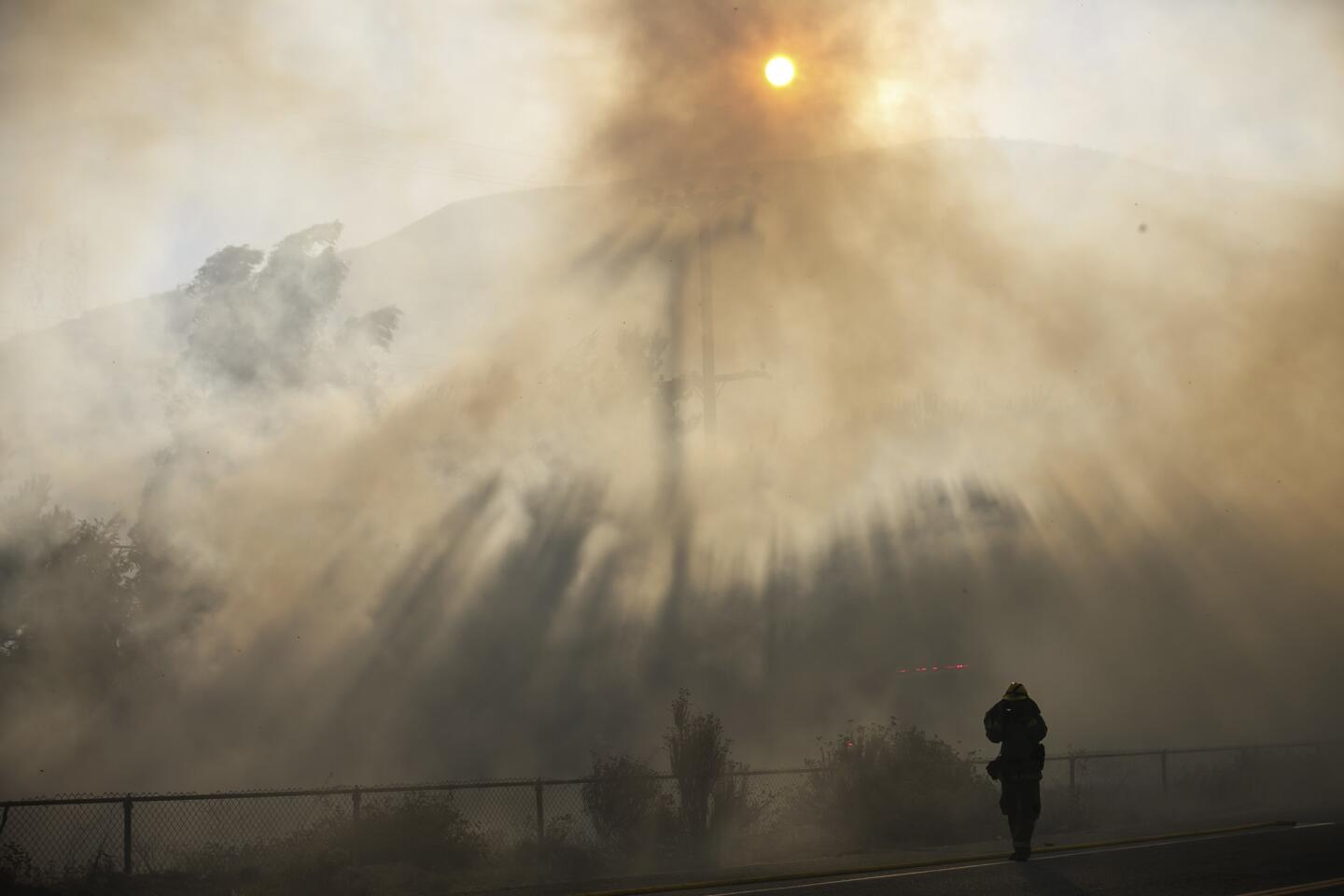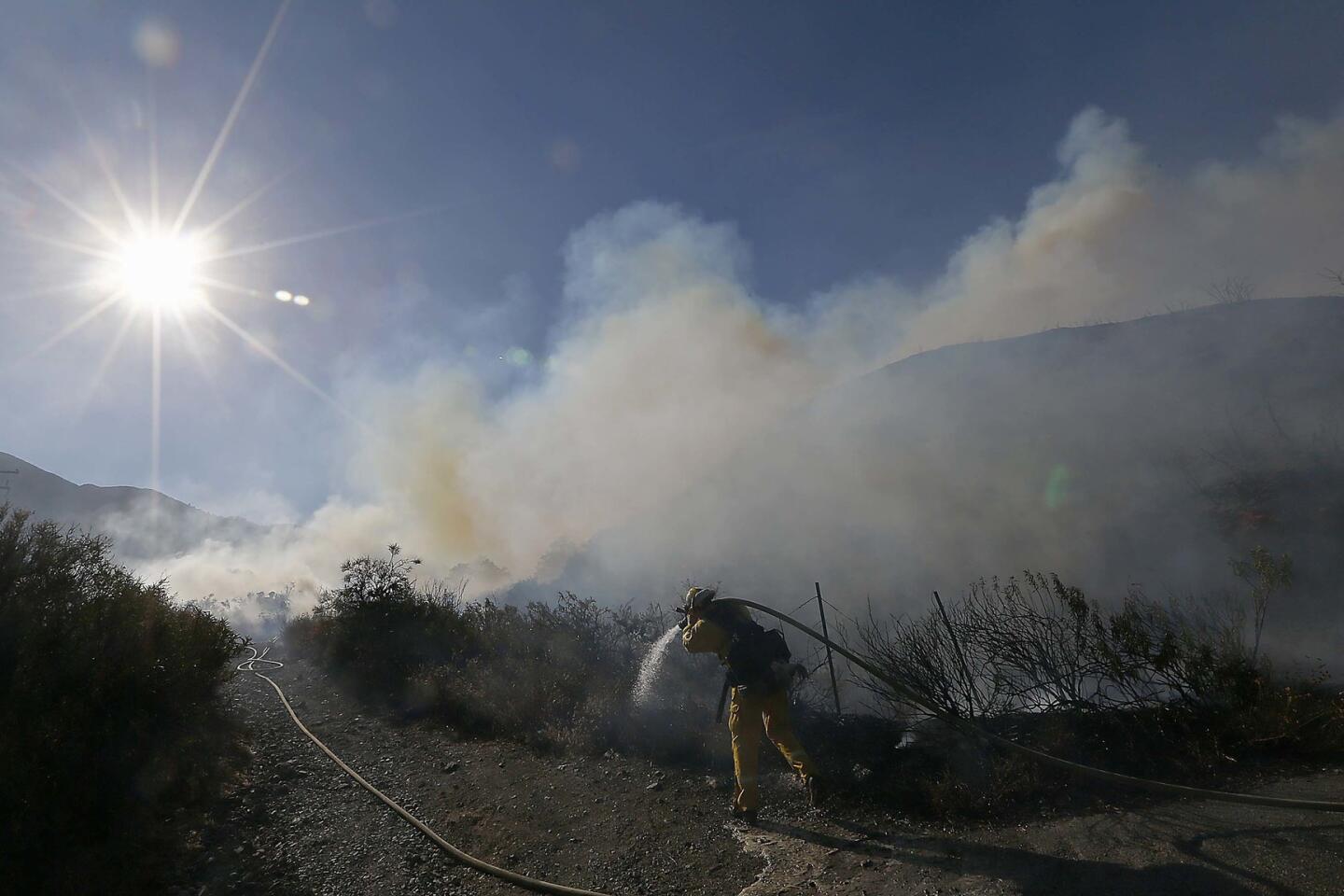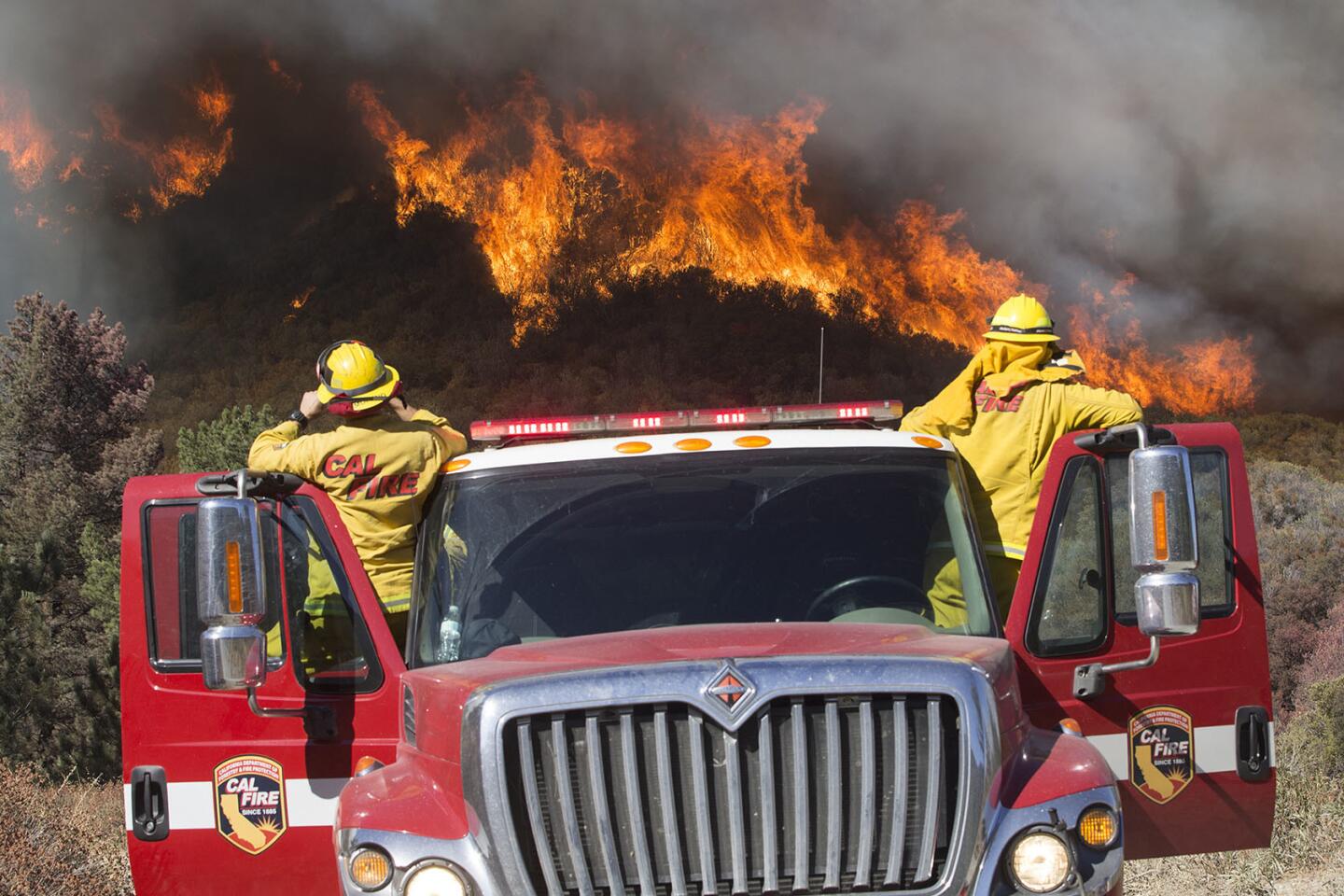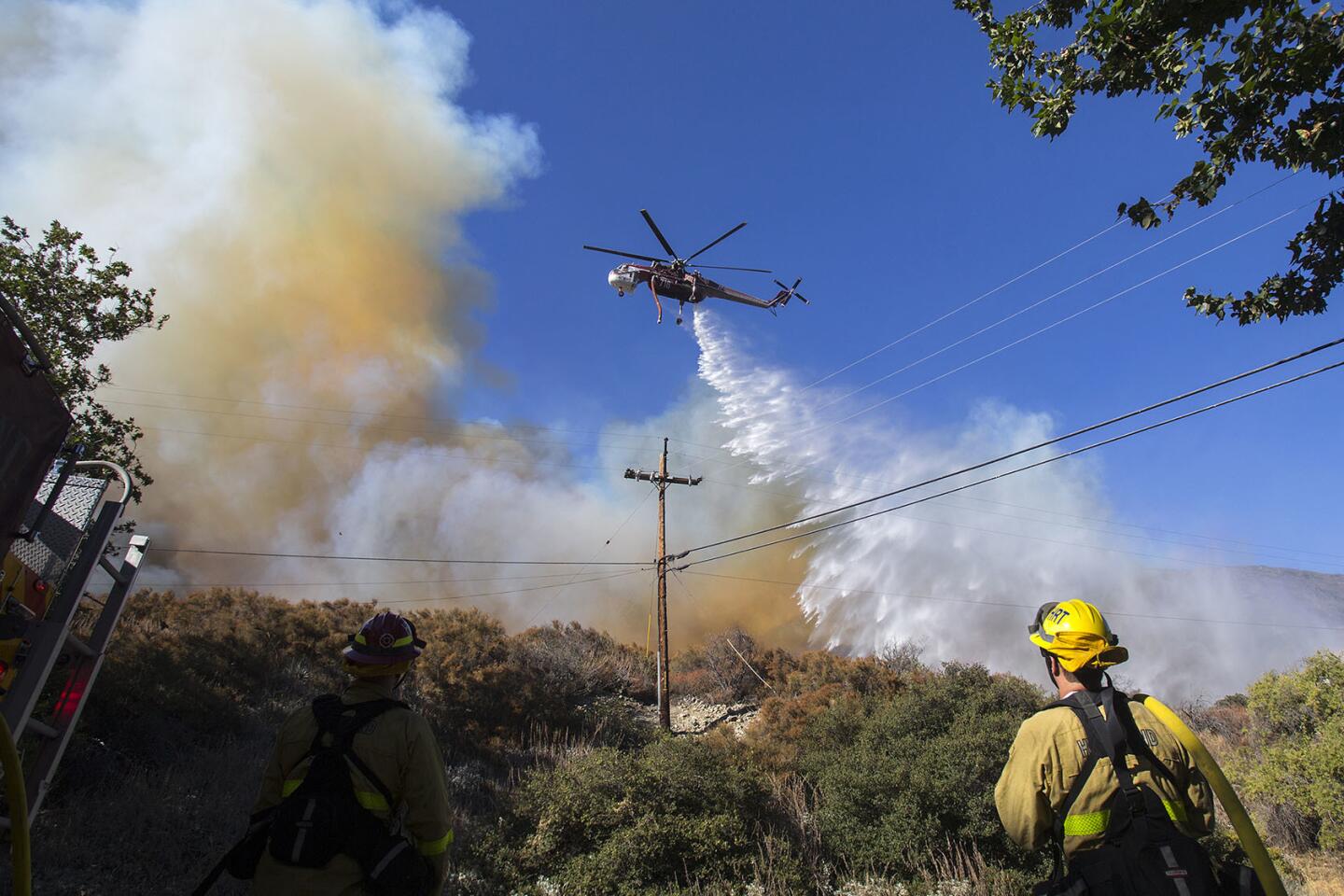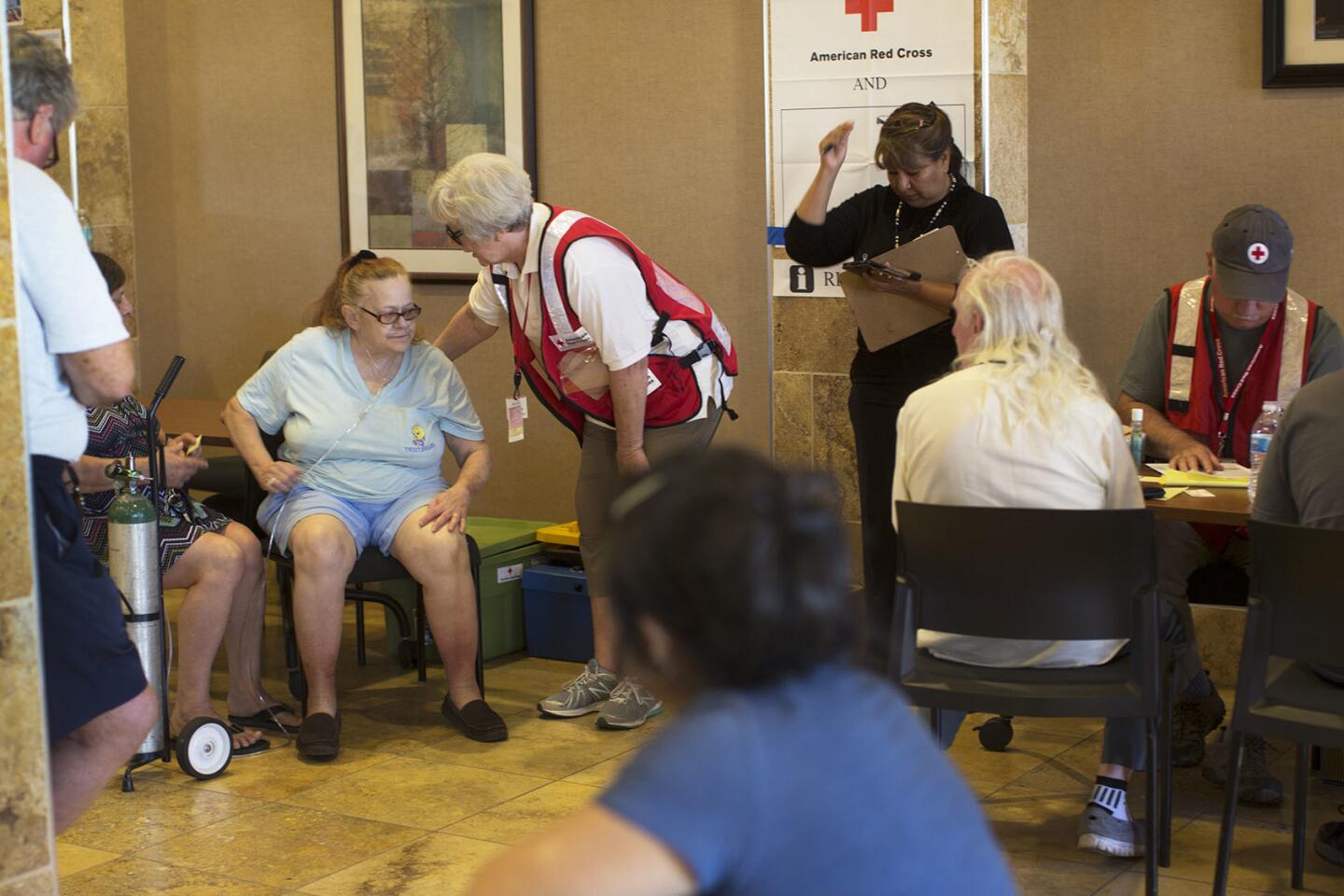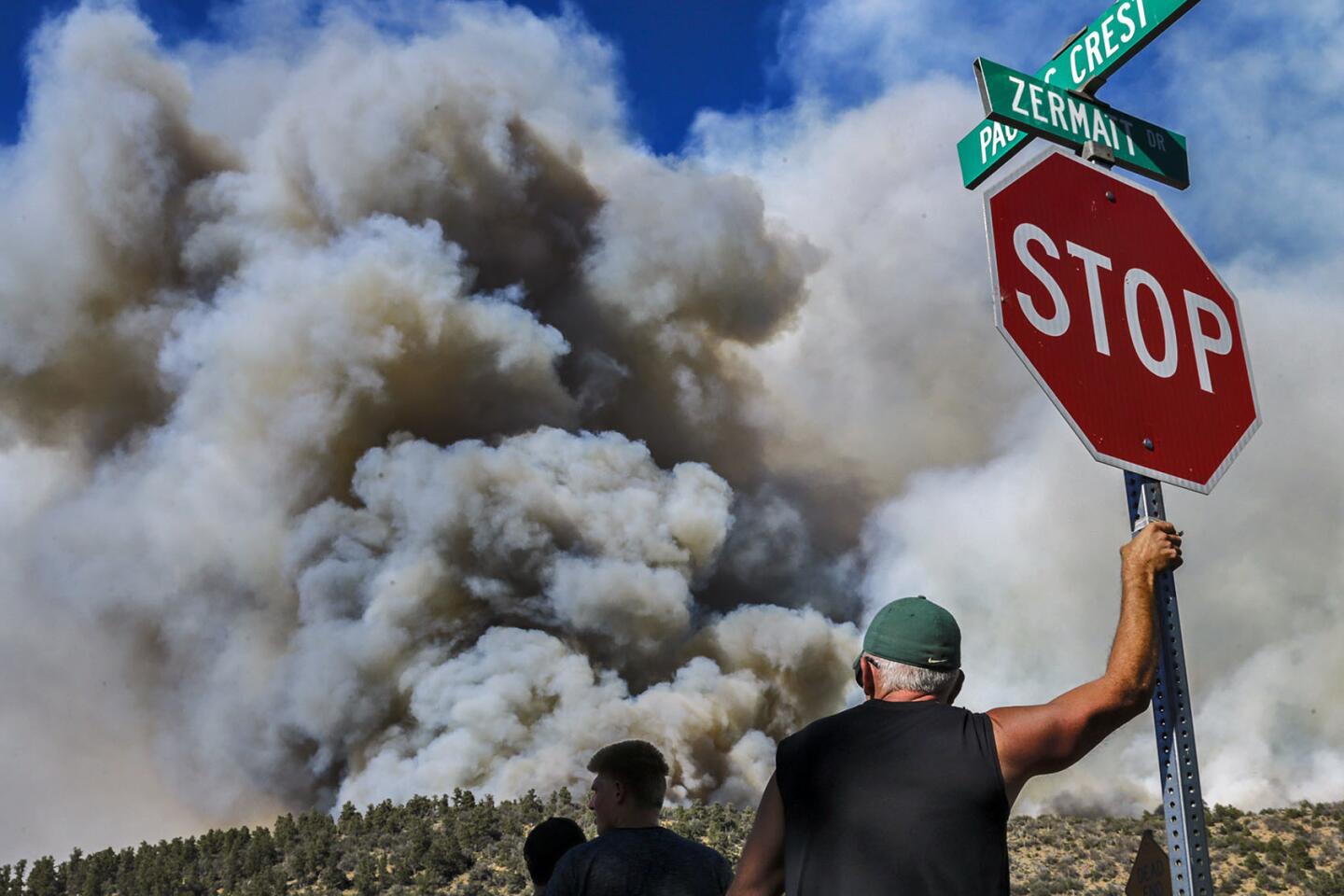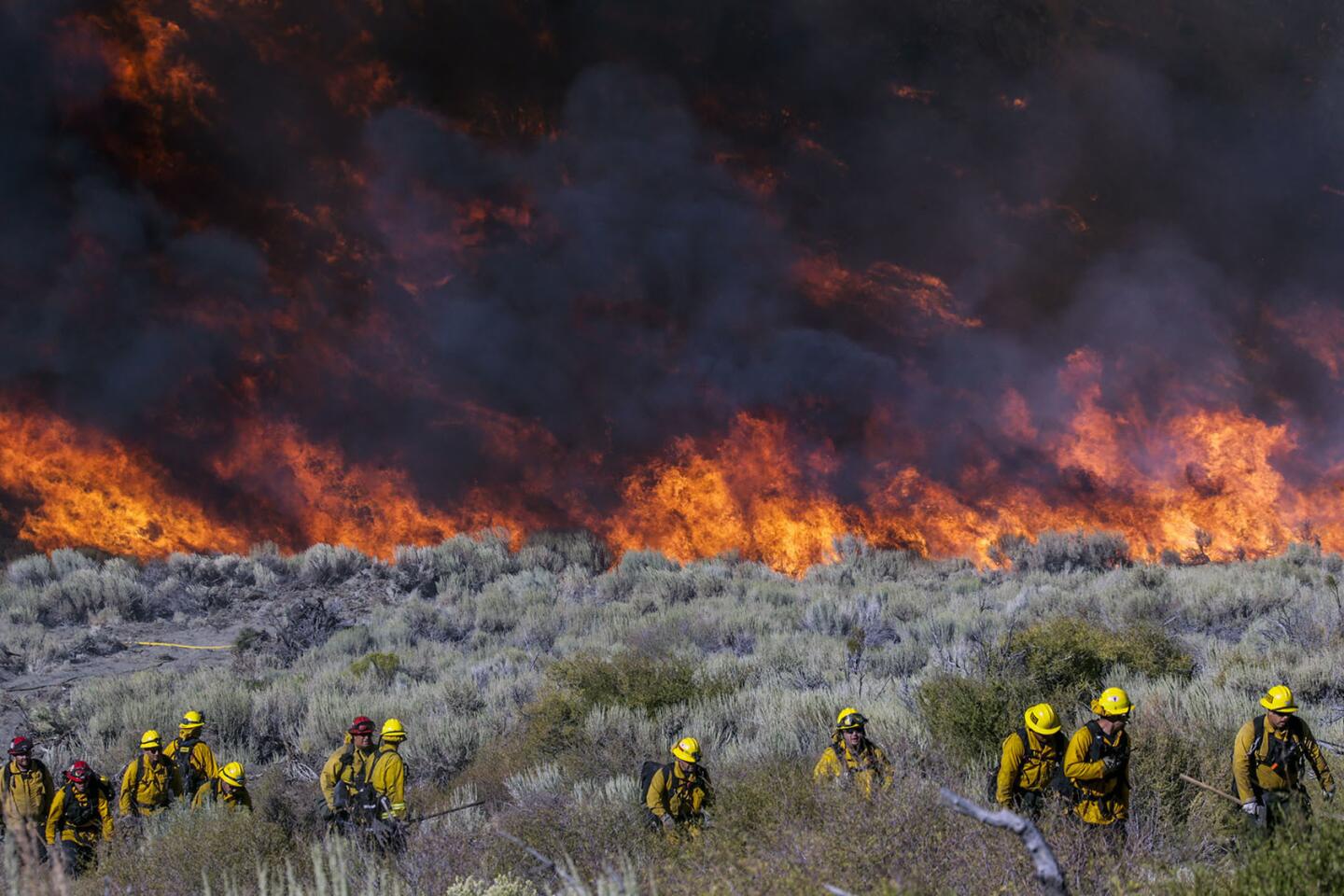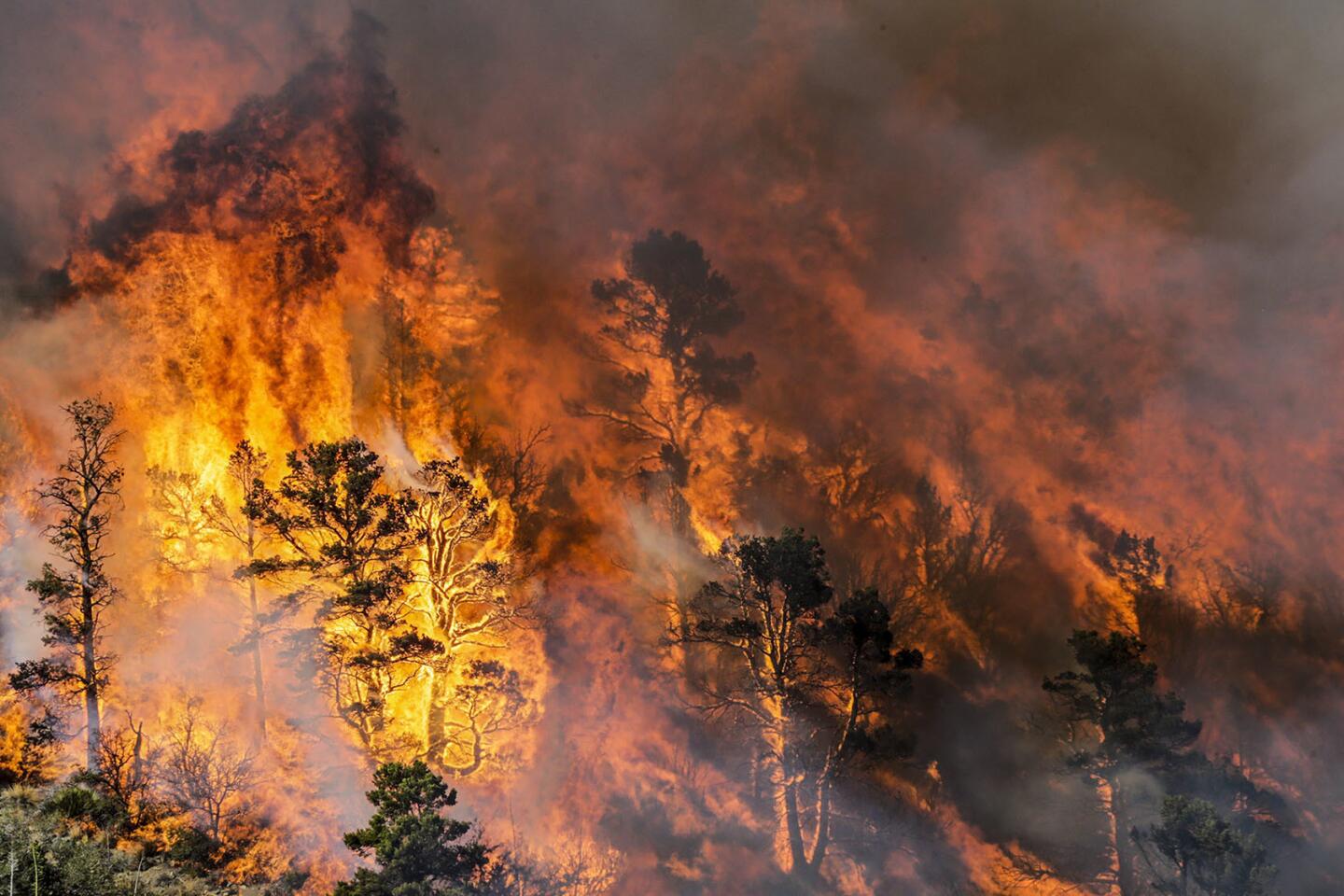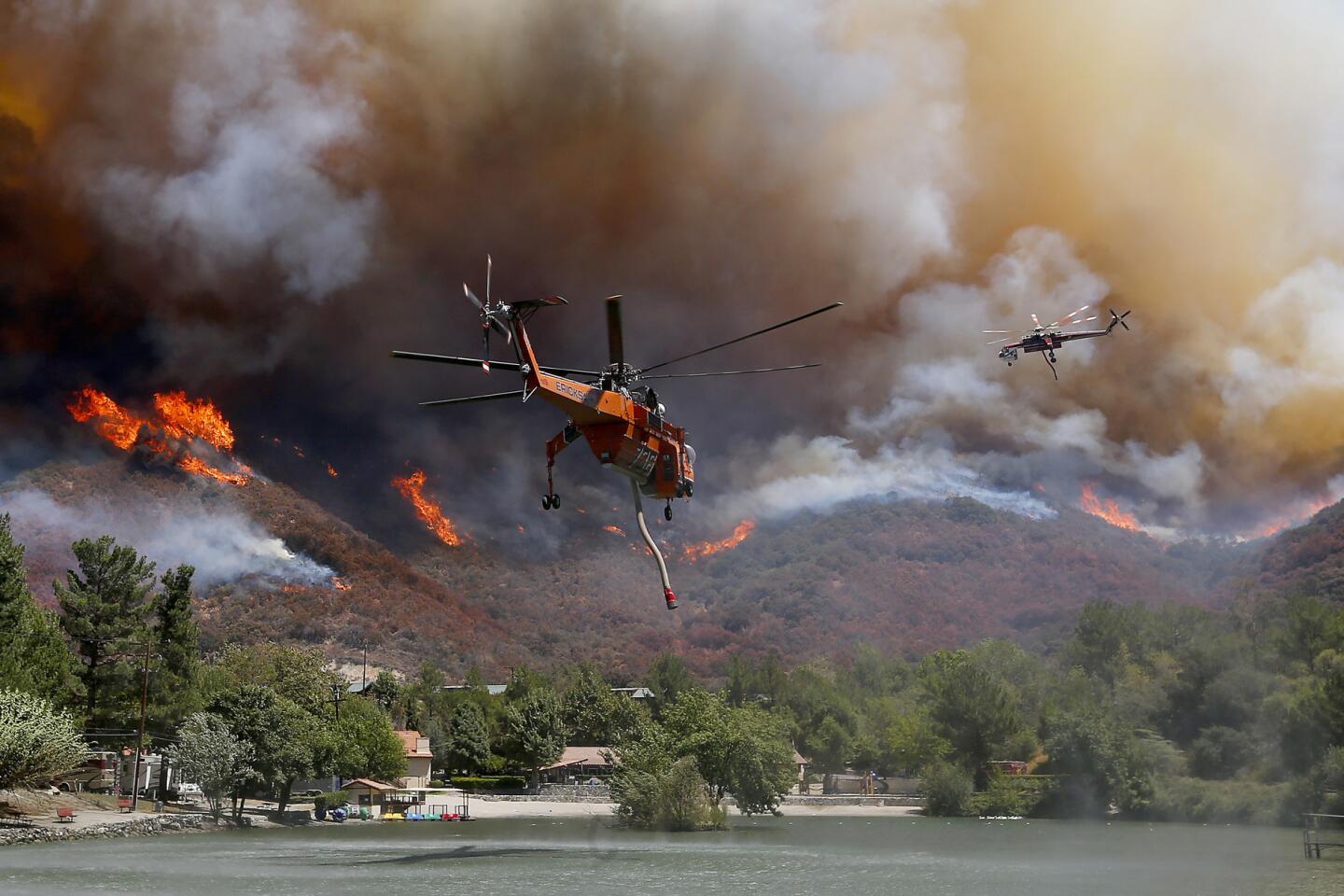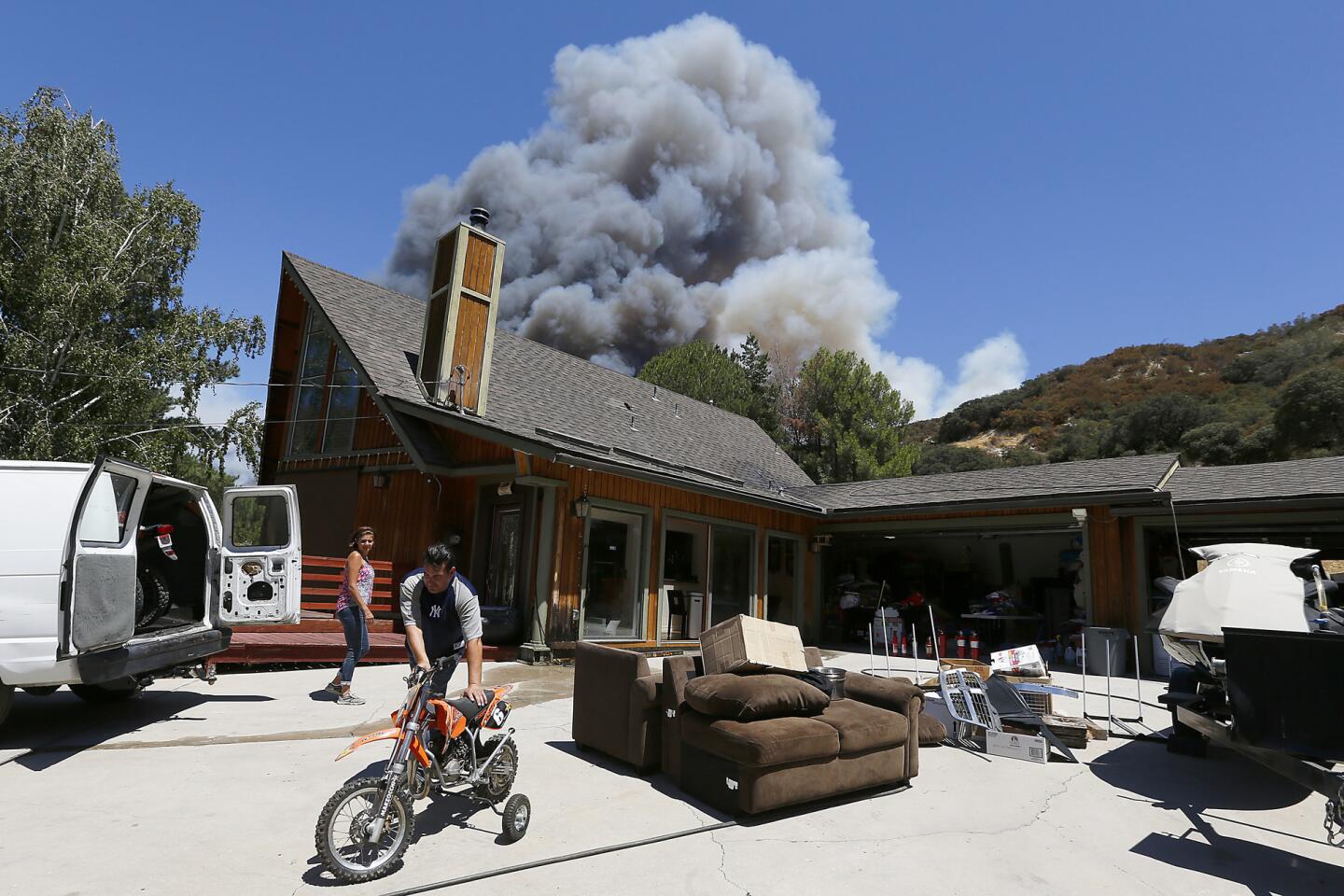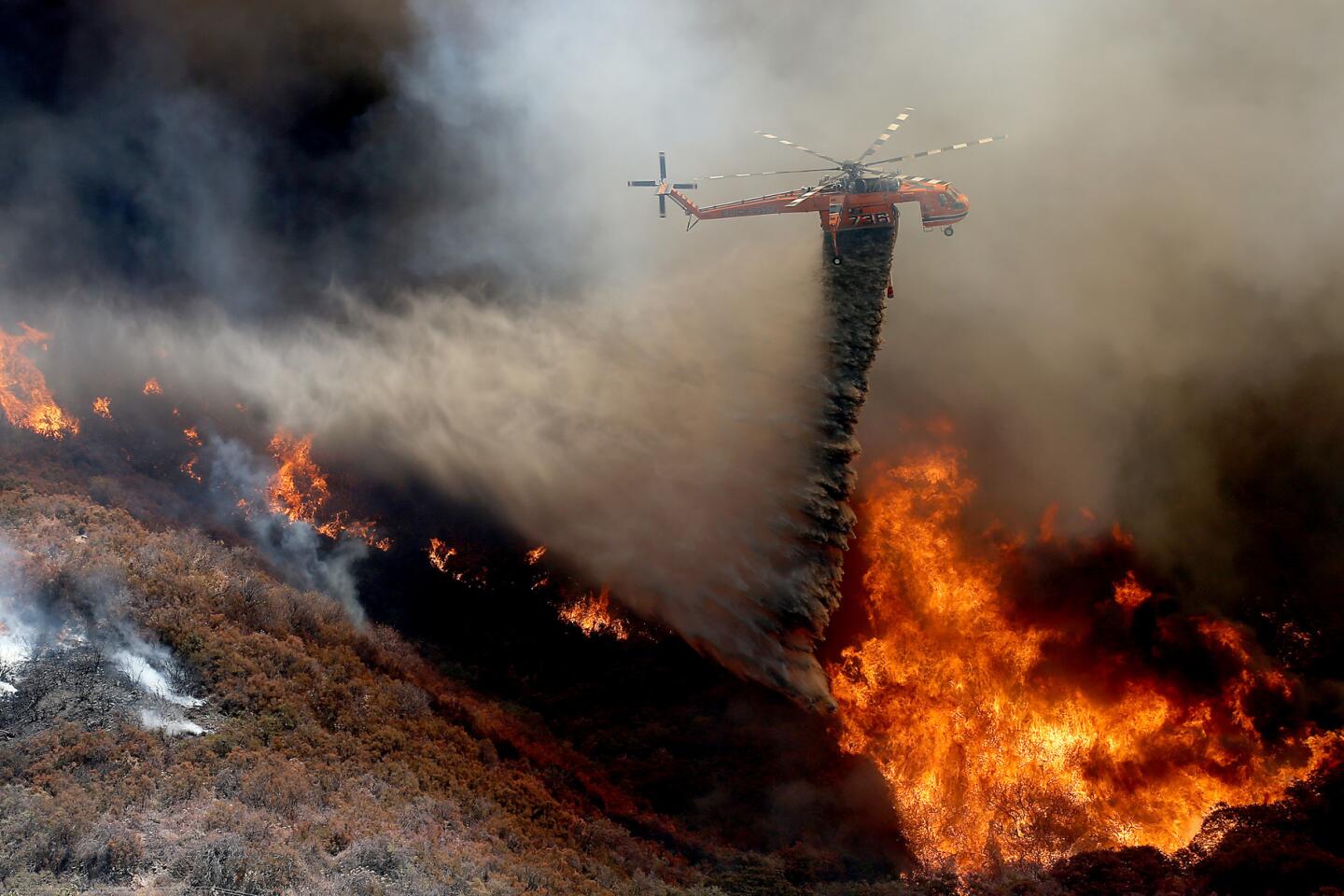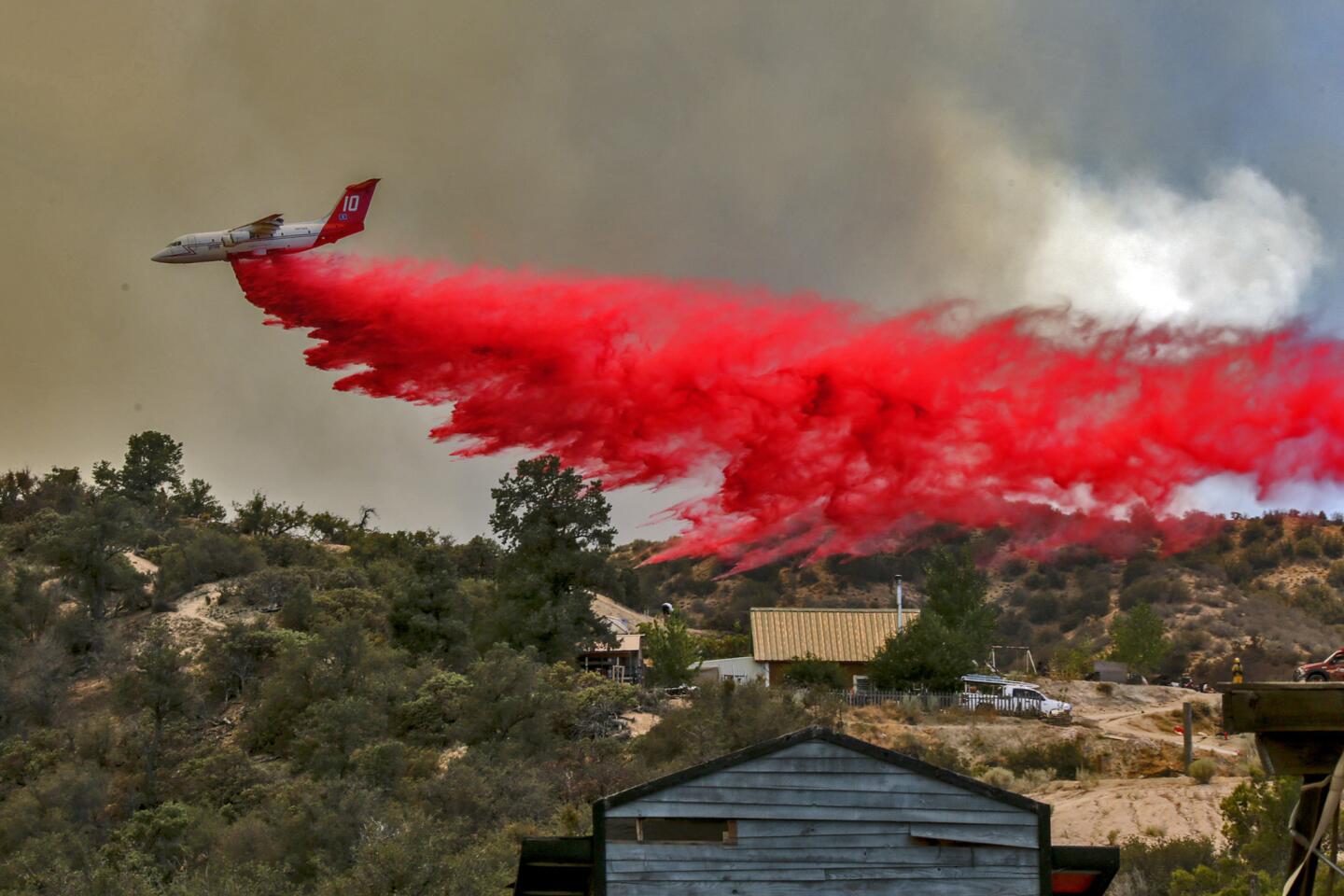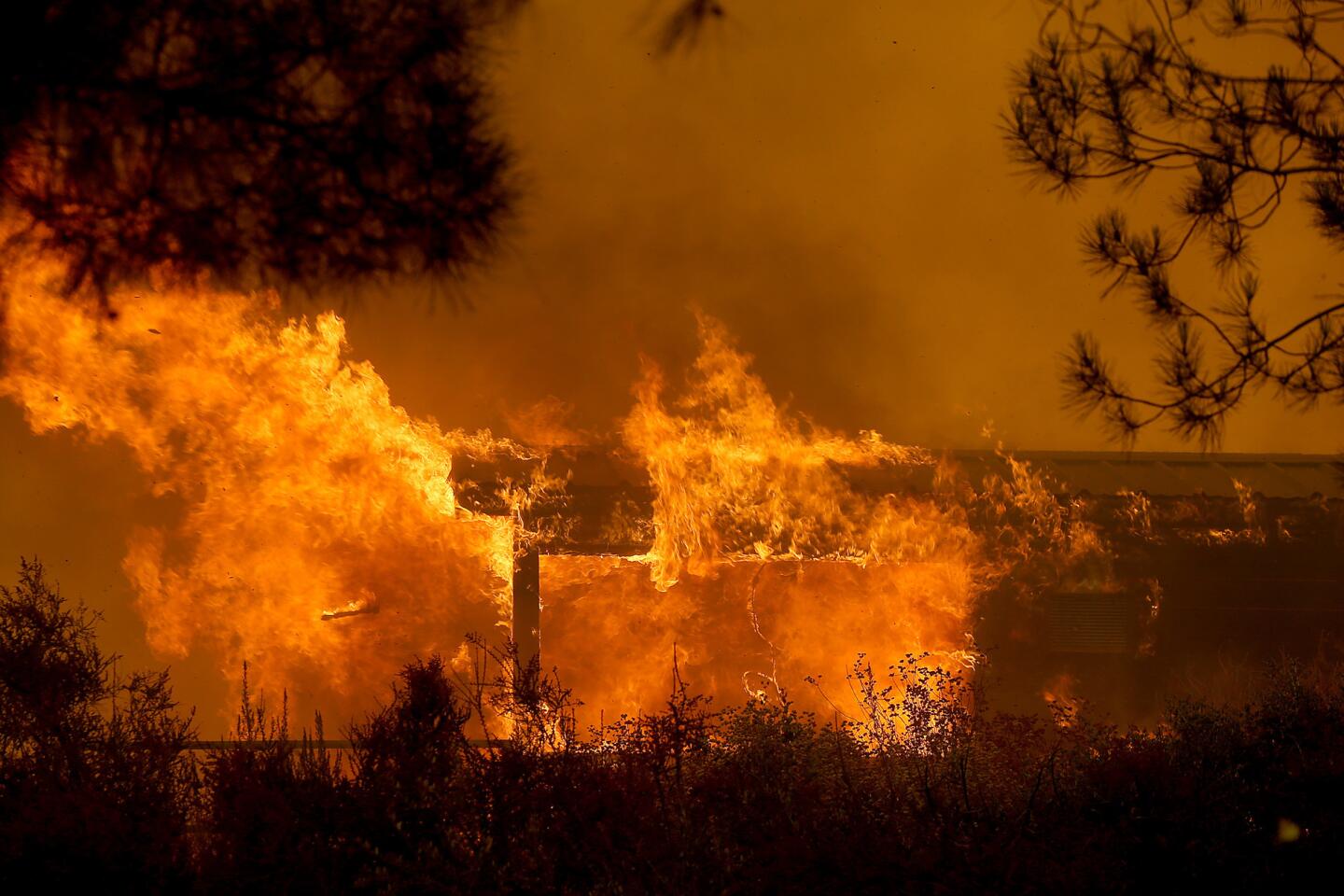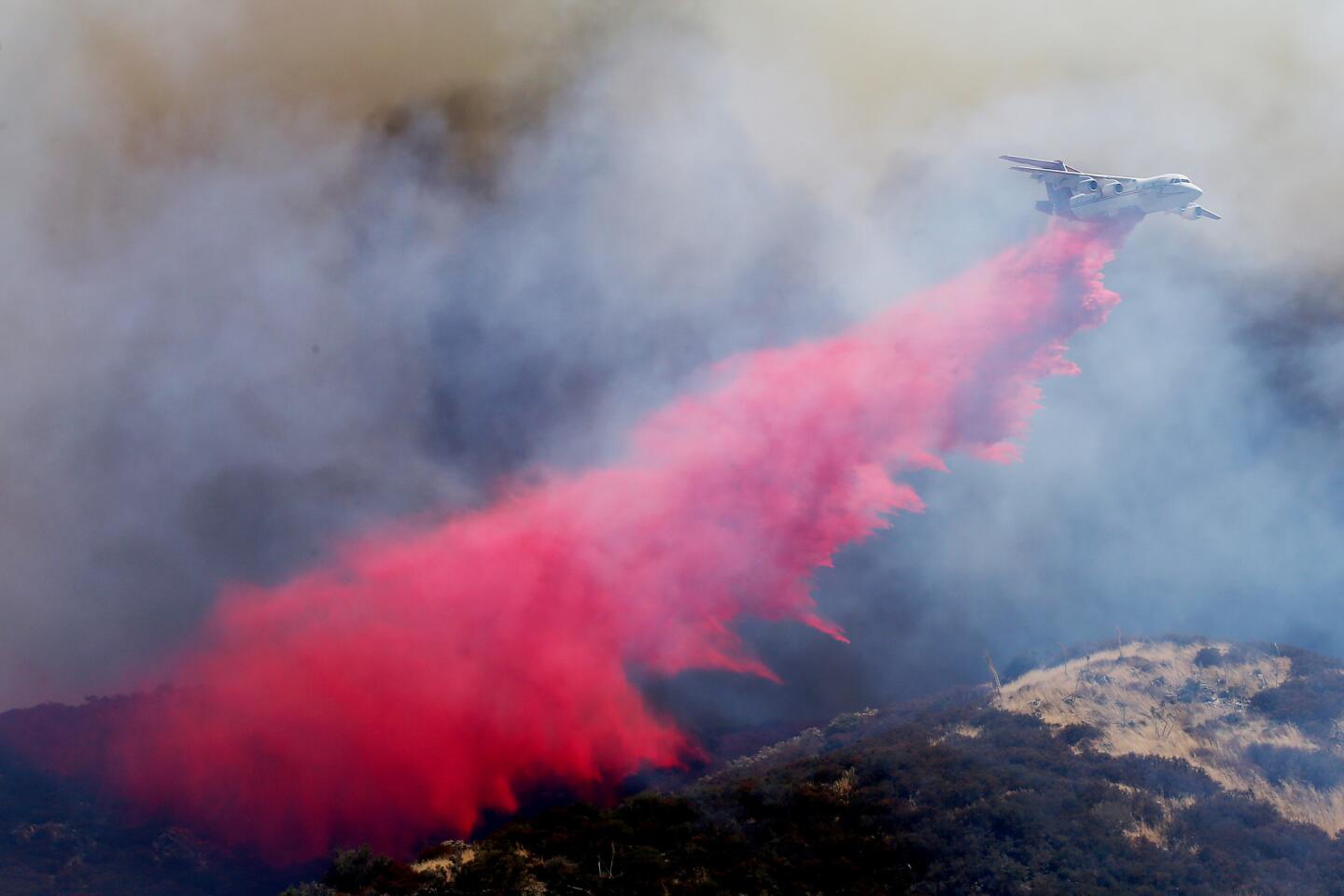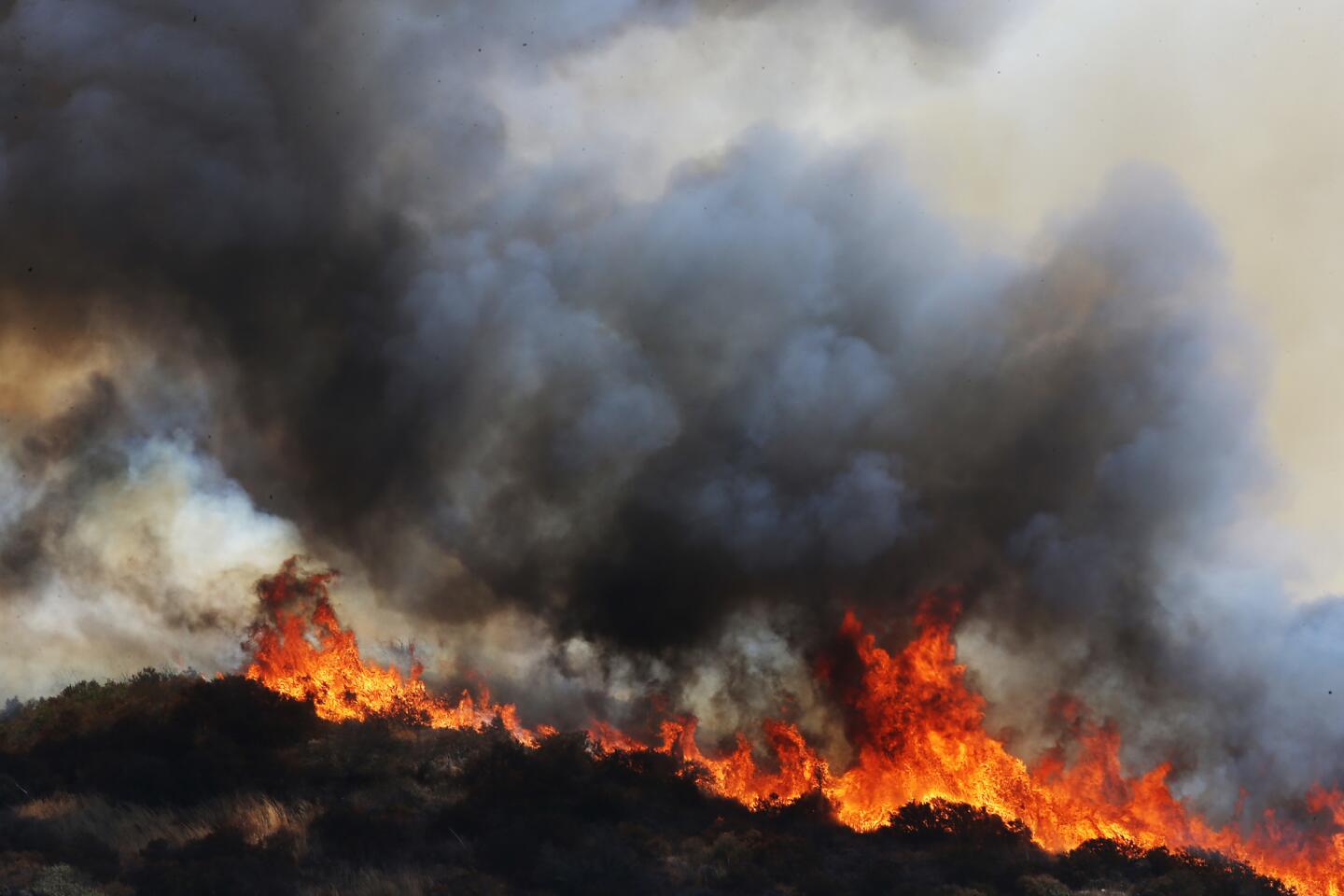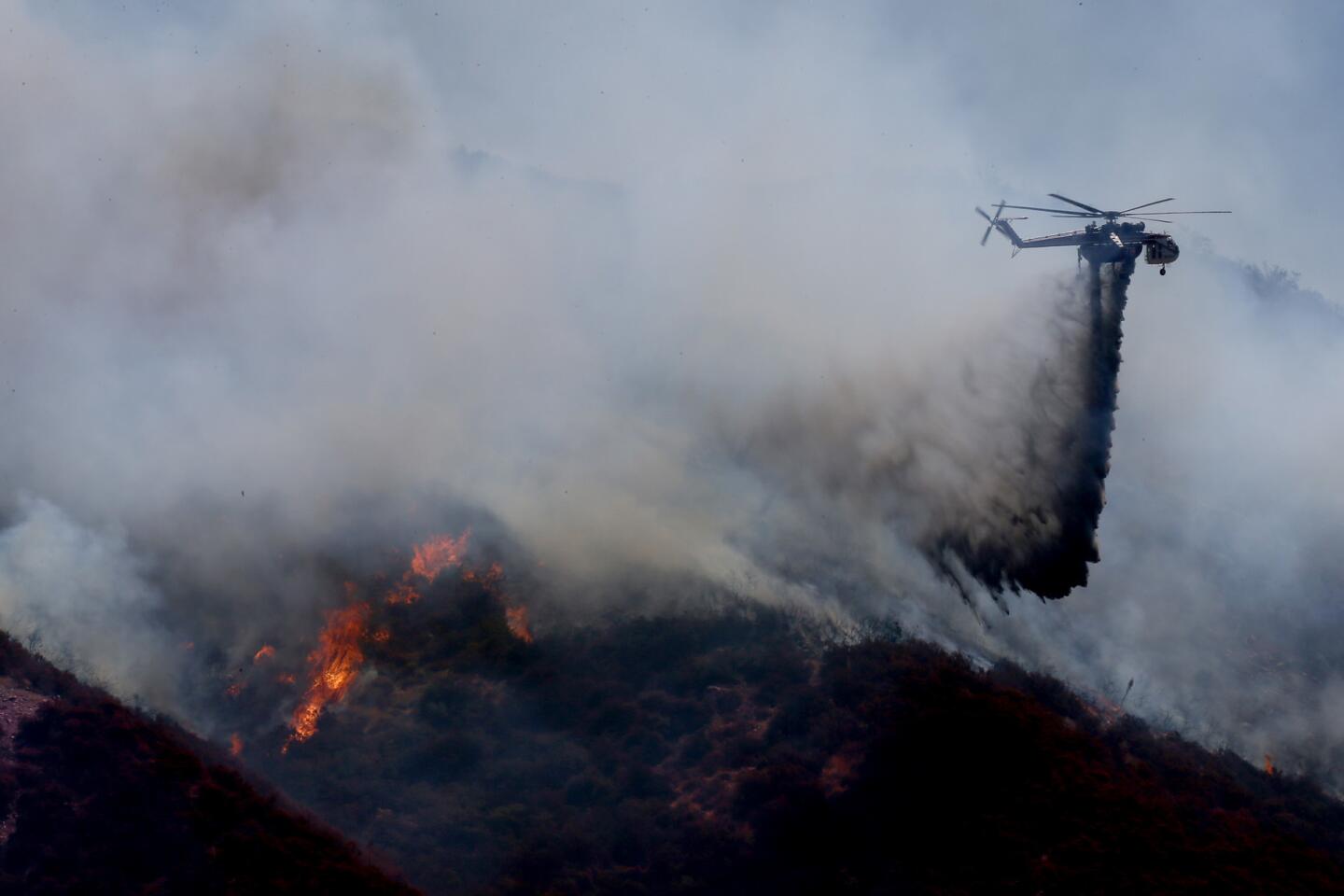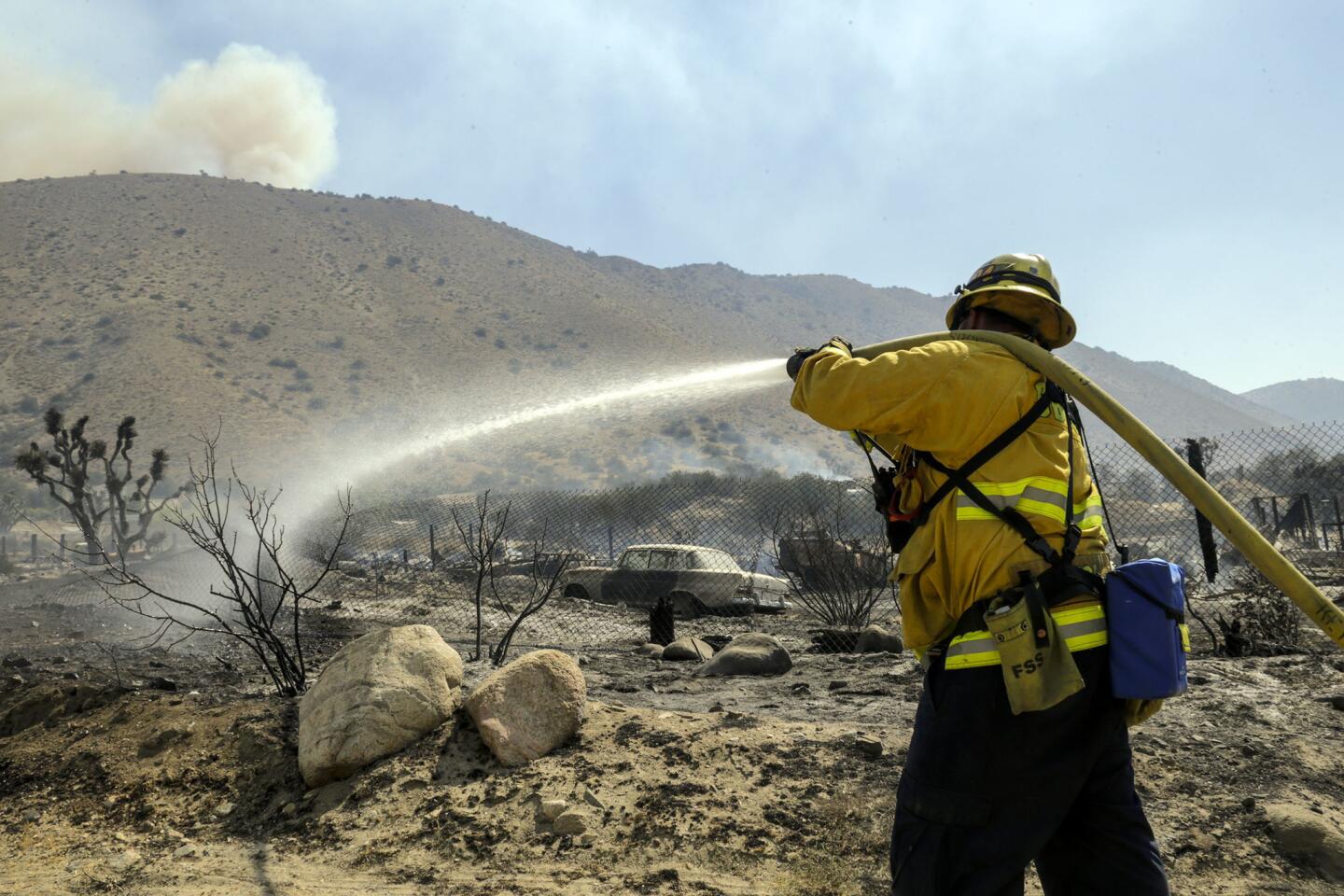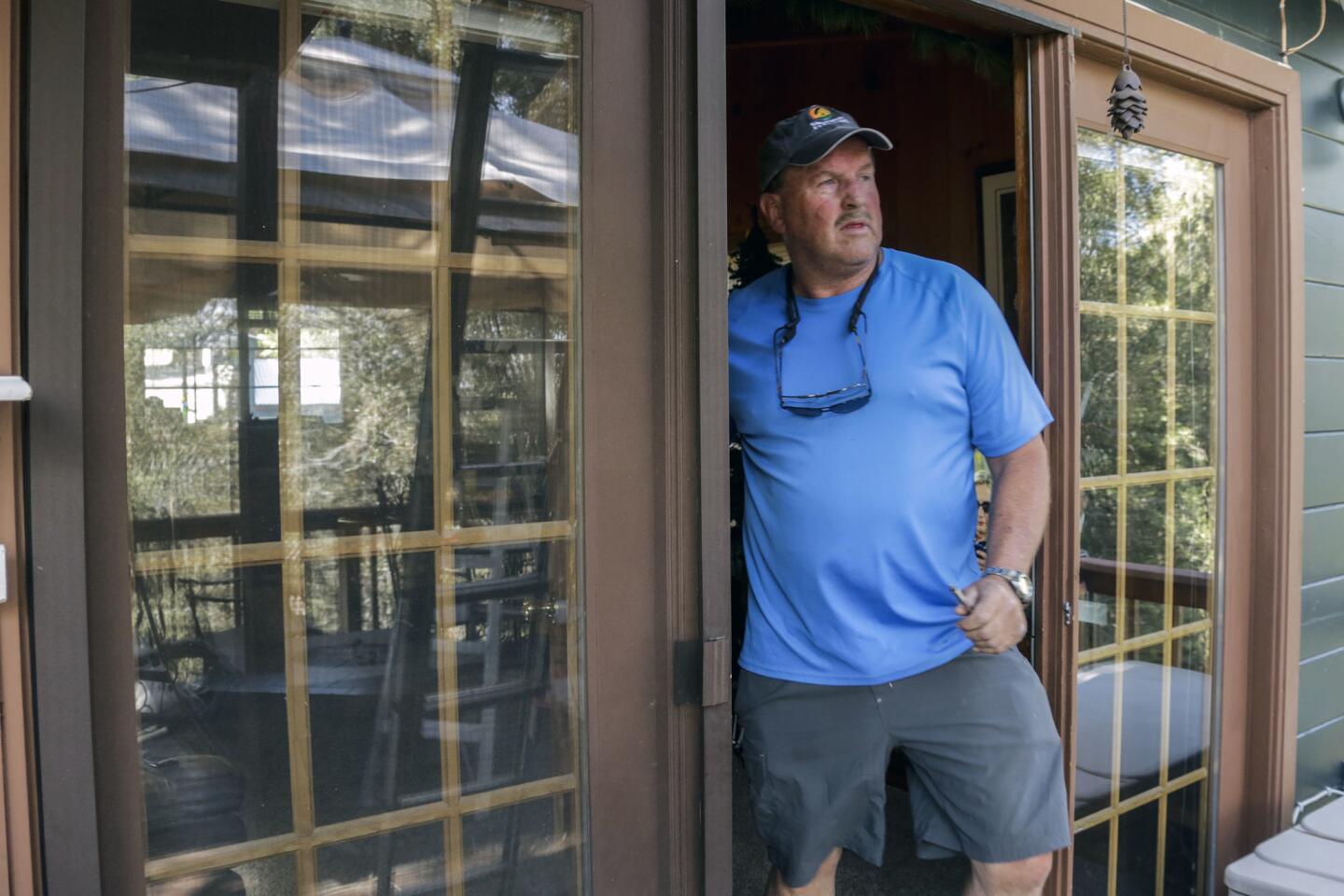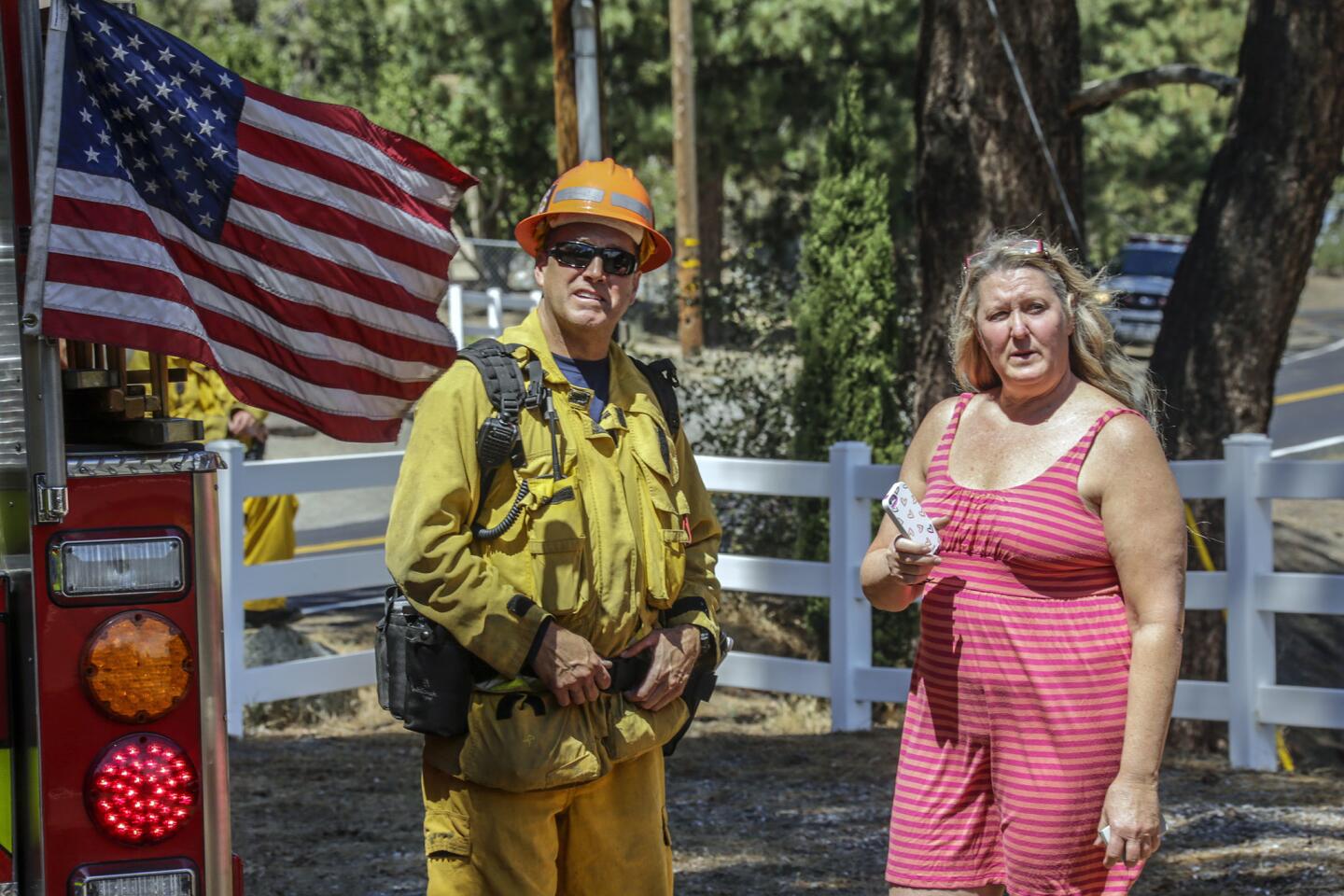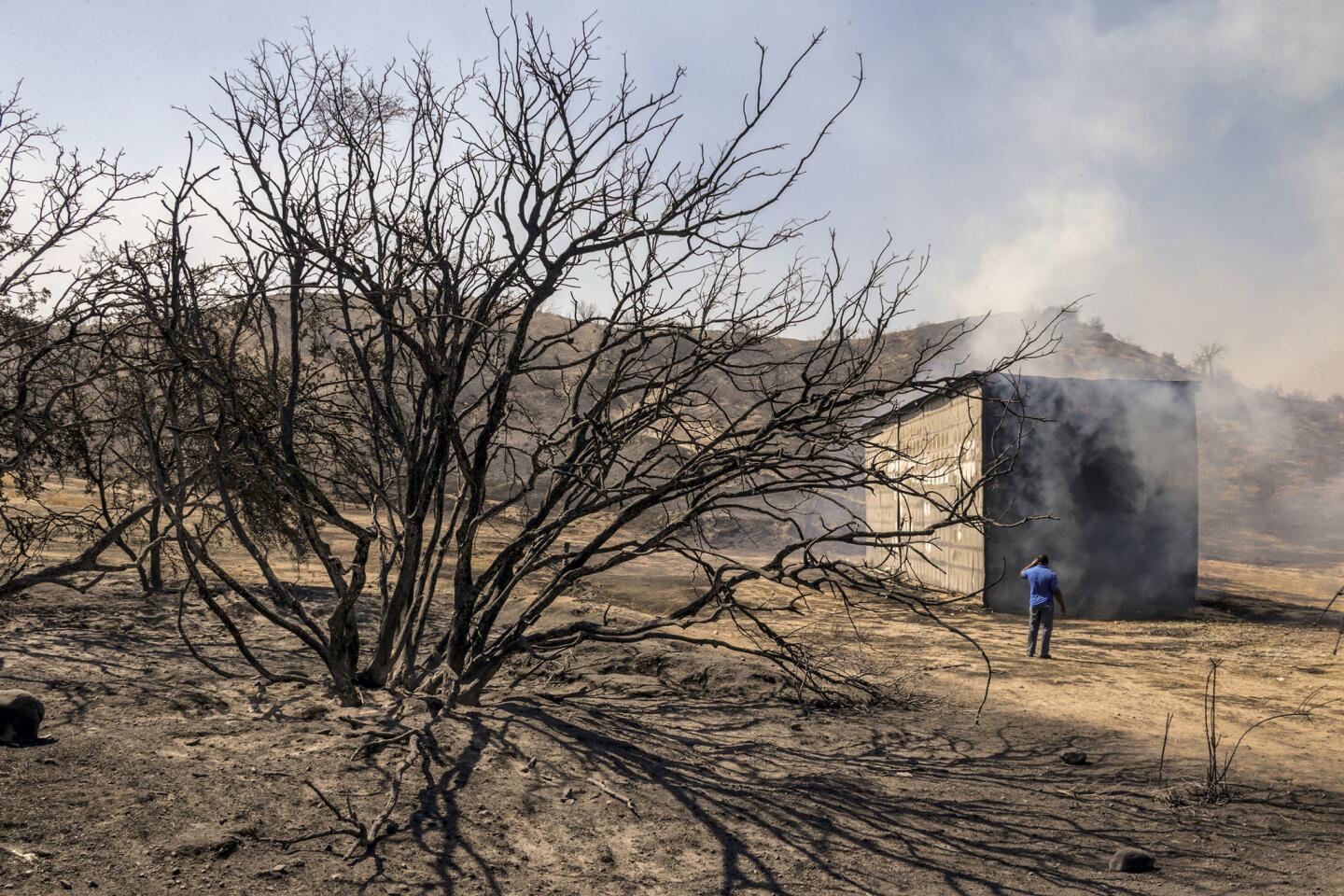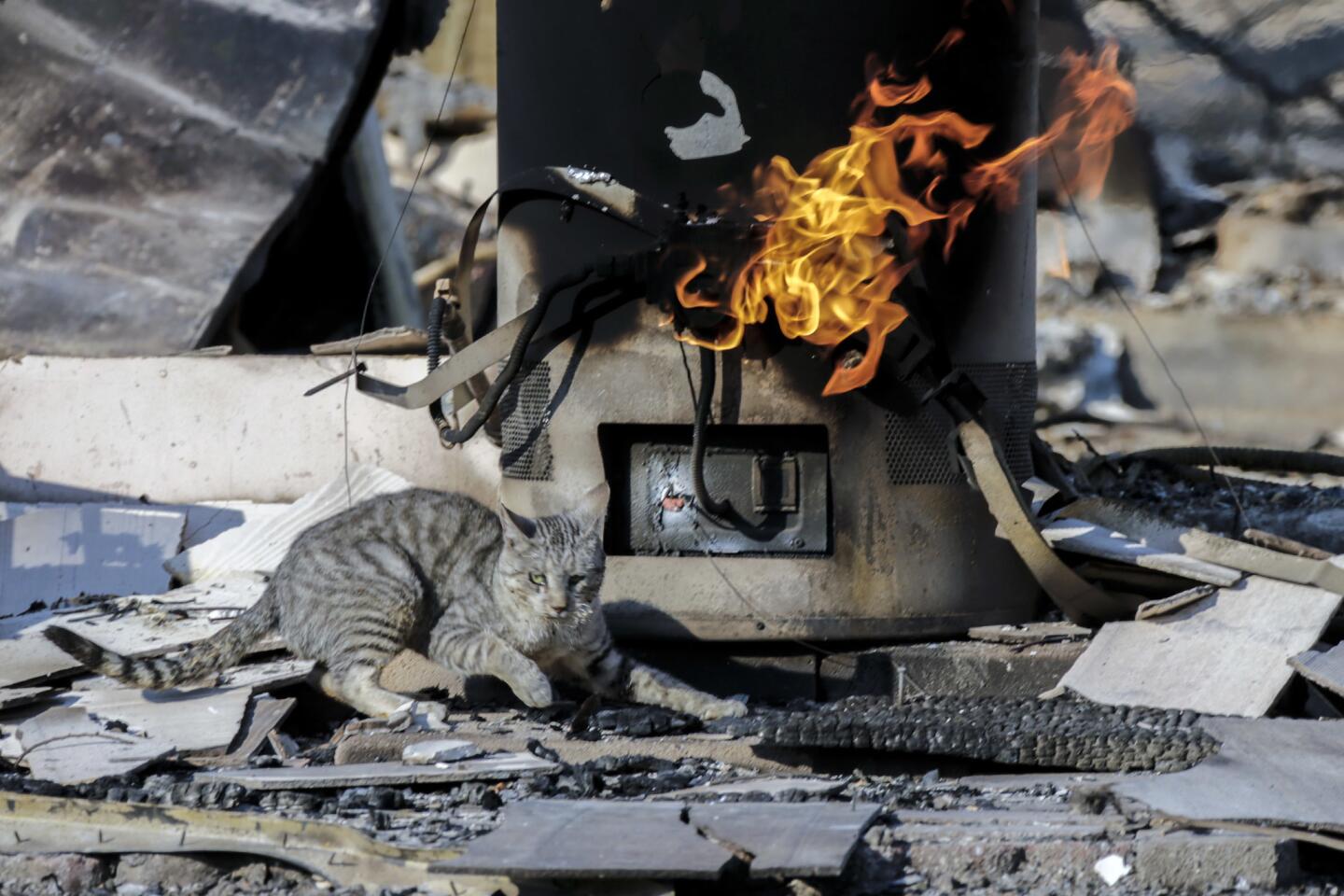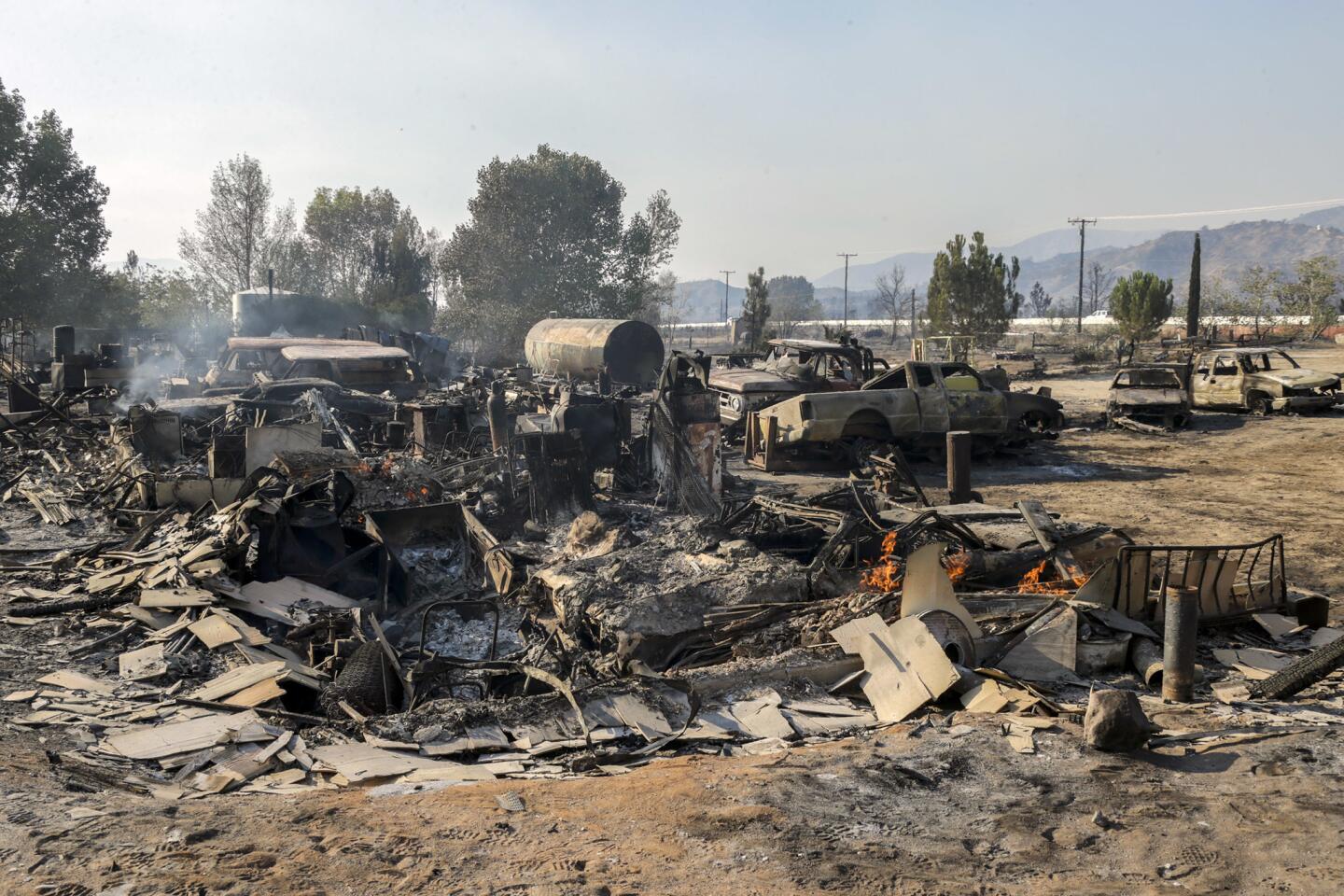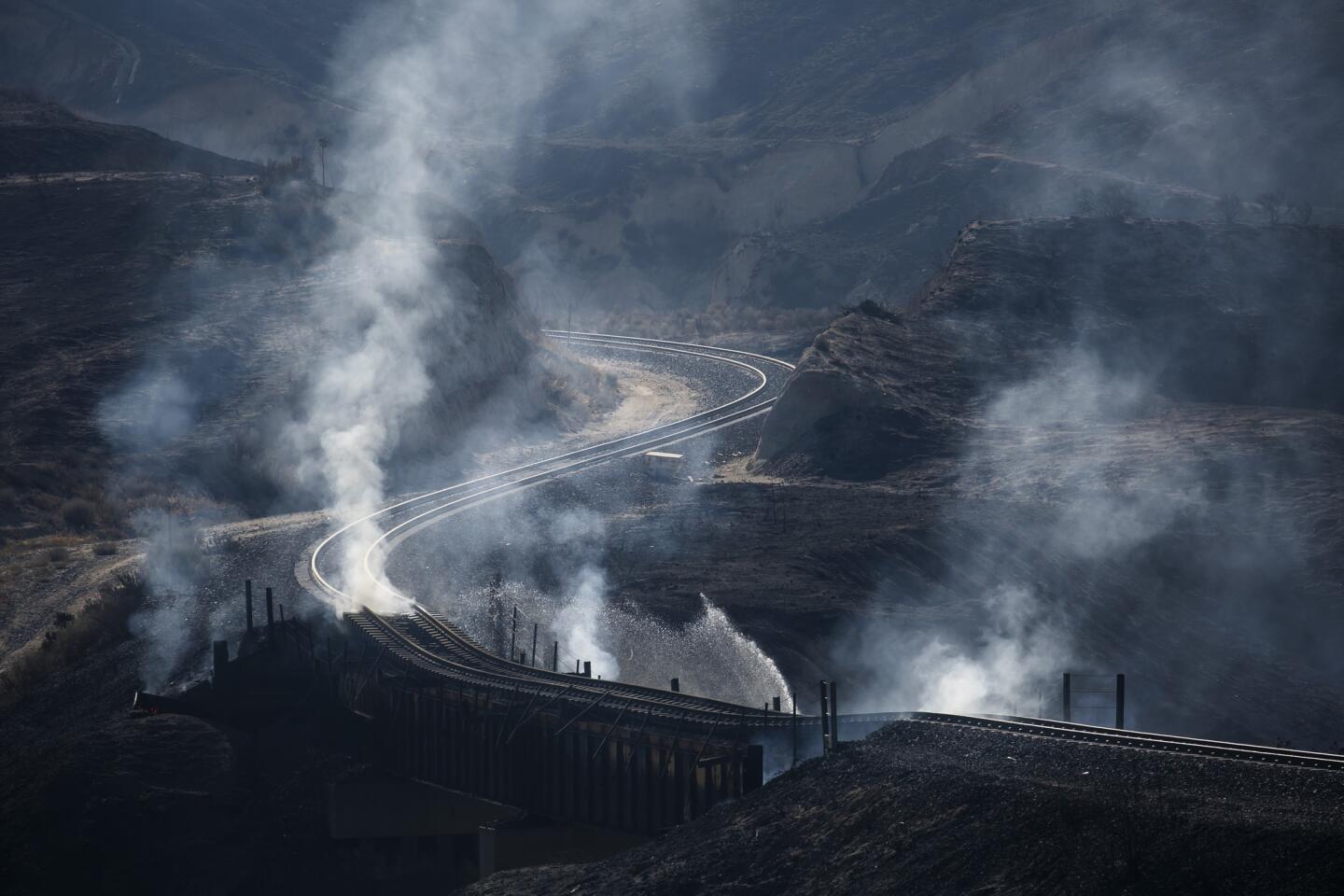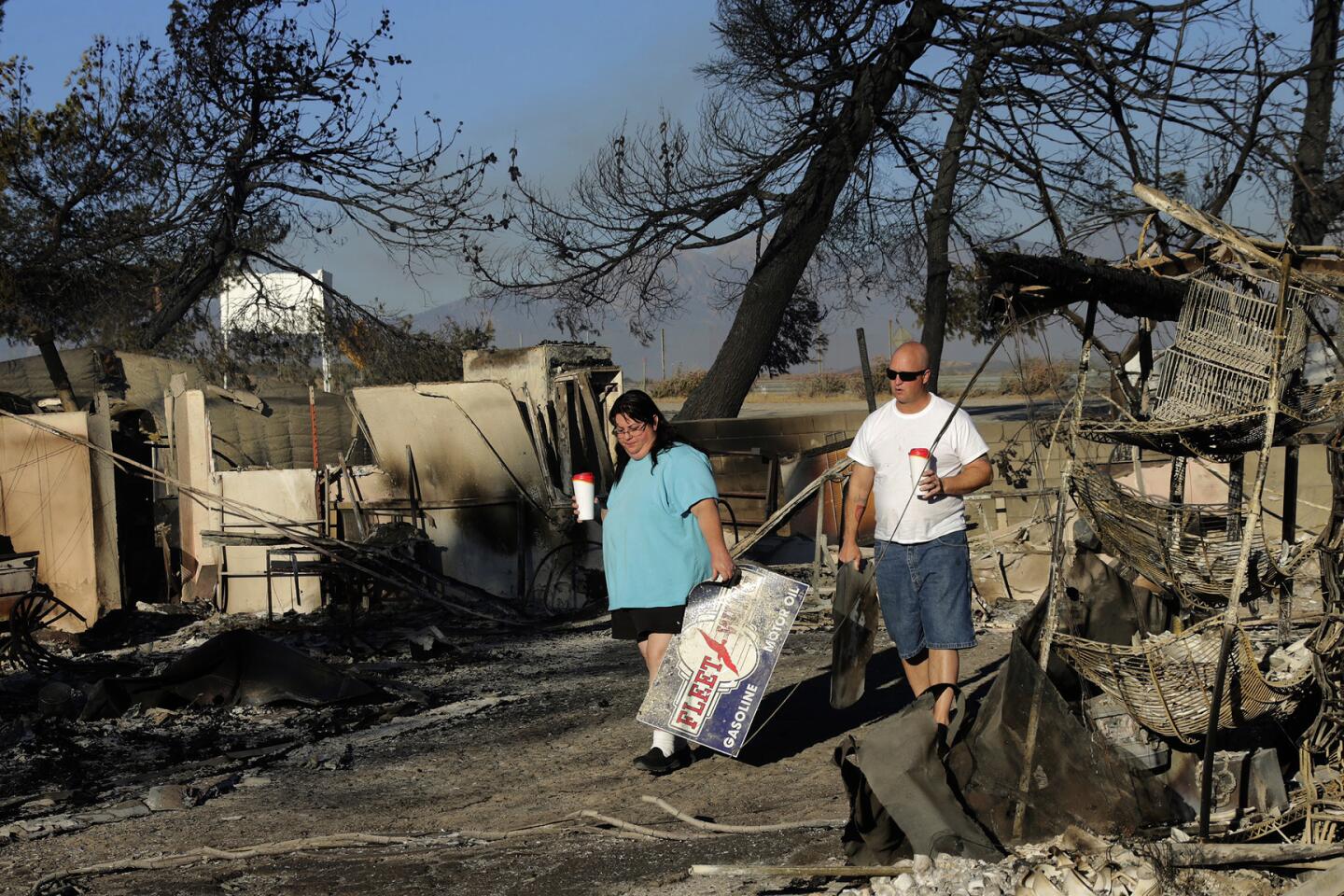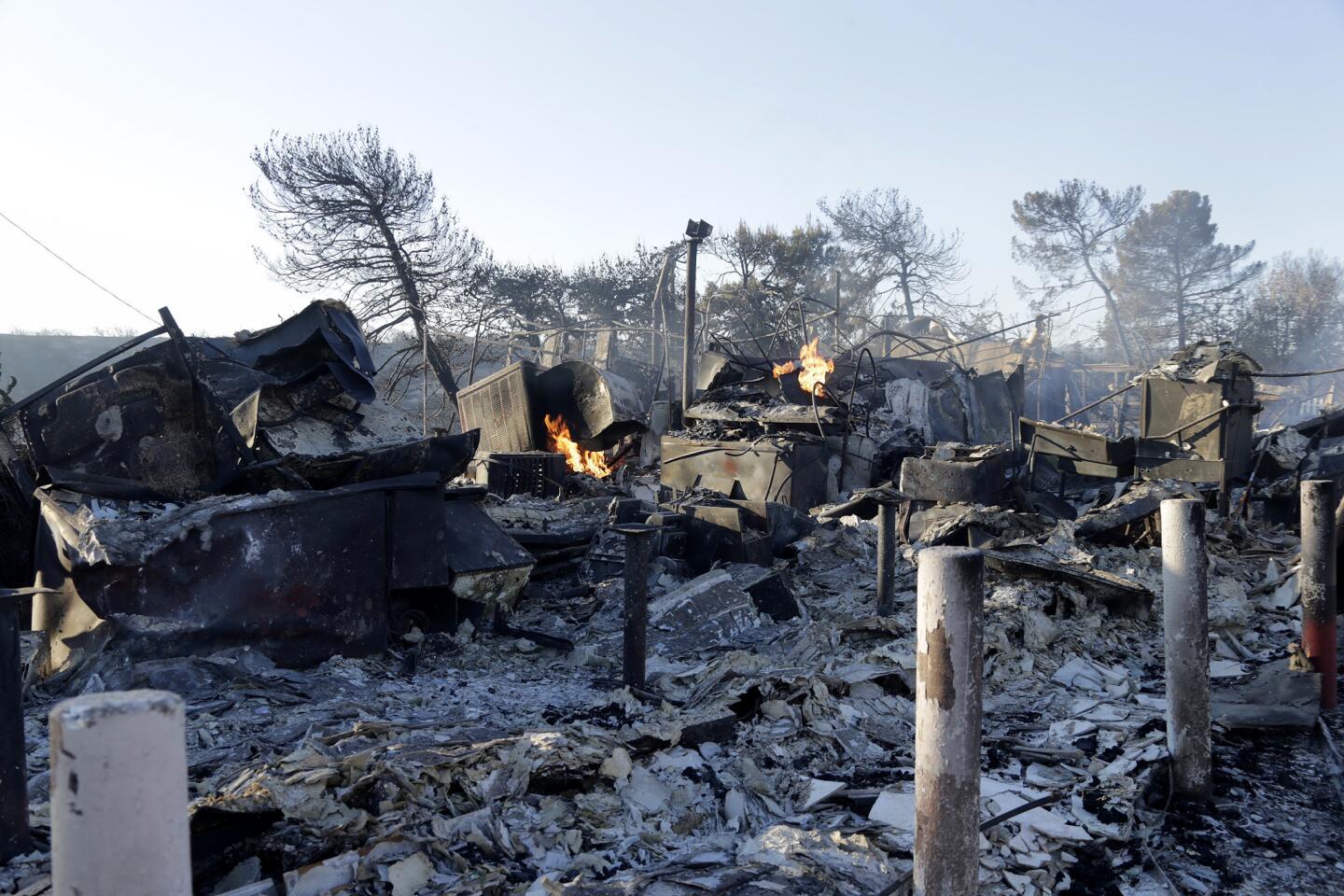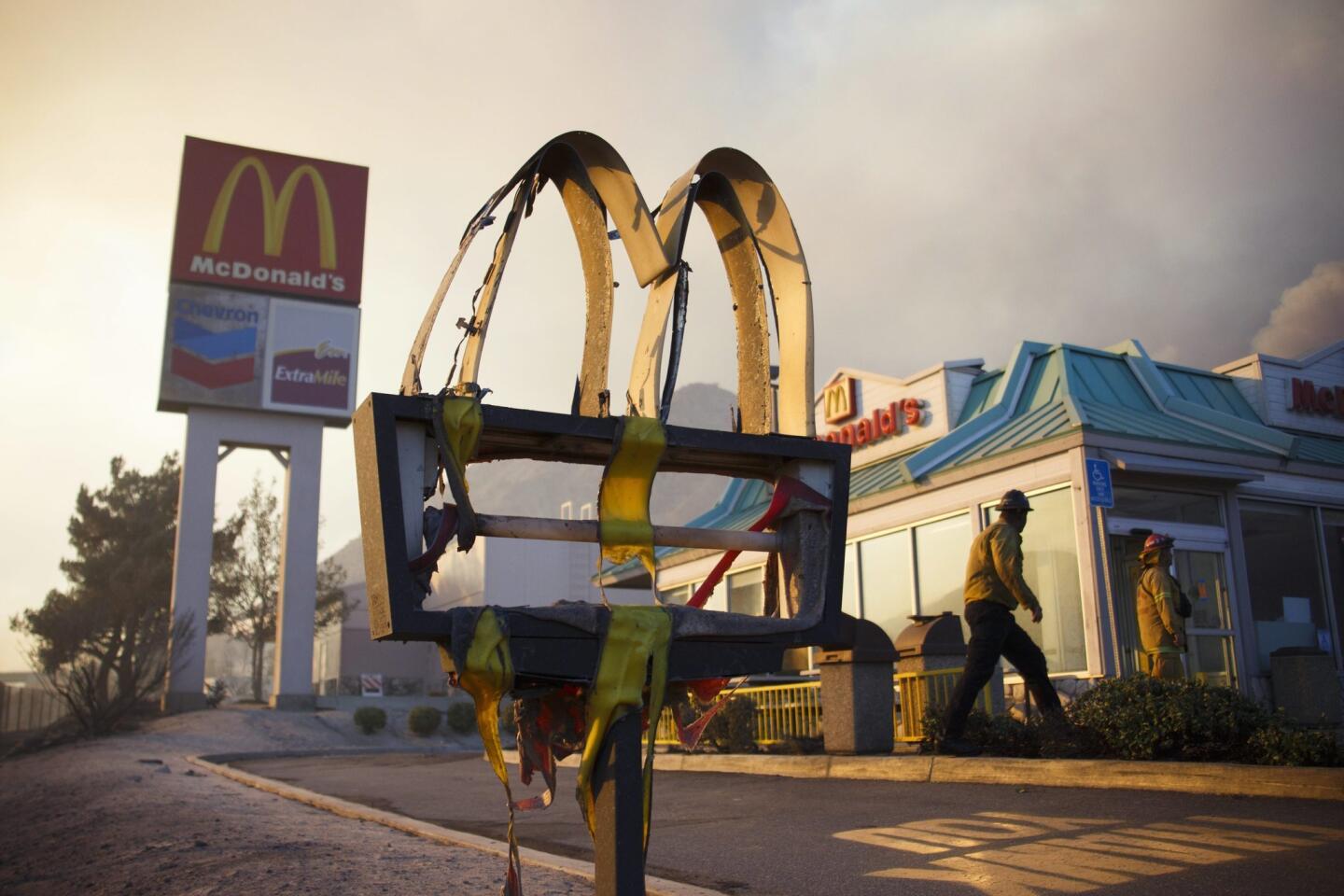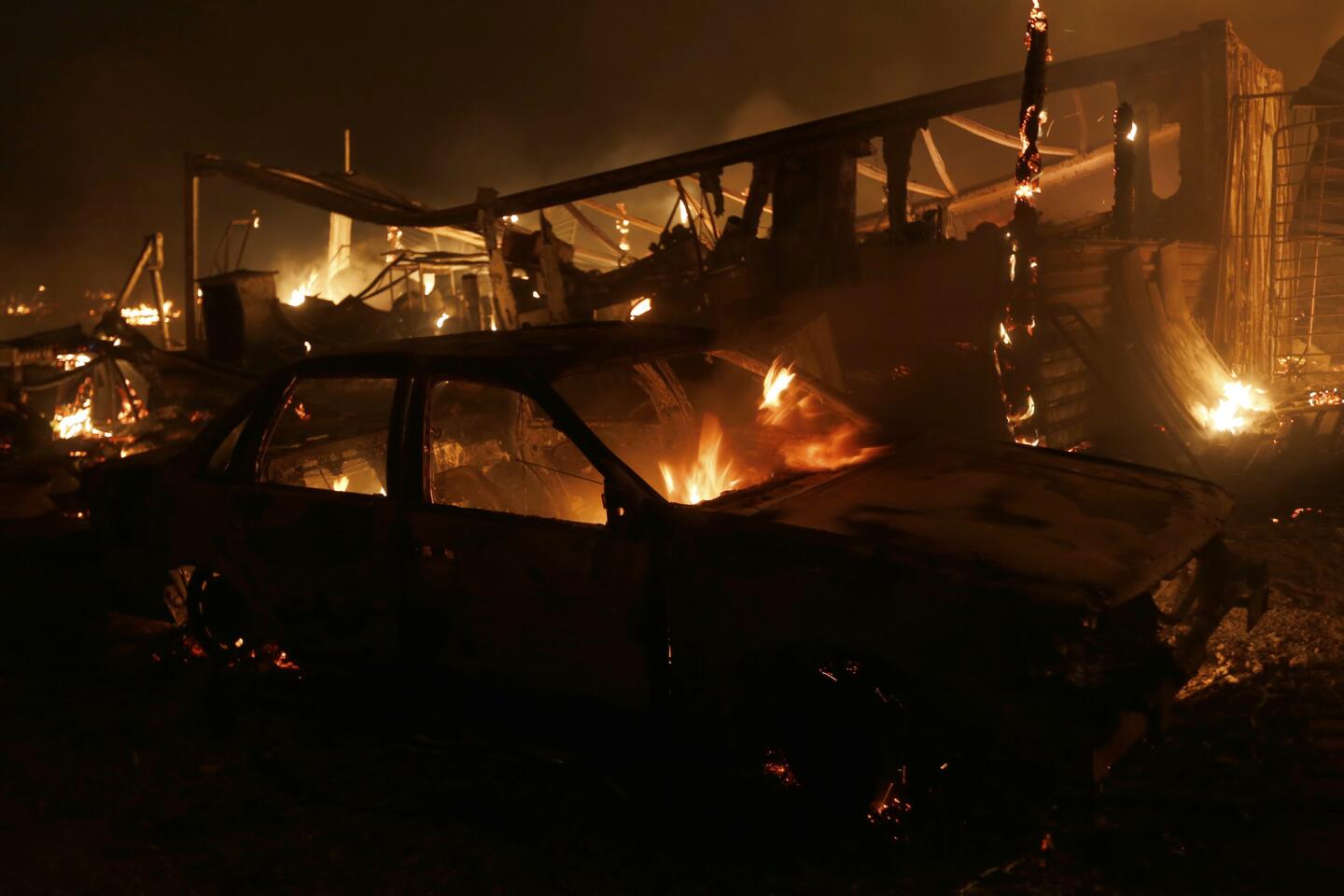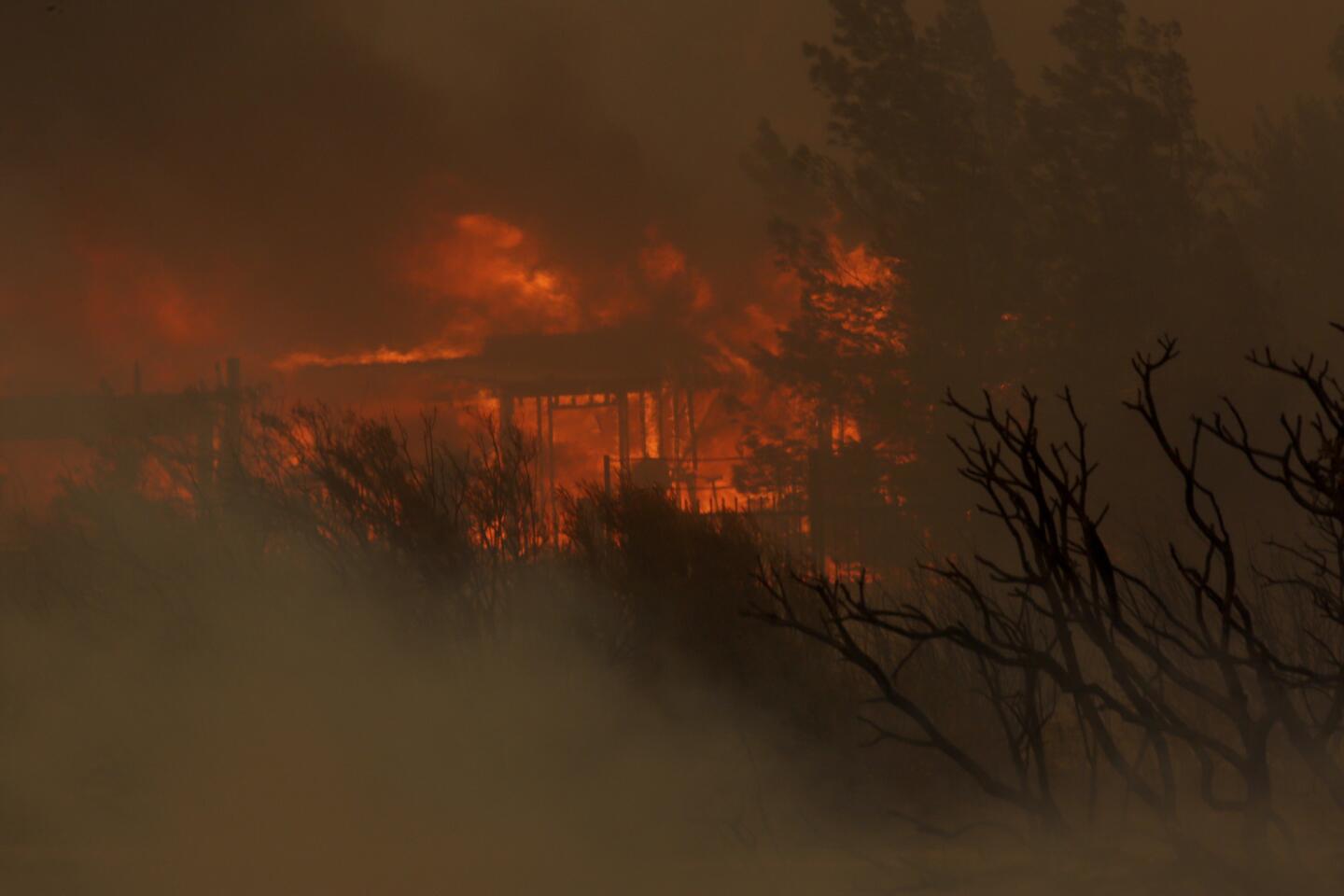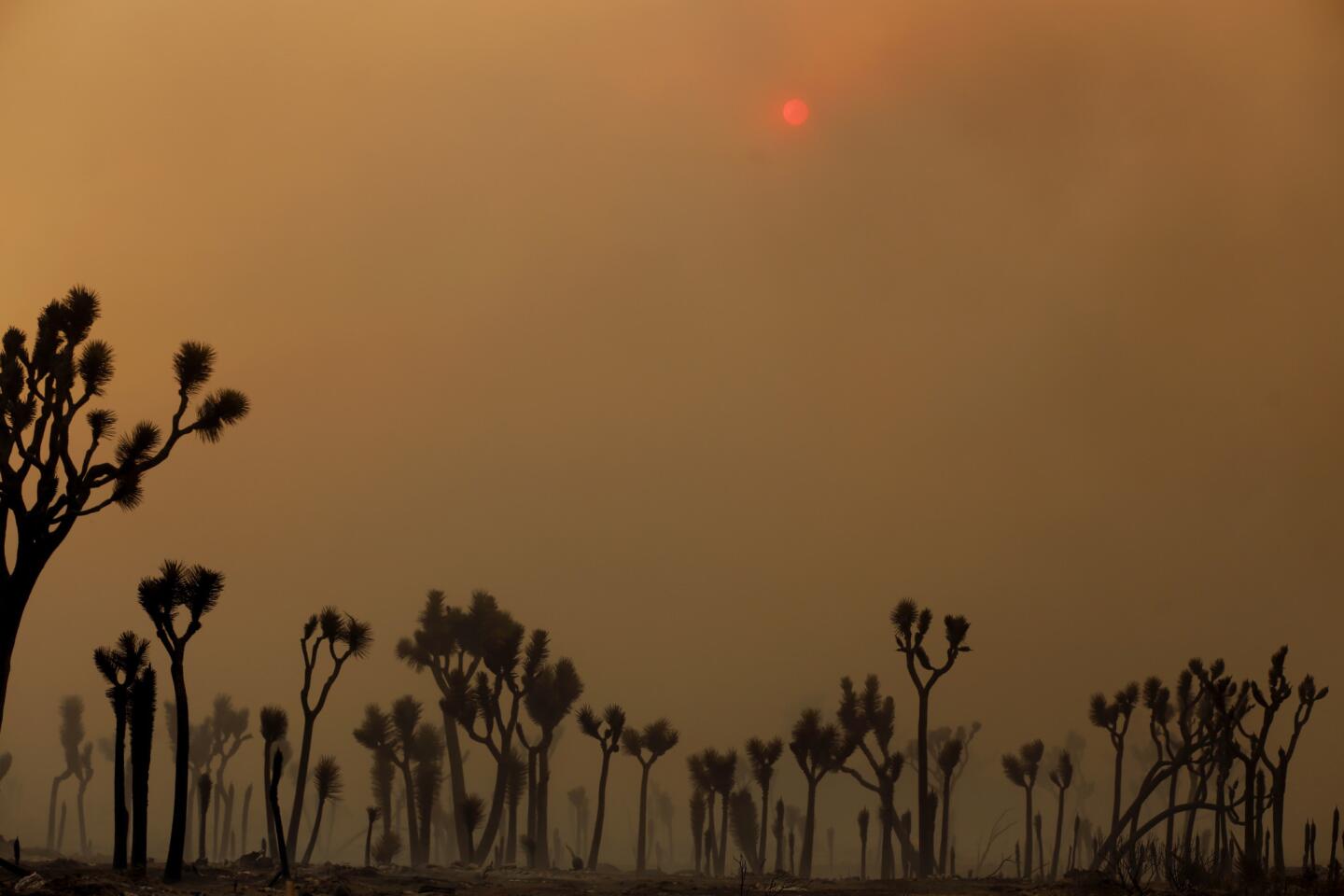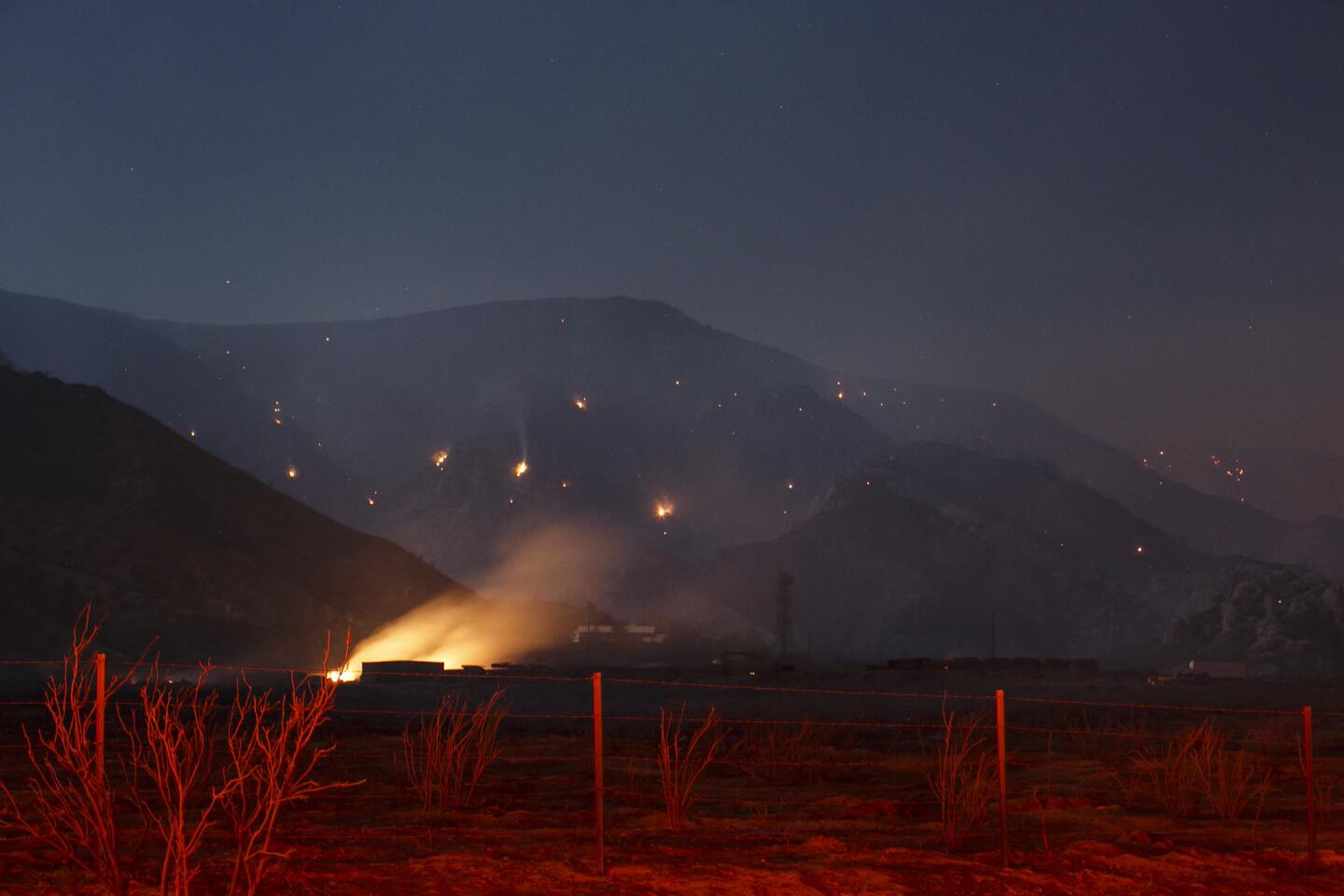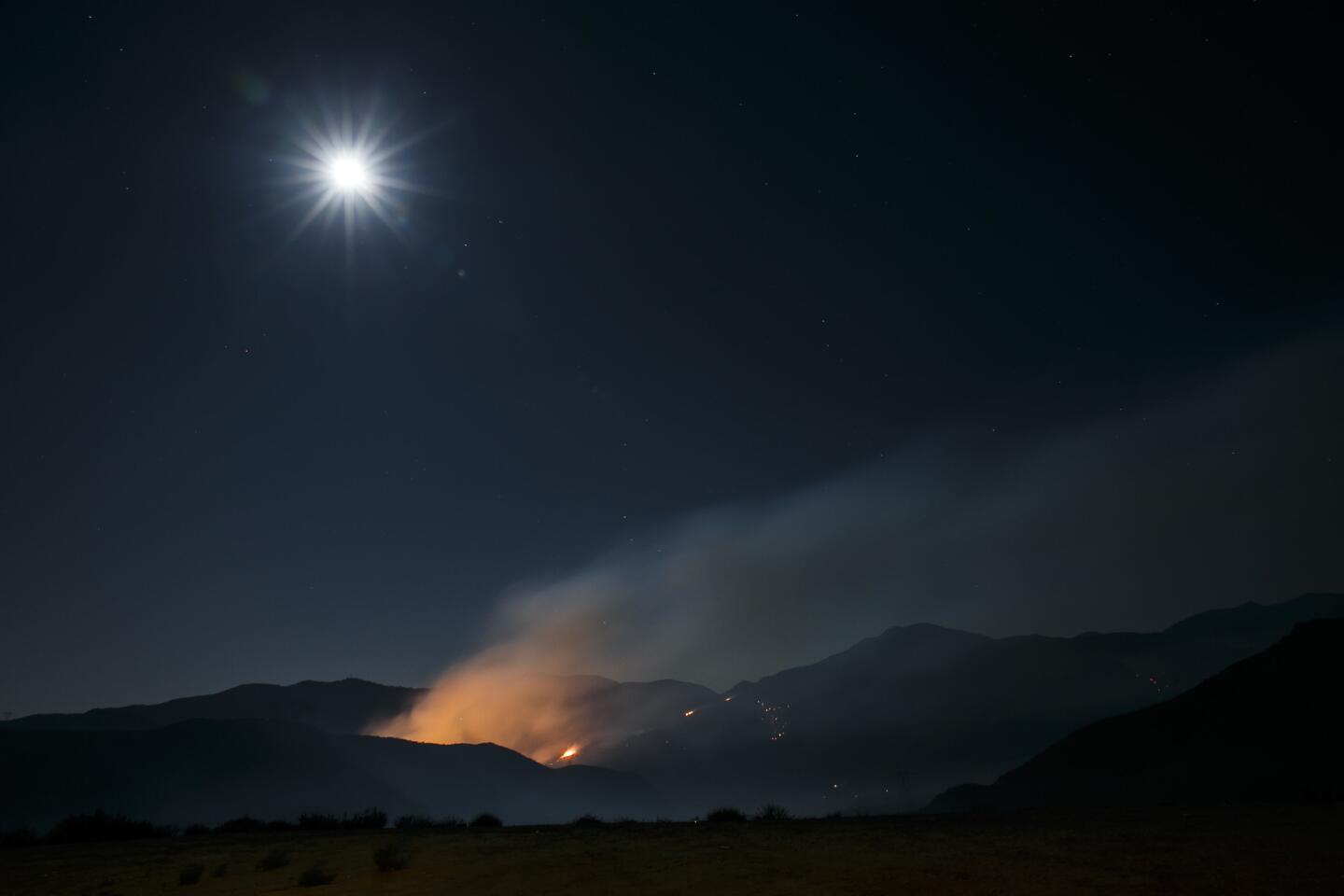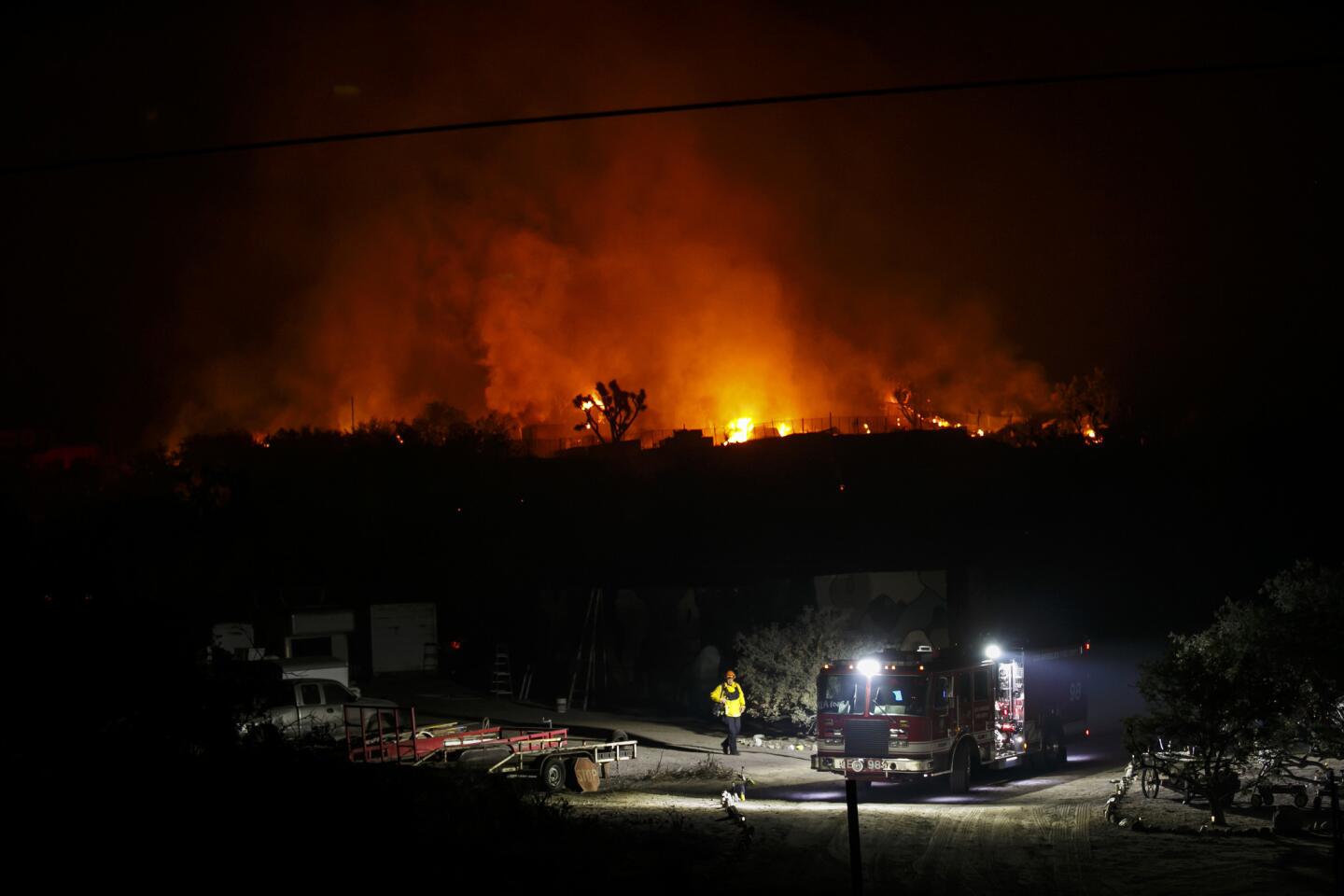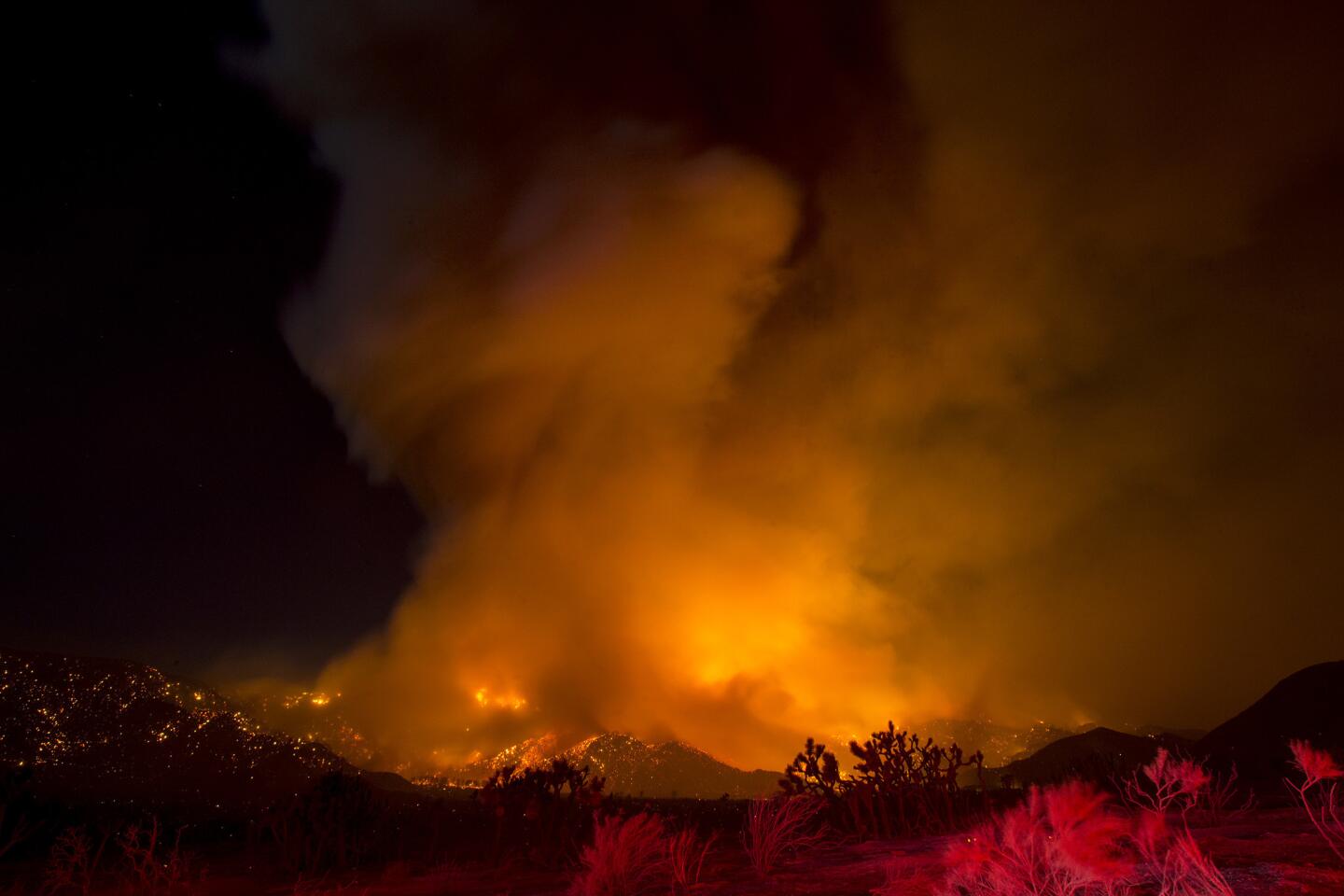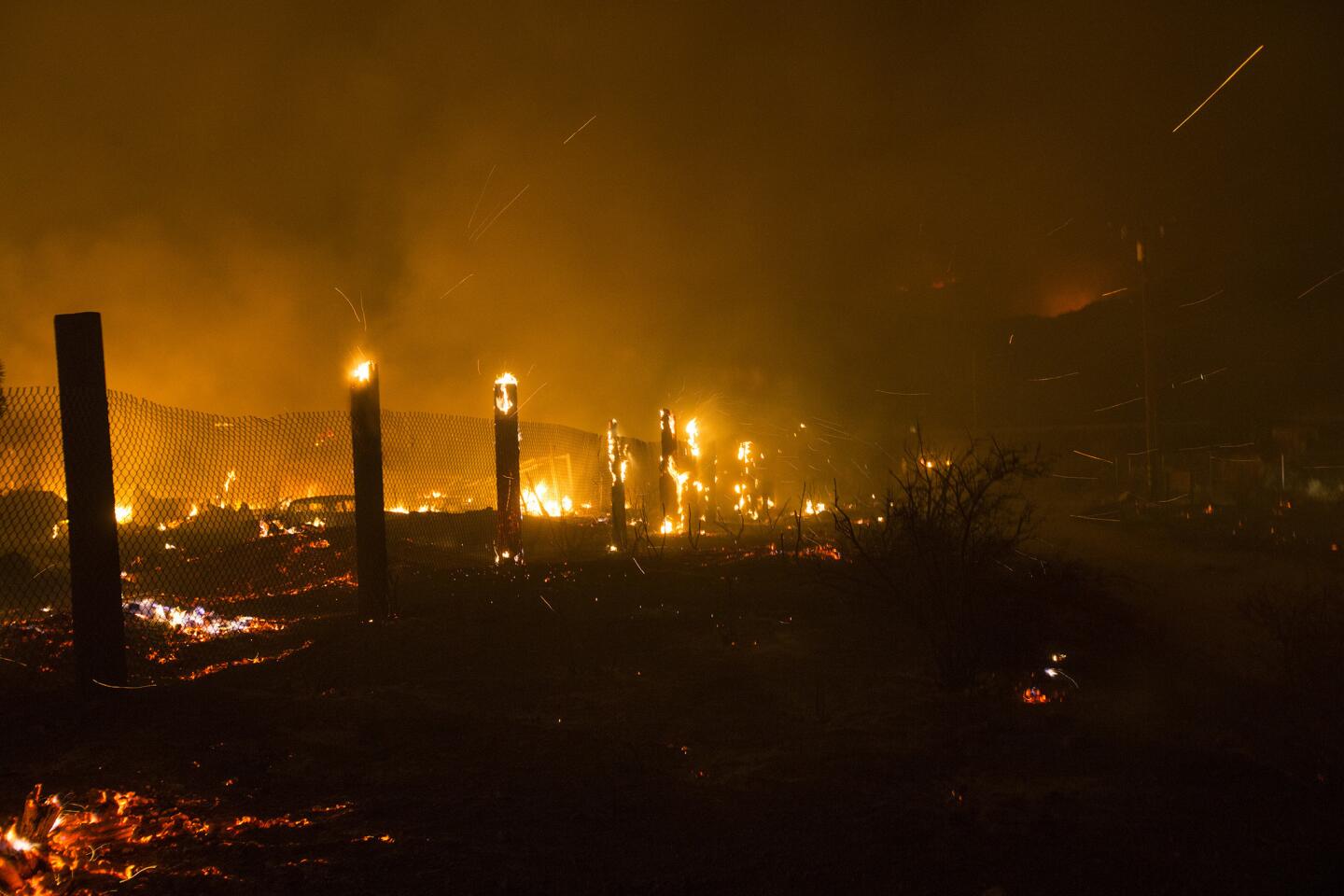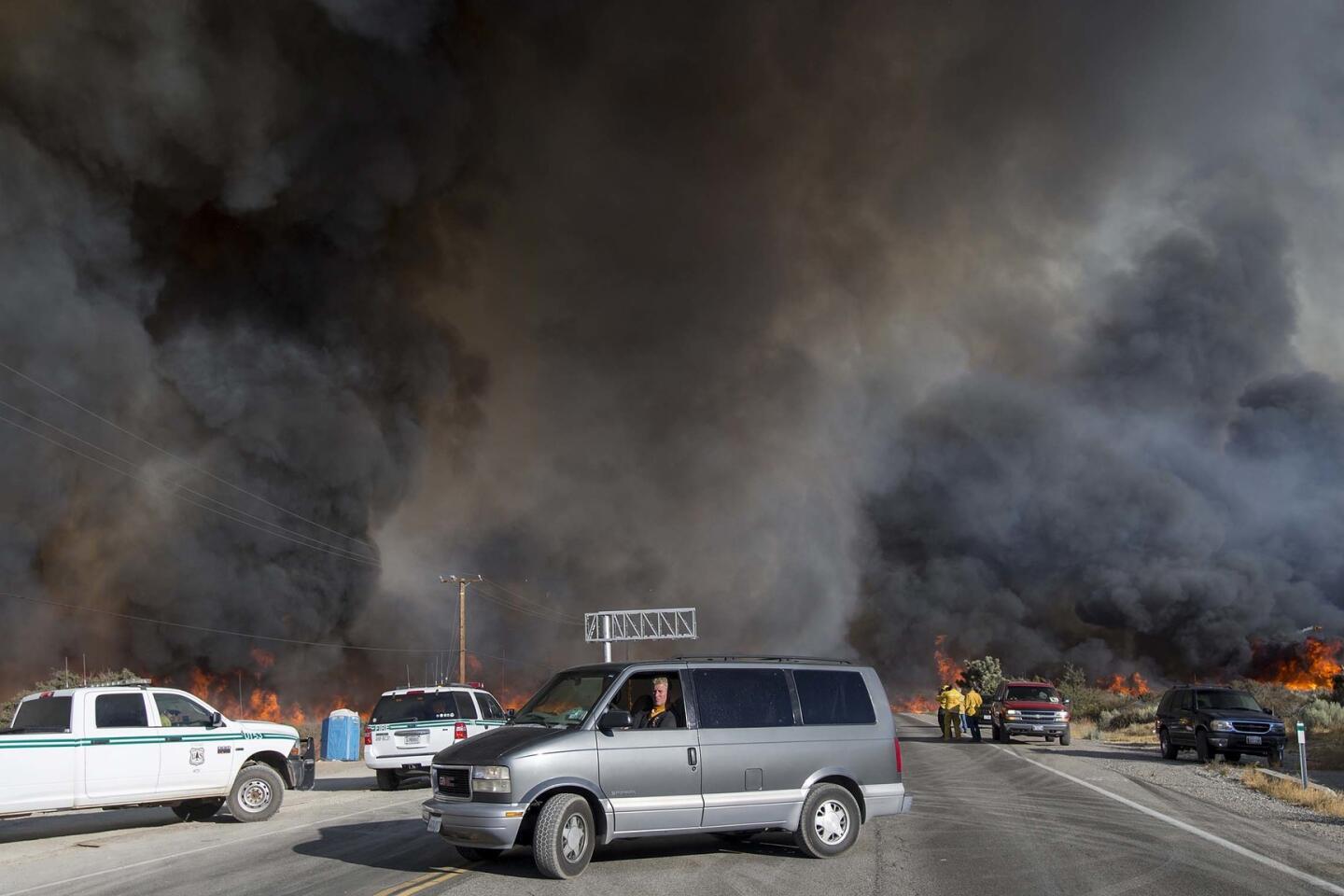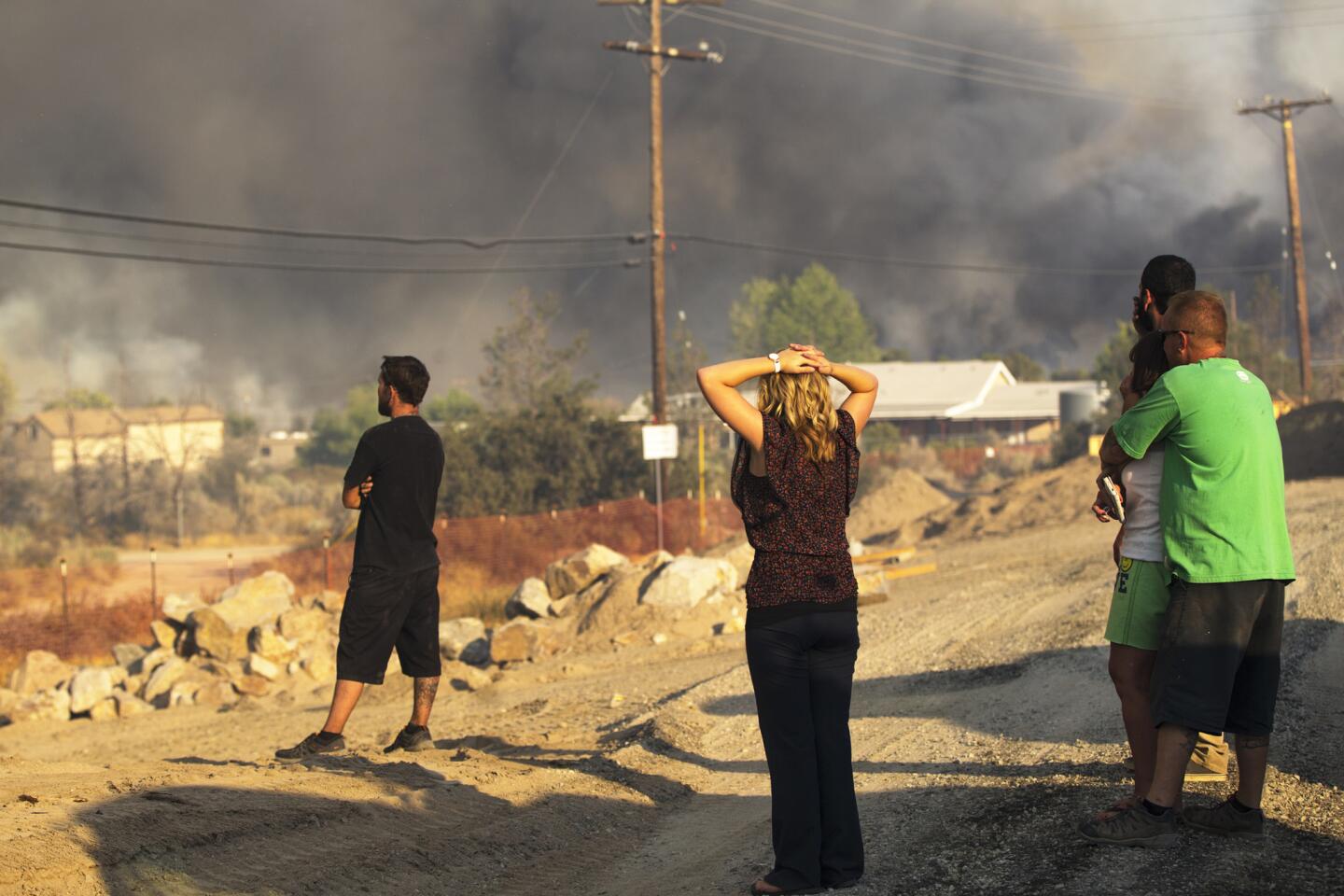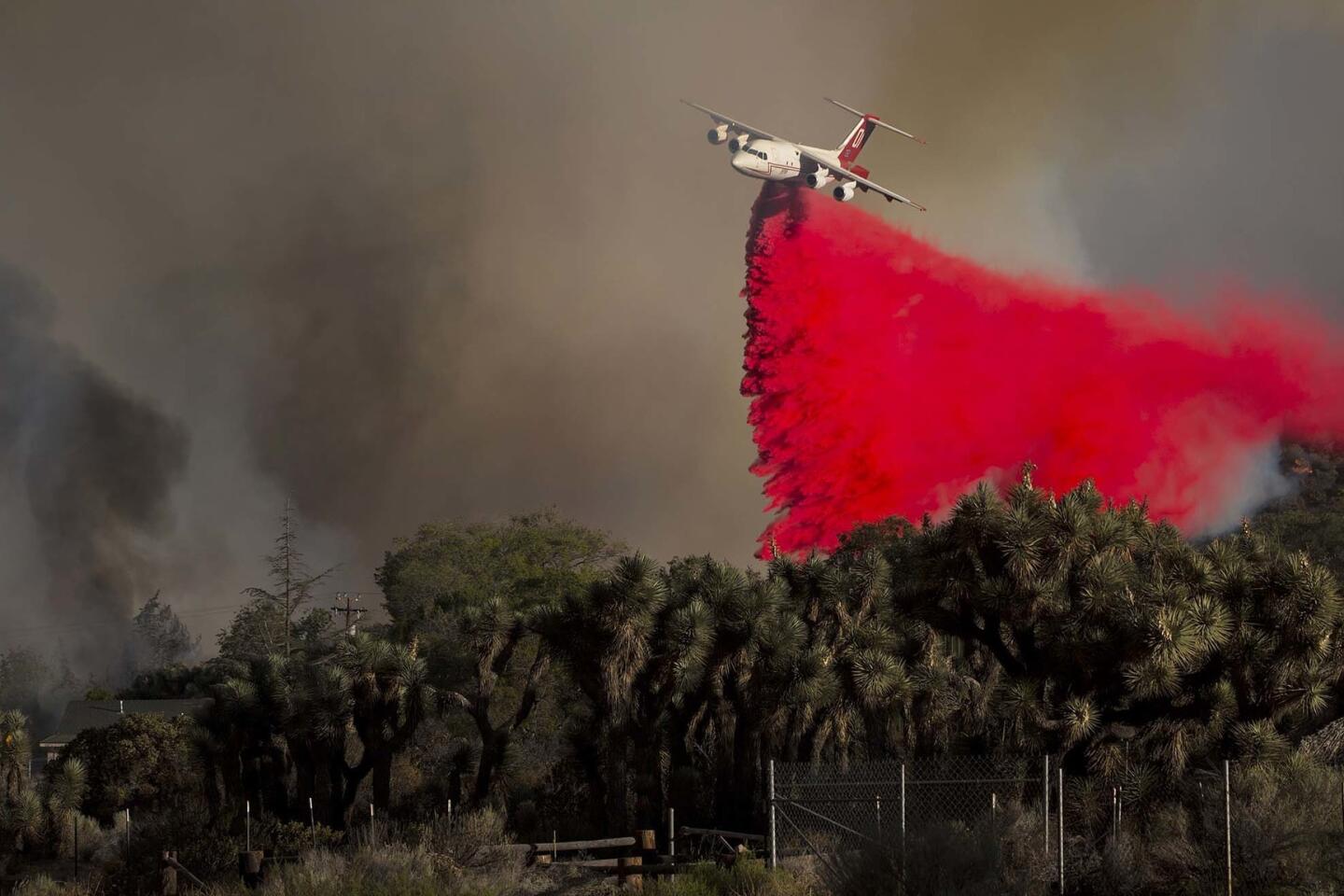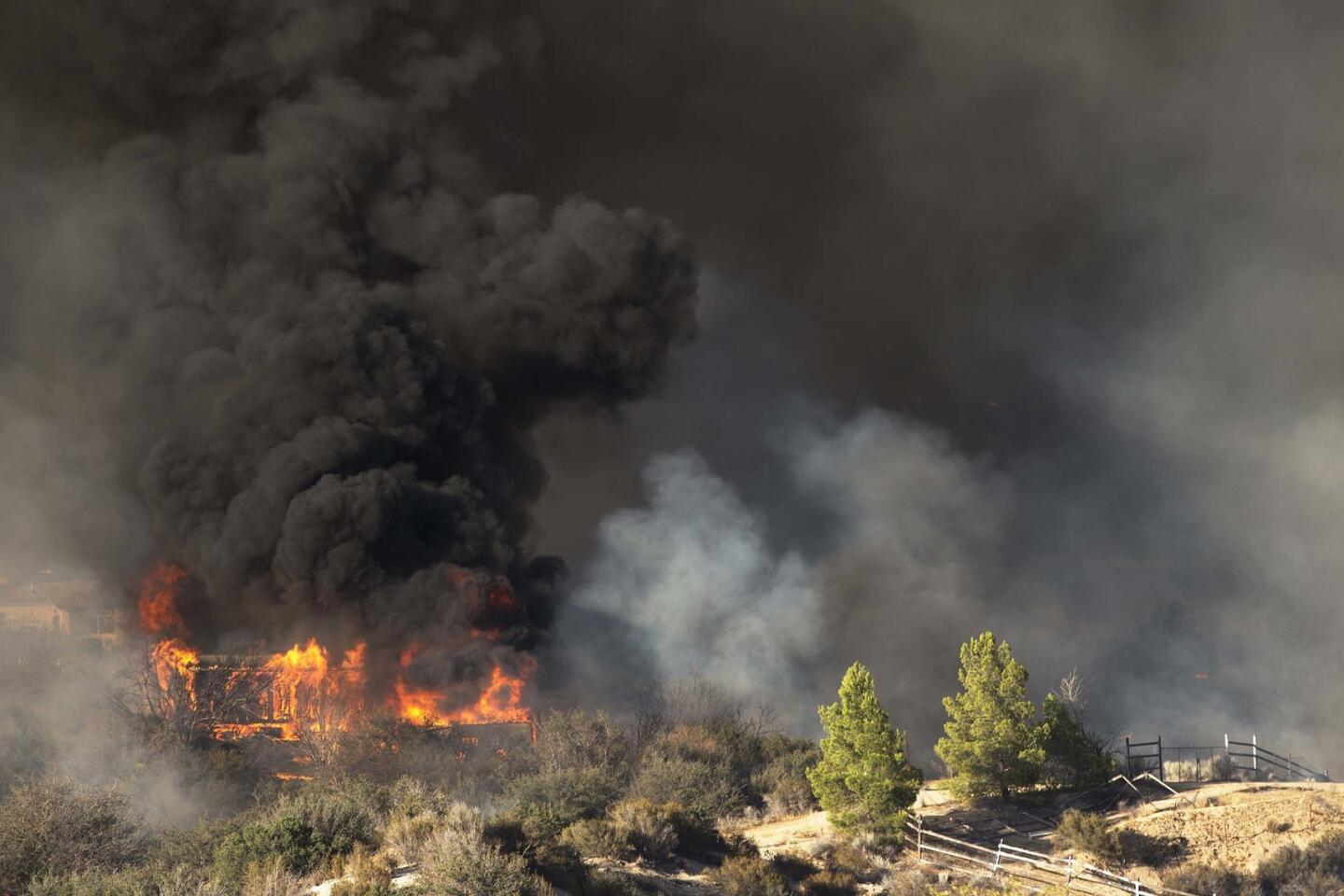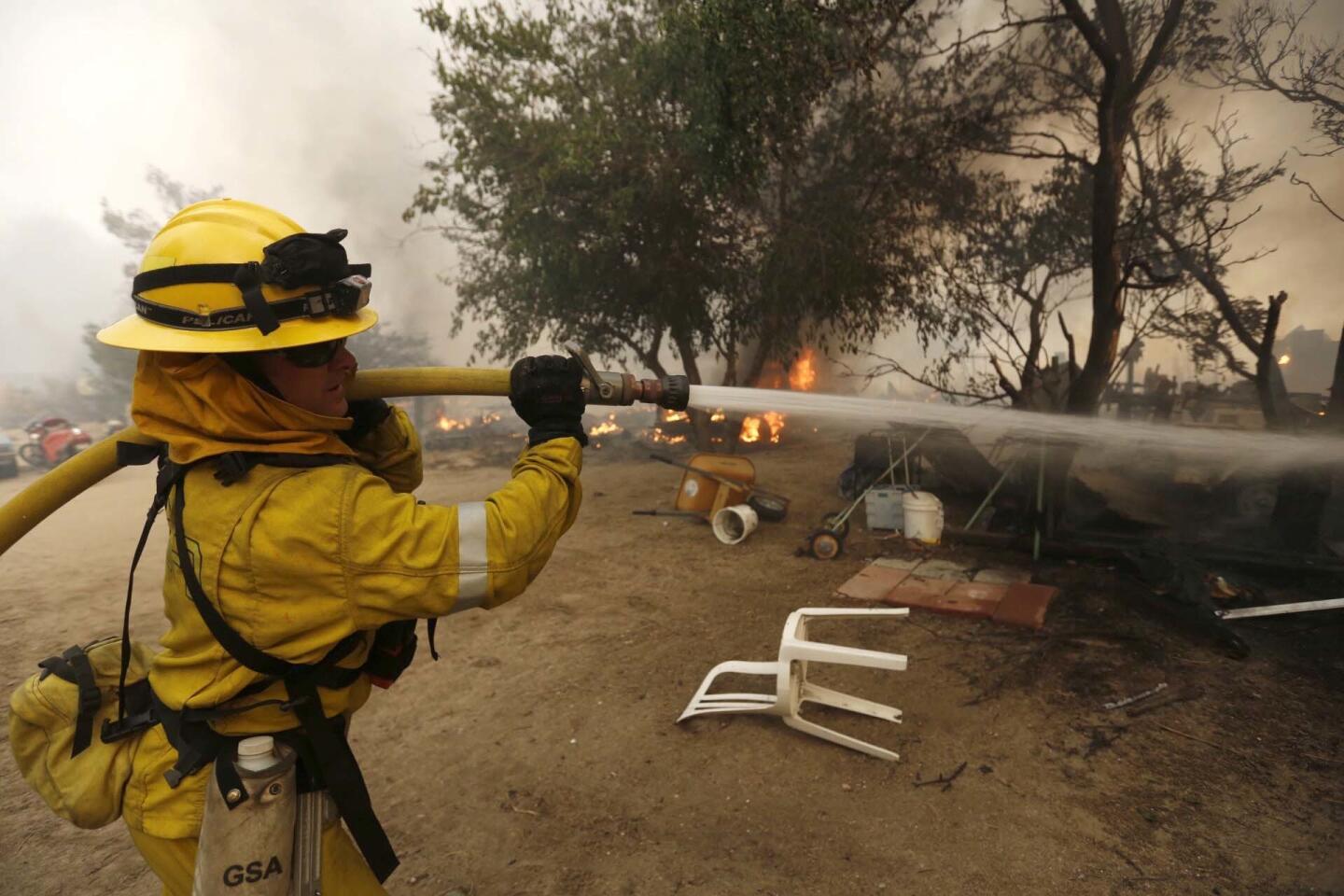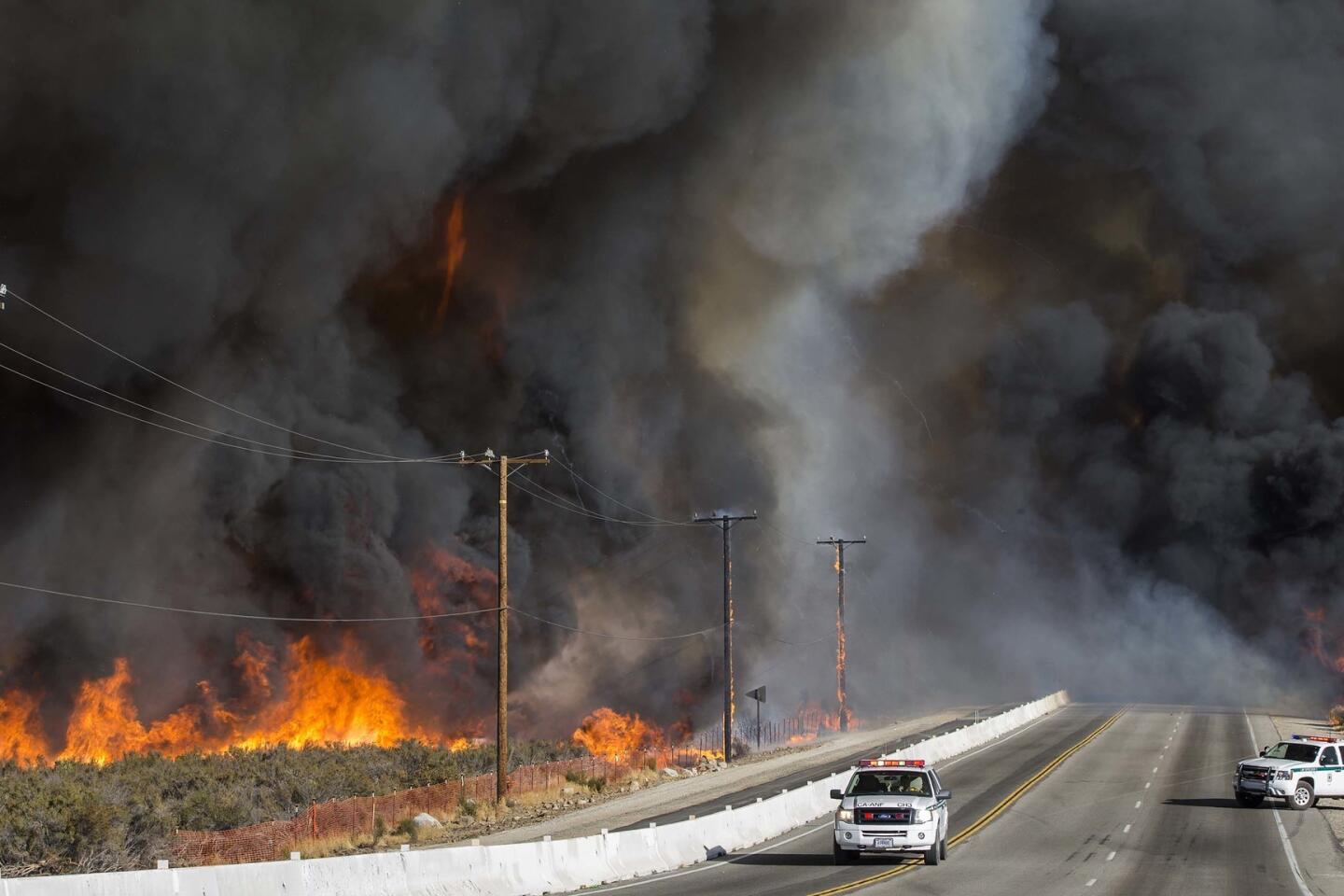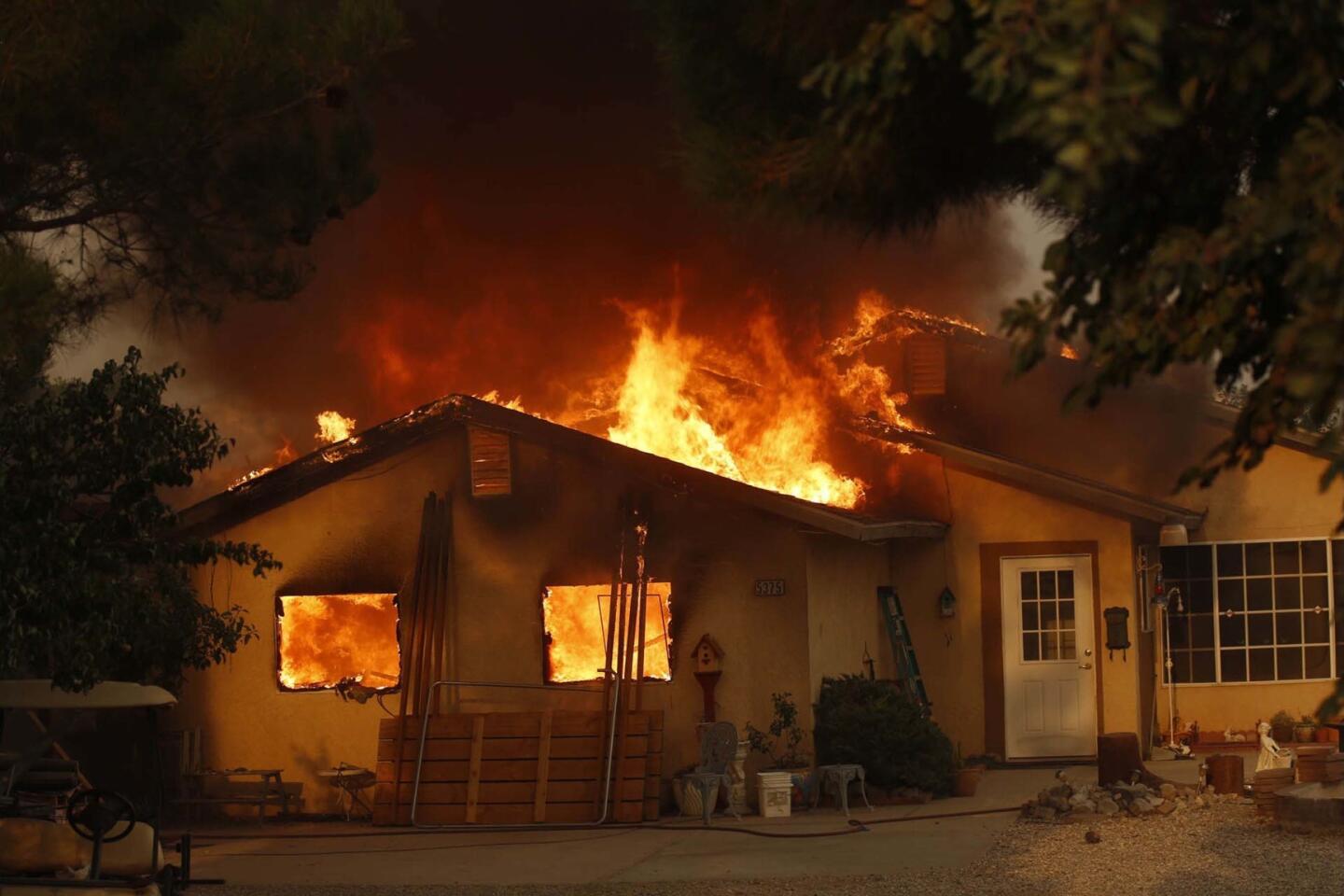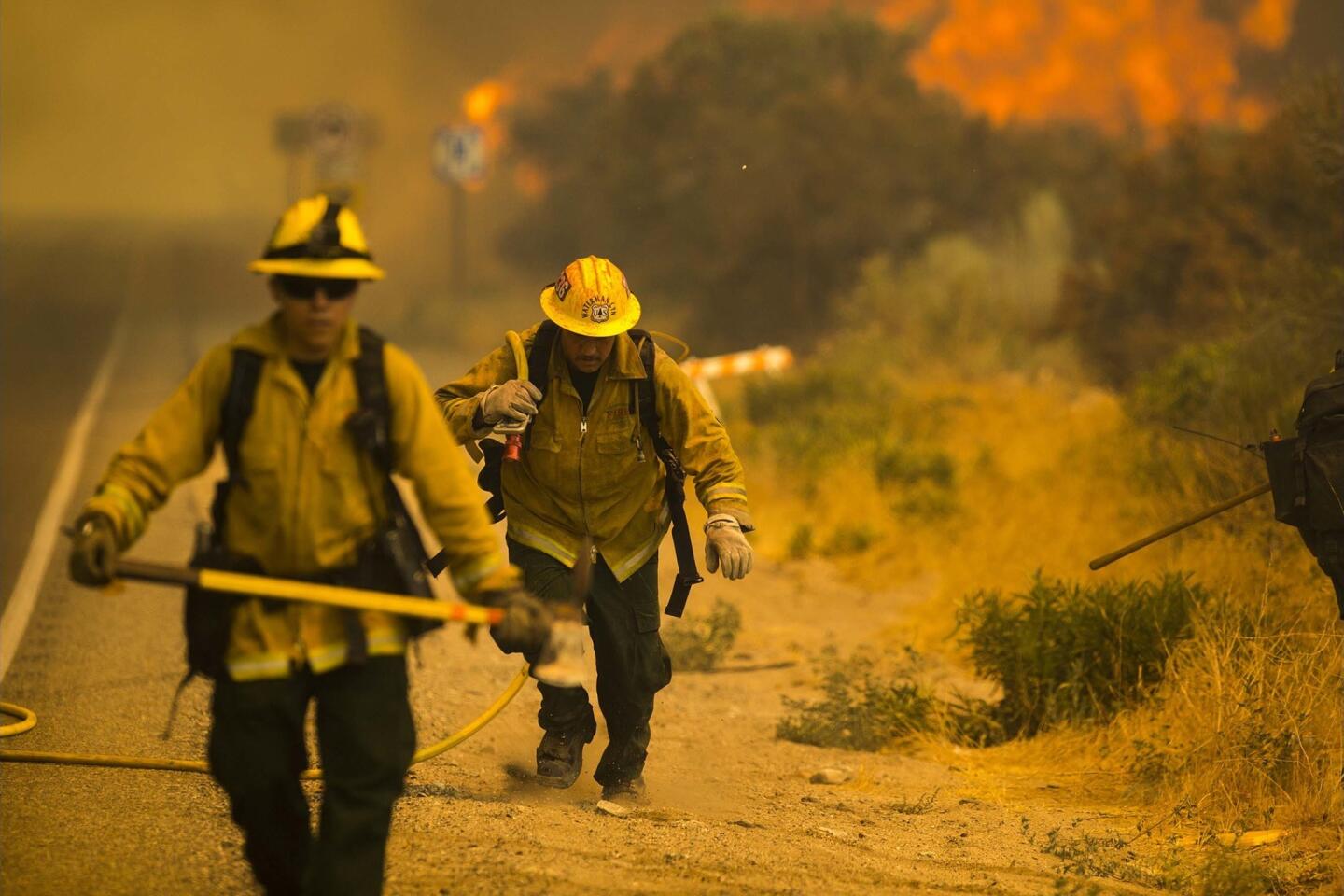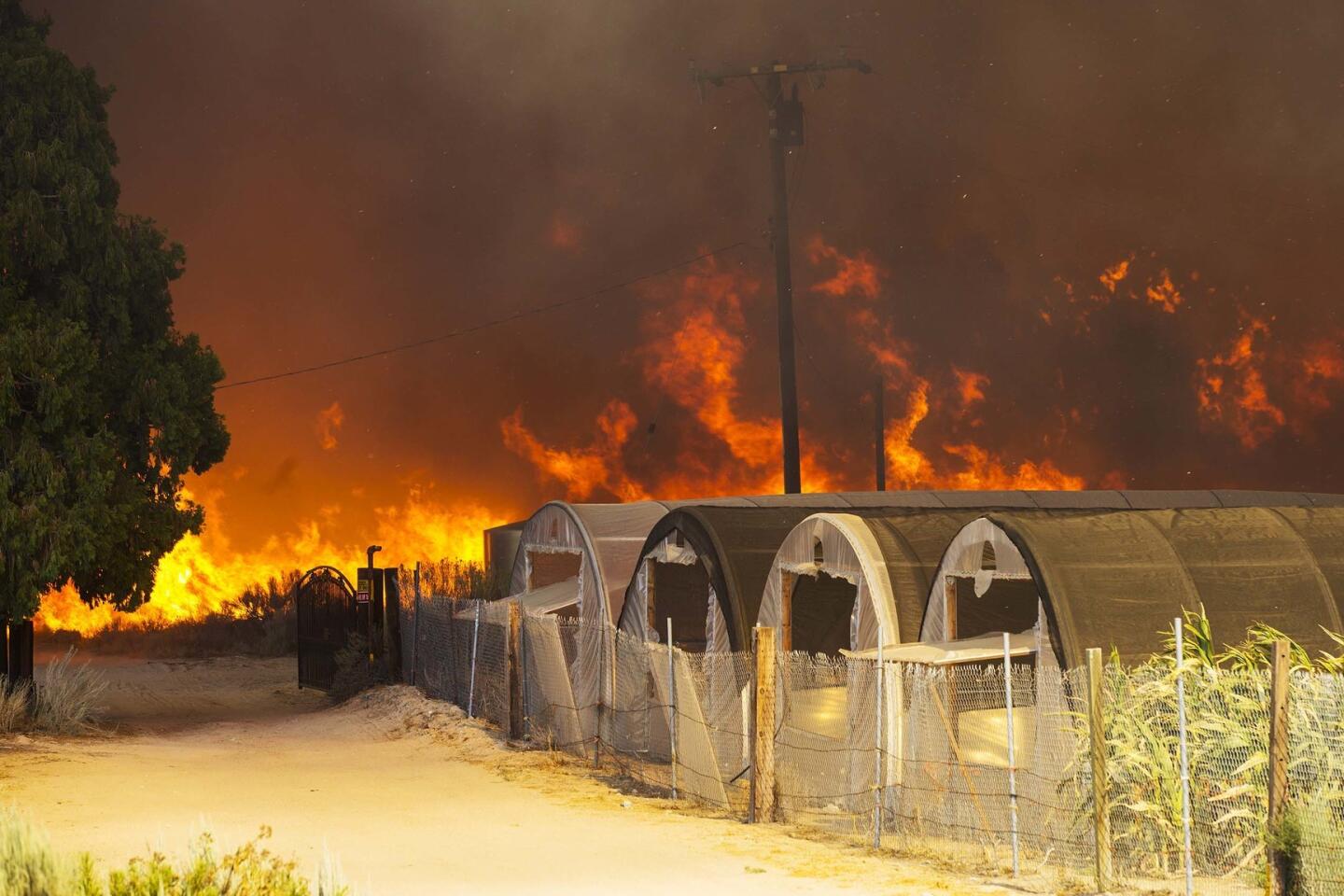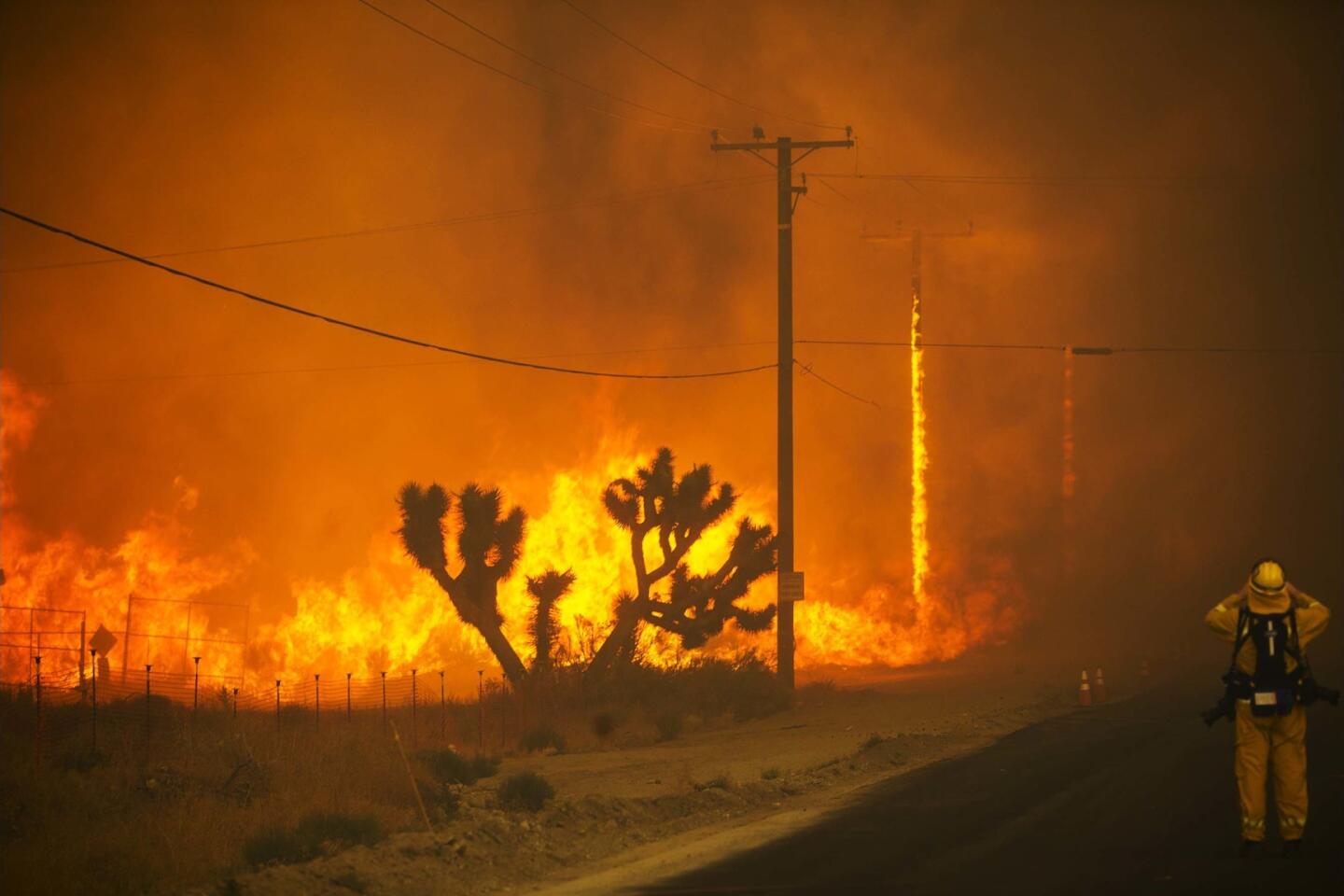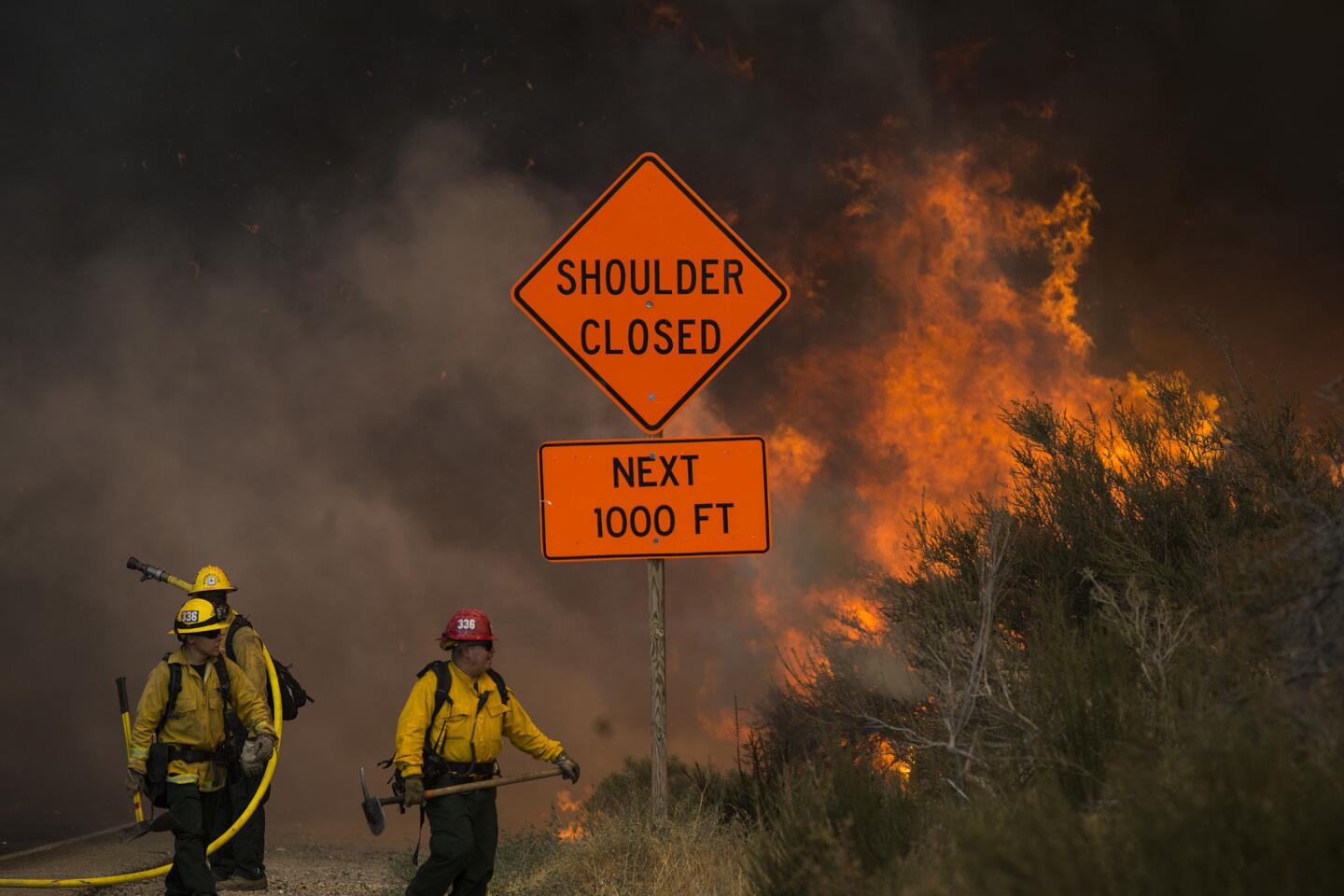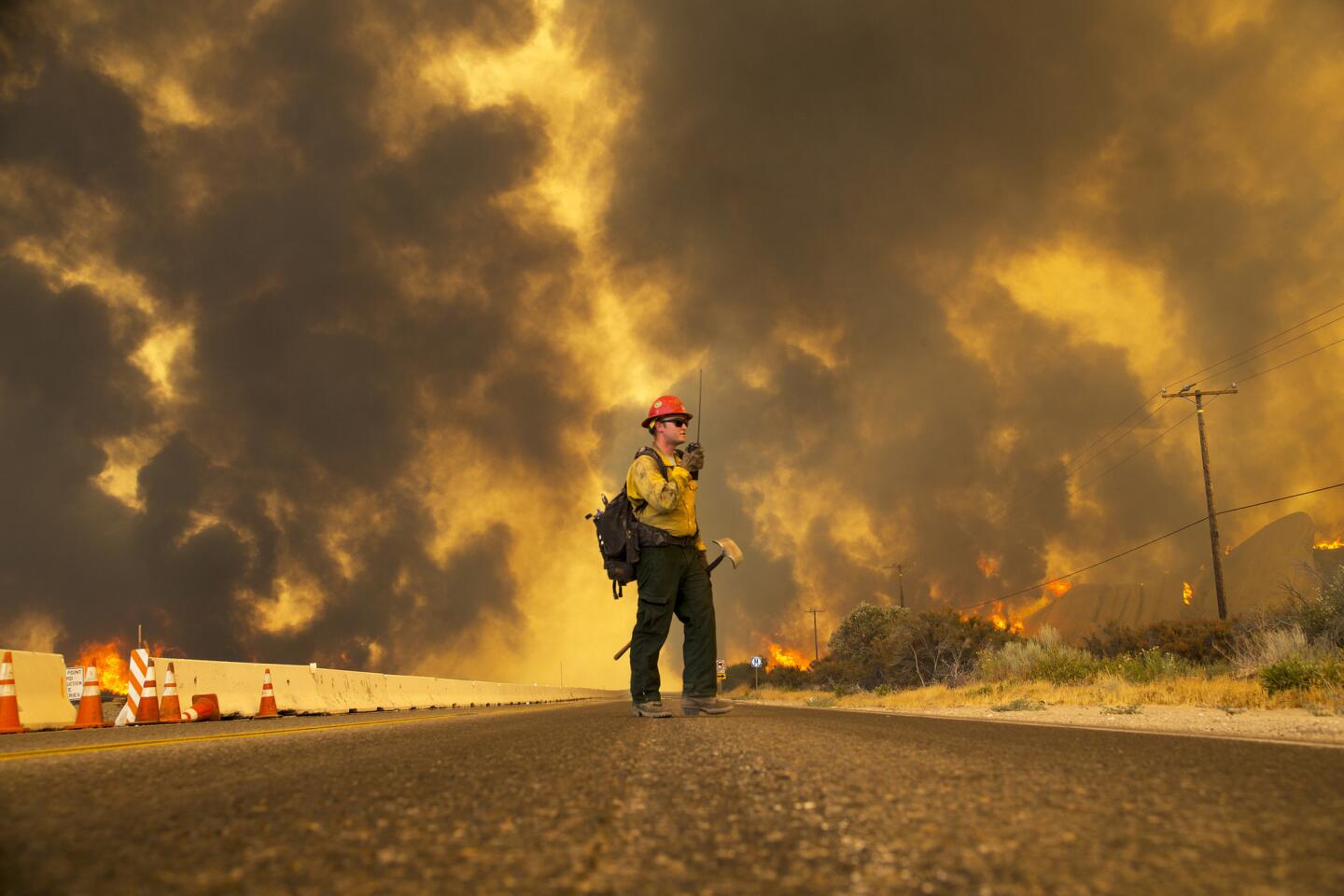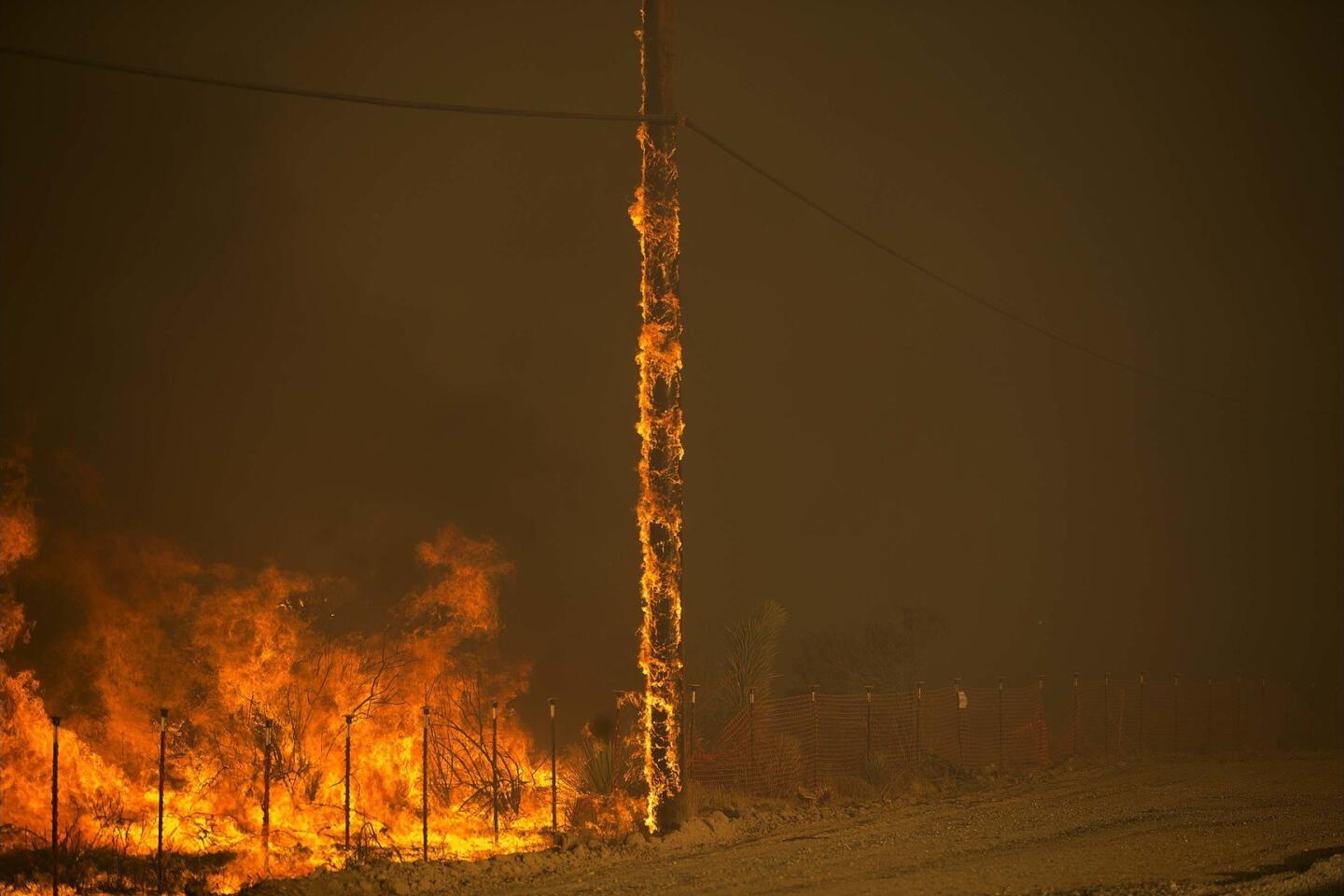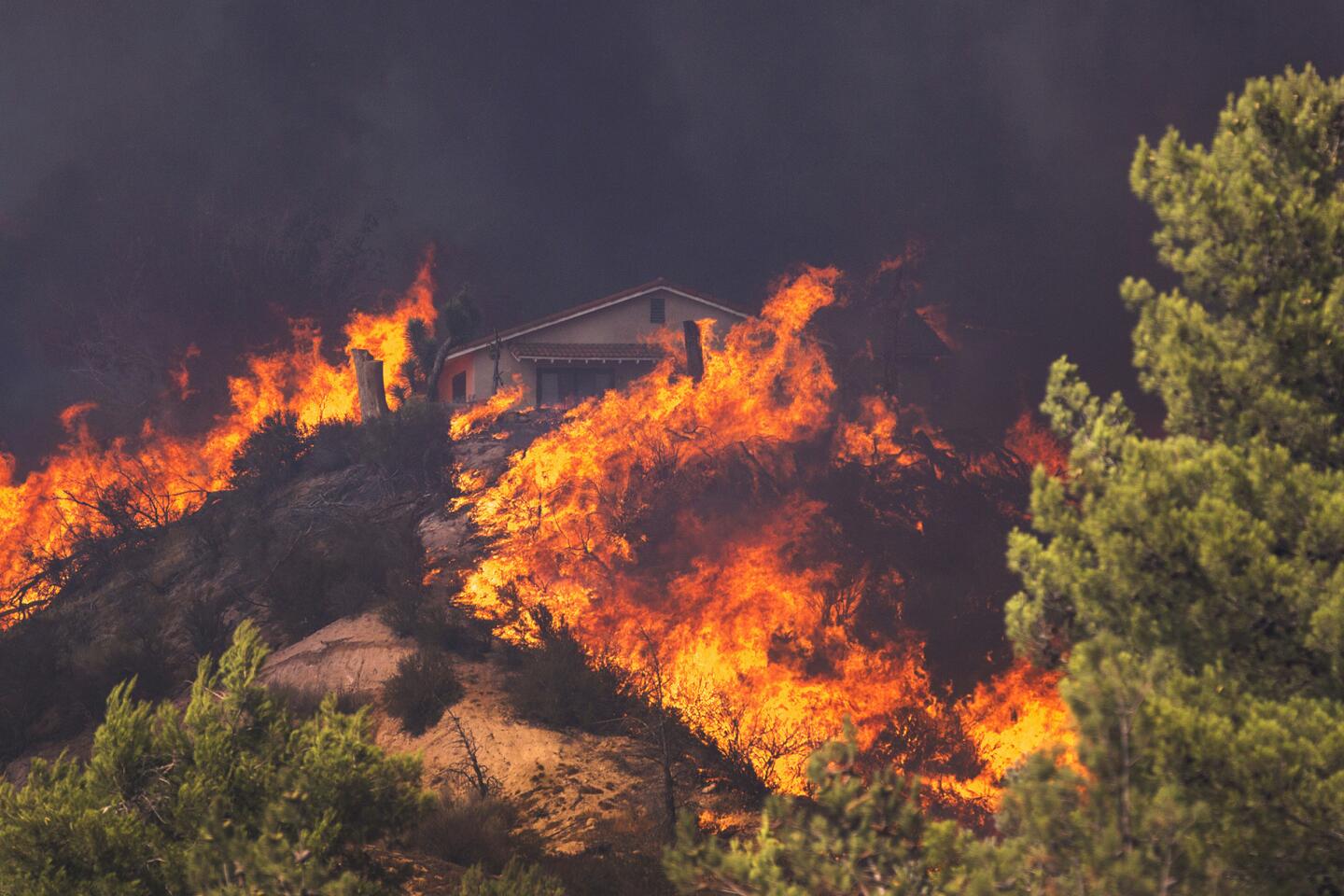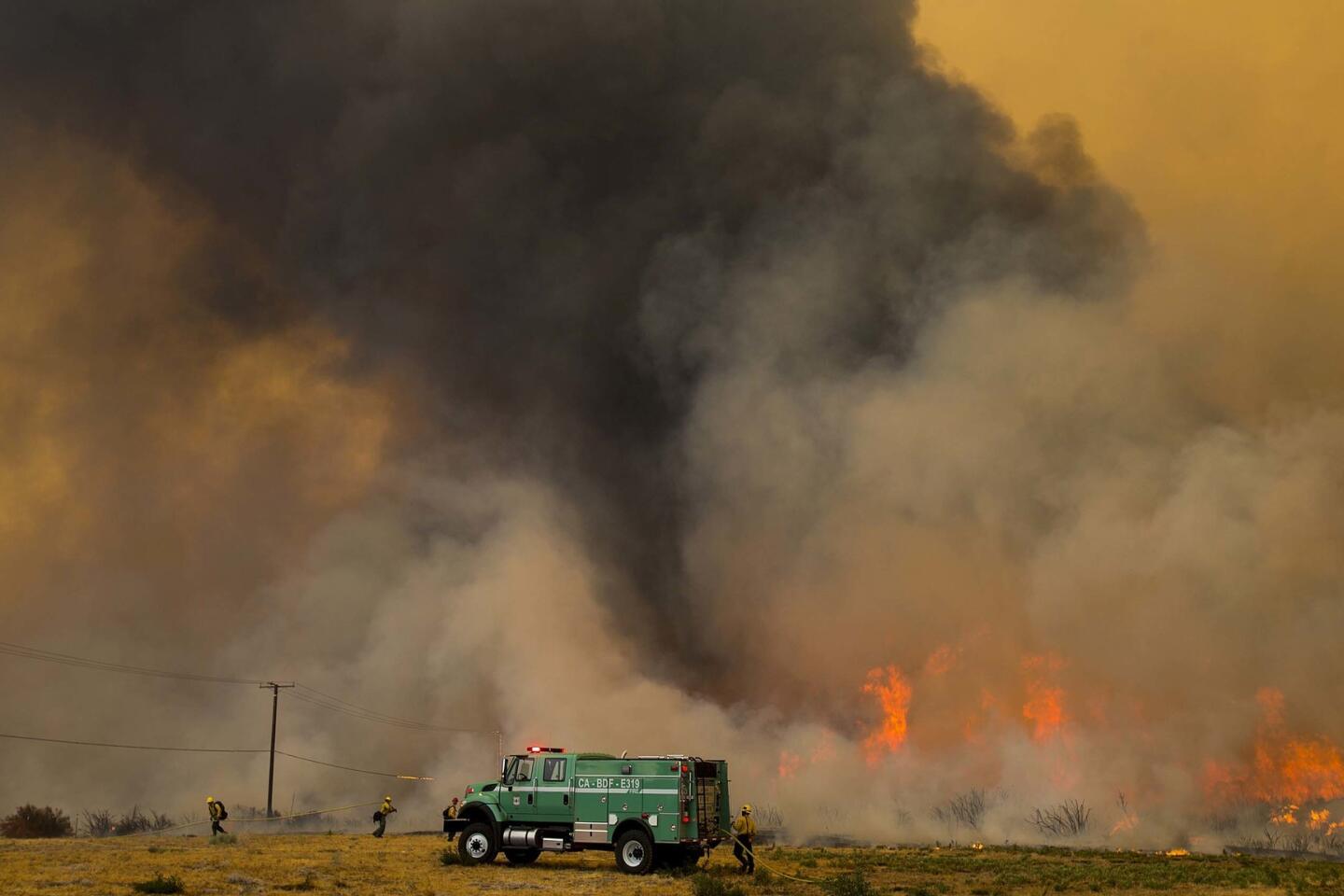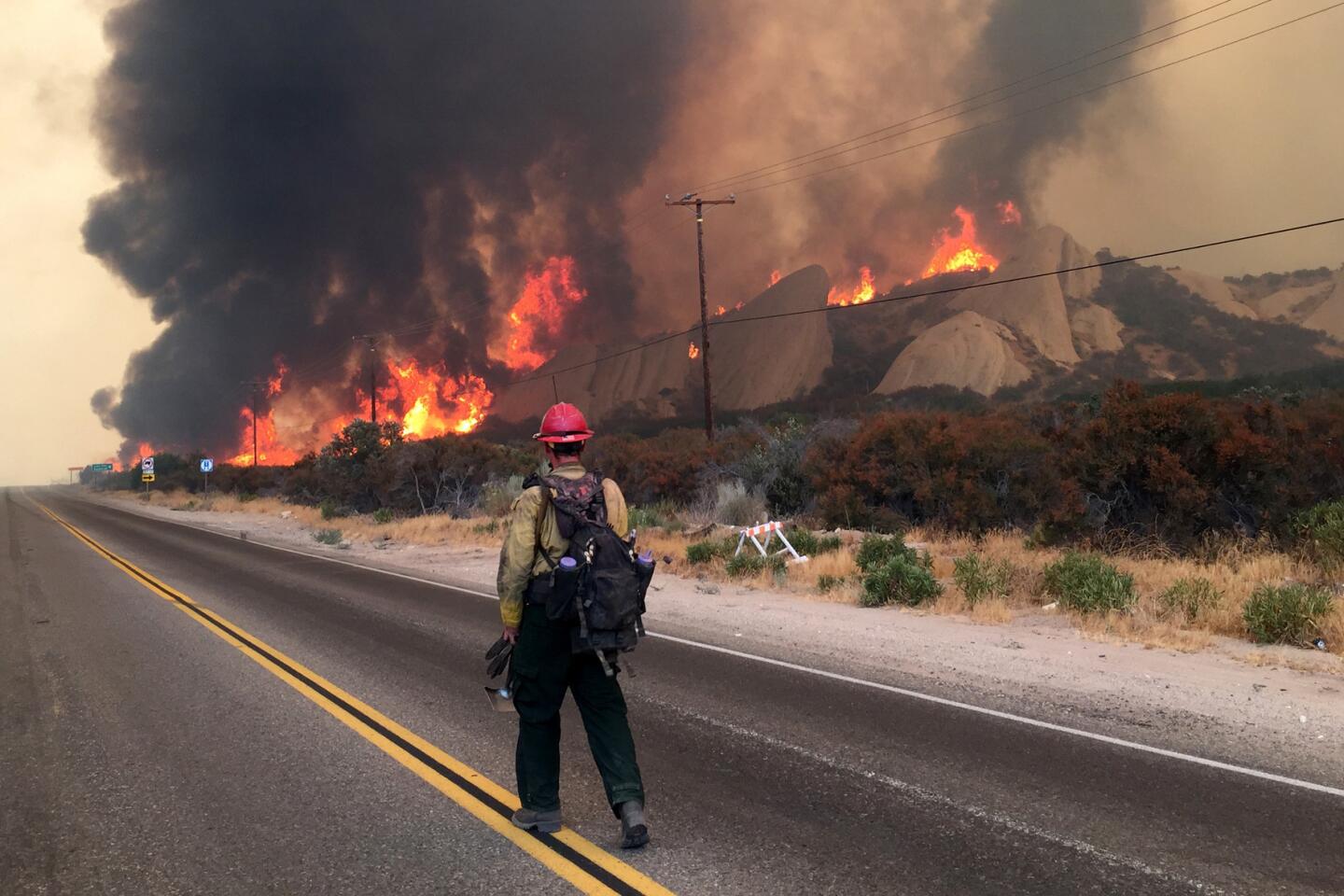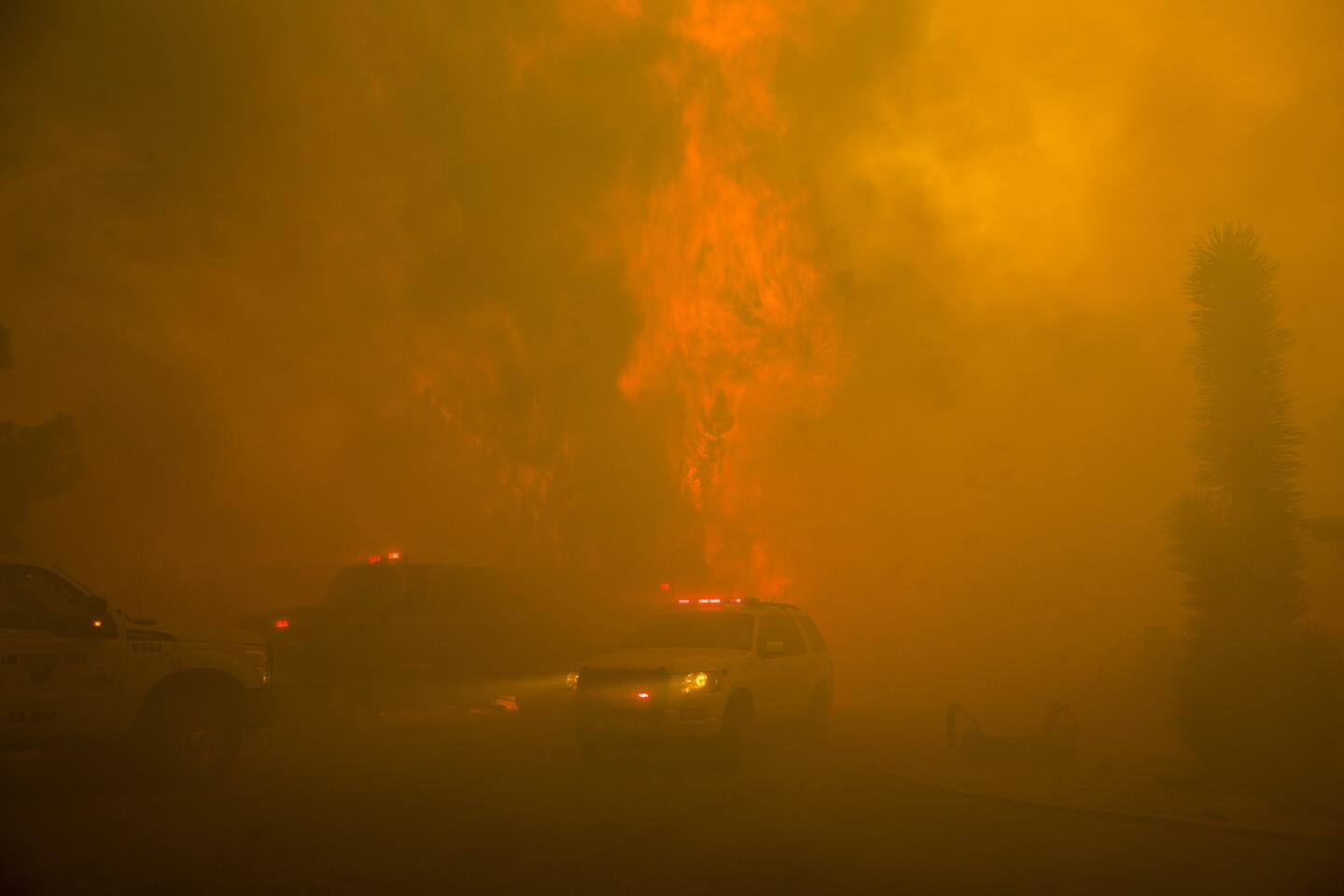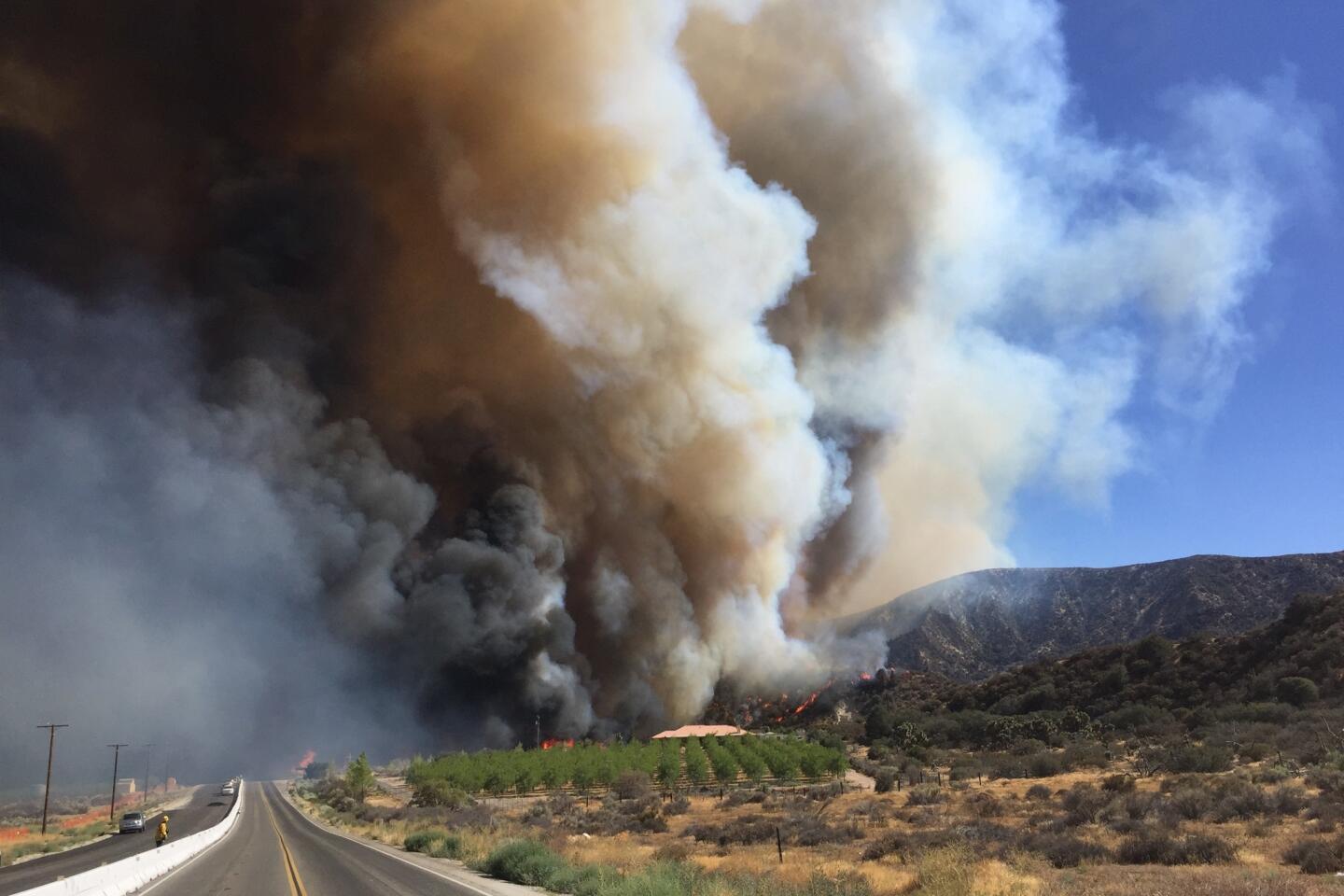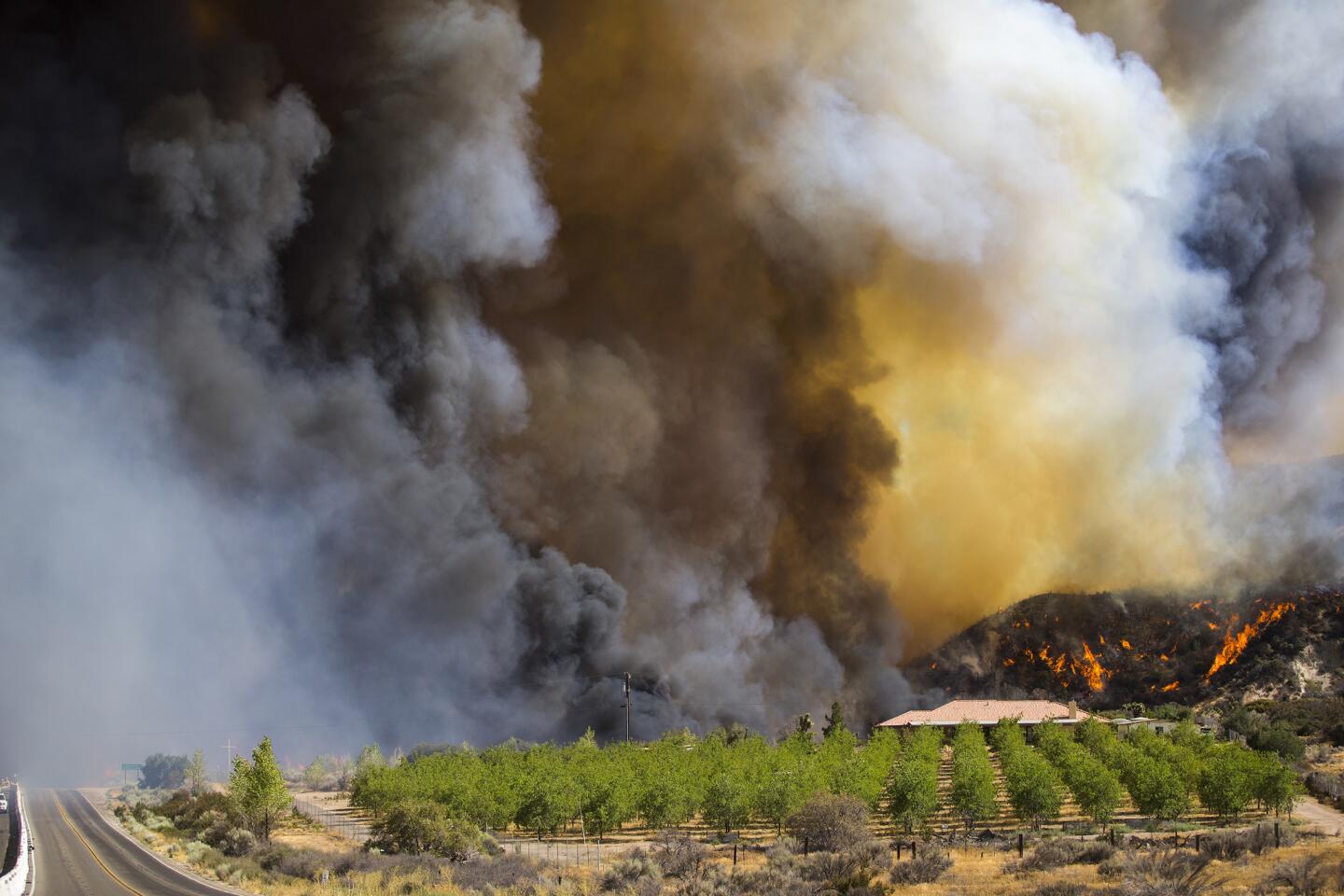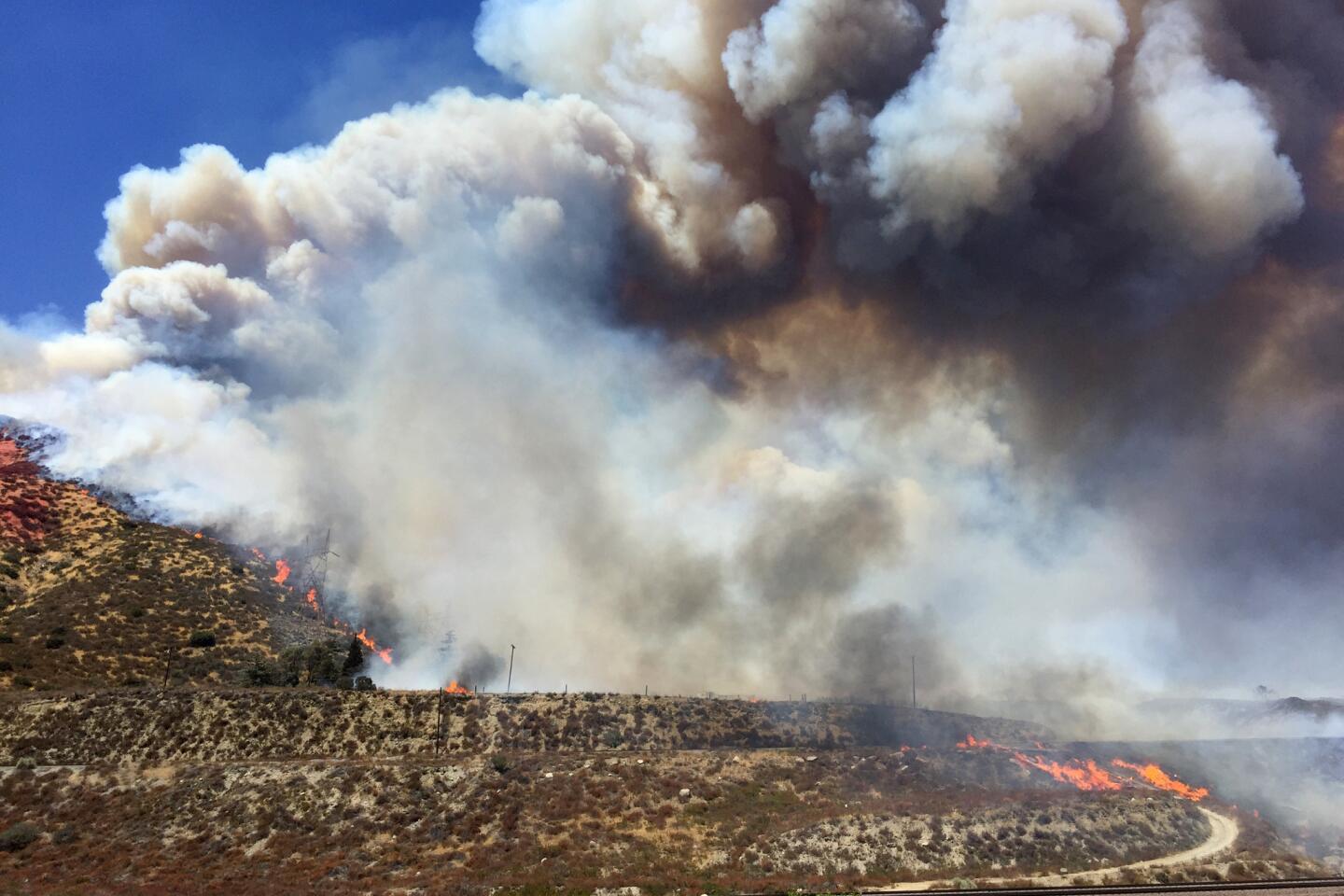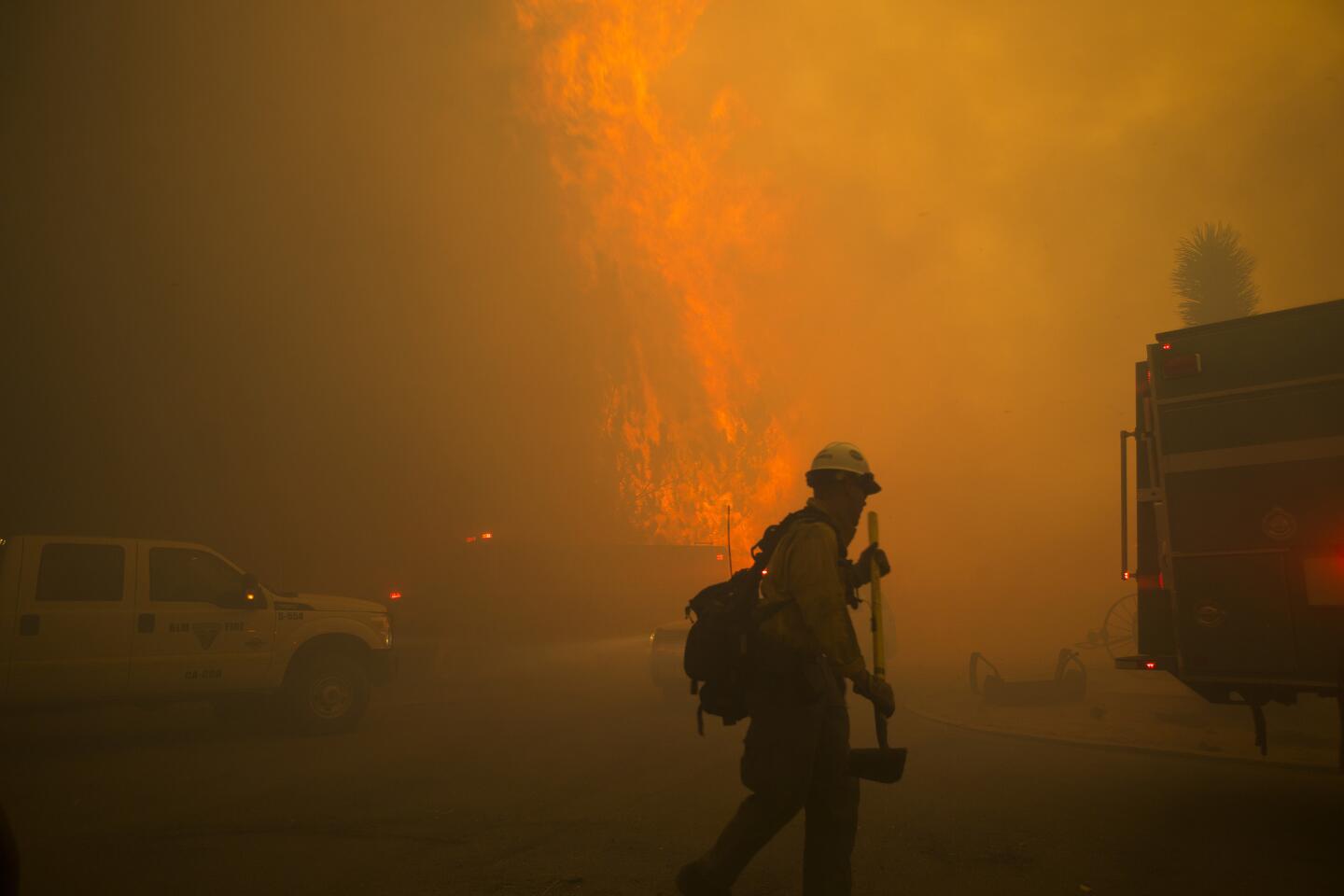Reporting from Lytle Creek — The tiny stone home was little more than a blackened shell. The only hint of its former occupants: a metal bed frame, a shattered toilet seat, charred tin cans.
Nestled along Lone Pine Canyon Road, a narrow, twisting thoroughfare, it was a bleak symbol of all that has surrendered to the raging fire that continues to terrorize the Cajon Pass.
But for all the devastation that the Blue Cut fire has wreaked, officials have had difficulty determining the damage left by explosive flames that quickly overtook nearly 36,000 acres.
Damage assessors have been hindered from surveying the destruction because of erratic fire behavior and intense flames that broke through retardants dropped by air crews, Eric Sherwin, an incident-response spokesman with the San Bernardino County Fire Department, said Thursday.
Fire swept through numerous remote hillsides and canyons, burning some structures to the ground but sparing others nearby.
Officials continue to say only that “numerous” buildings have been lost but are unable to estimate how many of those are homes. They said among the hardest hit were in West Cajon Valley and Swarthout Canyon, where deputies arrested three people suspected of stealing a vehicle from a residence.
On Thursday, there was a chilling silence in some areas where the fire had marched. The earth around a section of Highway 138 was scorched, power poles blackened, their wood splintered. A gentle wind stirred up ash, sending it swirling along the ruins.
A pinwheel spun in a backyard, near the smoldering carcass of a home. Nearby, in a garden, a sign creaked, swaying gently in the breeze.
“The kiss of the sun for pardon
The song of the birds for mirth
One is nearer God’s heart in a garden
Than any place else on earth”
Crews are now focused on communities west of the fire, such as Lytle Creek and the mountain resort town of Wrightwood, which is dotted with apartments and small homes and has the highest housing density in the area.
Firefighters have centered efforts on Lone Pine Canyon Road, the back door into Wrightwood, in hopes of preventing the blaze from jumping over the ridge. Still, gusty winds, high temperatures and low humidity persist and could create the same challenges that have haunted crews since the fire broke out Tuesday.
Although the Blue Cut fire calmed slightly overnight and halted its march north and east, it spread more than 4,000 acres Thursday, measuring 35,969 acres. The fire is just 22% contained, and a red flag warning remains in effect.
Some signs of progress were evident Thursday. Mandatory evacuations were lifted in several communities, and Caltrans reopened the 15 Freeway, a key trucking and commuter route that runs from San Diego, through the Inland Empire and across the Mojave Desert into Nevada. Its two-day closure had contributed to massive congestion, creating nightmares for both travelers and those trying to evacuate.
Raw video from Blue Cut fire near the Cajon Pass.
Highway 138, another major roadway in the area, was expected to remain closed until further notice, according to the CHP.
Along Lytle Creek Road on Thursday, sunlight highlighted fire retardant-covered ridges and caution tape fluttered in a light breeze outside evacuated homes.
Resident Maria Hadaway, who chose to stay, likened the deserted stillness to an episode of “SpongeBob SquarePants” in which the eponymous cartoon character wakes up alone in his town.
“That’s me. I’m SpongeBob in Bikini Bottom,” she said. “I’m hoping they let everyone [back] up here, because I don’t like being alone.”
Still in her pajamas, the 62-year-old sat in front of her home with a neighbor.
Hadaway said she stayed because of her dogs. She’s been feeding neighbors’ dogs as well, she said.
When authorities arrived to ask residents to evacuate, Hadaway locked the door, closed the drapes and didn’t answer.
1/88
About 10 buildings belonging to the Thanksgiving Korean Church were reduced to rubble by the Blue Cut fire.
(Irfan Khan / Los Angeles Times) 2/88
Miguel and Mabel Ramos, both 73, survey the devastation of the Blue Cut fire after it swept through their Oak Hills residence.
(Irfan Khan / Los Angeles Times) 3/88
Mabel Ramos, 73, is overcome by emotion upon seeing the devastation caused by the Blue Cut fire, which swept through her Oak Hills residence.
(Irfan Khan / Los Angeles Times) 4/88
Miguel Ramos holds a single chicken that survived after the Blue Cut fire swept through his Oak Hills property, burning the guest house and killing about 135 animals.
(Irfan Khan / Los Angeles Times) 5/88
A CalFire helicopter makes a water drop on still smoldering remnants of Blue Cut Fire on the hilltop ridges along Hwy 2 in Wrightwood.
(Irfan Khan / Los Angeles Times) 6/88
The Blue Cut fire continues to burn north of Lytle Creek in San Bernardino County.
(Marcus Yam / Los Angeles Times) 7/88
Ground crews put out errant fires that popped up near the train tracks in Keenbrook in San Bernardino County.
(Marcus Yam / Los Angeles Times) 8/88
A firefighting helicopter makes water drops to keep errant fires from approaching the train tracks near Interstate 15 at Keenbrook in San Bernardino County.
(Marcus Yam / Los Angeles Times) 9/88
Fire burns on the train tracks near Interstate 15 at Keenbrook in San Bernardino County.
(Marcus Yam / Los Angeles Times) 10/88
A firefighting helicopter drops water on glames getting close to the train tracks near Interstate 15 at Keenbrook in San Bernardino County.
(Marcus Yam / Los Angeles Times) 11/88
An abandoned structure sits in the path of the Blue Cut fire after it has passed through Lone Pine Canyon in San Bernardino County.
(Marcus Yam / Los Angeles Times) 12/88
A firefighting helicopter makes a water drop on a flare-up of the Blue Cut fire along Interstate 15 in the Cajon Pass on Thursday.
(Luis Sinco / Los Angeles Times) 13/88
The Blue Cut fire burns in the mountains of the San Bernardino National Forest, leaving charred vegetation in its wake near Wrightwood on Thursday.
(Luis Sinco / Los Angeles Times) 14/88
A firefighting helicopter flies through thick smoke as it makes a water drop on a flare-up of the Blue Cut fire along Interstate 15 in the Cajon Pass.
(Luis Sinco / Los Angeles Times) 15/88
A dust cyclone swirls through a charred moonscape left by the Blue Cut fire near Wrightwood.
(Luis Sinco / Los Angeles Times) 16/88
Scott Steele of the Beverly Hills Fire Department comforts one of two dogs hurt in the Blue Cut fire next to a burned structure on Monte Vista Road in Phelan.
(Irfan Khan / Los Angeles Times) 17/88
Jaime Jungle, left, and Chris Schreiner from San Bernardino County Animal Control carry one of two dogs hurt by the Blue Cut fire at a burned-out structure on Monte Vista Road in Phelan.
(Irfan Khan / Los Angeles Times) 18/88
A light pole with plastic globes melted in the heat of the Blue Cut fire stands along Tamarind Avenue in Phelan.
(Irfan Khan / Los Angeles Times) 19/88
Fire crews are busy mopping up hot spots from the Blue Cut fire on Highway 2 on the way to Wrightwood.
(Irfan Khan / Los Angeles Times) 20/88
A helicopter makes a water drop in very dense smoke from Blue Cut Fire smoldering in the hills along Highway 2 near Wrightwood.
(Irfan Khan / Los Angeles Times) 21/88
Smoldering hillside from Blue Cut fire along Highway 2 near Wrightwood.
(Irfan Khan / Los Angeles Times) 22/88
Work crew prepare to repair downed power lines damaged by the Blue Cut fire on Highway 138 at the junction of 15 Freeway.
(Irfan Khan / Los Angeles Times) 23/88
The Blue Cut fire grew to more than 31,000 acres Thursday morning. (Marcus Yam / Los Angeles Times )
24/88
A car destroyed by the Blue Cut wildfire in Phelan, California.
(JONATHAN ALCORN / AFP/Getty Images) 25/88
A firefighter douses the Blue Cut fire burning alongside Lytle Creek Road on Wednesday night.
(Marcus Yam / Los Angeles Times) 26/88
Firefighters attack the Blue Cut fire as it burns along Lytle Creek Road on Wednesday night.
(Marcus Yam / Los Angeles Times) 27/88
Firefighters work to defend structures on Lytle Creek Road on Wednesday night. (Marcus Yam / Los Angeles Times)
28/88
A firefighter monitors the Blue Cut fire on the side of Lytle Creek Road on Wednesday night.
(Marcus Yam / Los Angeles Times) 29/88
A firefighter works to defend structures on Lytle Creek Road on Wednesday night.
(Marcus Yam / Los Angeles Times) 30/88
Firefighters set back fires on Lytle Creek Road on Wednesday night. (Marcus Yam / Los Angeles Times)
31/88
With a full moon in the background, firefighters monitor the Blue Cut fire along Lytle Creek Road on Wednesday night. (Marcus Yam / Los Angeles Times)
32/88
A firefighting helicopter drops water on a hillside to battle the Blue Cut fire west of Interstate 15 on Wednesday in Devore.
(Gina Ferazzi / Los Angeles Times) 33/88
Smoke from the Blue Cut fire burns over Interstate 15 on Wednesday in Devore.
(Gina Ferazzi / Los Angeles Times) 34/88
Firefighters work to extinguish flames on Cajon Blvd along the interstate 15, in San Bernardino County on Aug. 17.
(Marcus Yam / Los Angeles Times) 35/88
A firefighter battles the Blue Cut fire in thick brush along Lytle Creek Road.
(Luis Sinco / Los Angeles Times) 36/88
CalFire firefighters keep watch on the Blue Cut fire as it roars on a hillside above Sheep Canyon Road on Wednesday in Lytle Creek. (Gina Ferazzi / Los Angeles Times)
37/88
A sky crane drops water on the Blue Cut Fire to keep it from crossing Lytle Creek Road on Wednesday in Lytle Creek. (Gina Ferazzi / Los Angeles Times)
38/88
Lytle Creek residents check-in at the evacuation center set up at the Jessie Turner Health & Fitness Center on Wednesday in Fontana. (Gina Ferazzi / Los Angeles Times)
39/88
The Blue Cut fire burns close to Wrightwood. (Irfan Khan / Los Angeles Times)
40/88
Firefighters work around the Blue Cut fire near Wrightwood. (Irfan Khan / Los Angeles Times)
41/88
The Blue Cut fire burns a hillside near Wrightwood. (Irfan Khan / Los Angeles Times)
42/88
Firefighting helicopters battle the Blue Cut fire as it burns out of control around the community of Lytle Creek.
(Luis Sinco / Los Angeles Times) 43/88
Lytle Creek residents Nico and Dalia Santucci prepare to evacuate as the Blue Cut fire burns near their home.
(Luis Sinco / Los Angeles Times) 44/88
A firefighting helicopter drops water on the Blue Cut fire as it burns above Lytle Creek on Wednesday.
(Luis Sinco / Los Angeles Times) 45/88
Air tanker drops fire retardant near residences threatened by Blue Cut Fire along Highway 2 Wednesday afternoon.
(Irfan Khan / Los Angeles Times) 46/88
A structure is engulfed in flames as the Blue Cut fire burns out of control in Lytle Creek.
(Luis Sinco / Los Angeles Times) 47/88
A firefighting airplane drops fire retardant on the Blue Cut fire in the foothills of the San Bernardino National Forest.
(Luis Sinco / Los Angeles Times) 48/88
Towering flames of the Blue Cut fire burn out of control in the foothills of the San Bernardino National Forest above Lytle Creek.
(Luis Sinco / Los Angeles Times) 49/88
A firefighting helicopter drops water on bruning brush as the Blue Cut fire burns out of control in the foothills of the San Bernardino National Forest on Wednesday.
(Luis Sinco / Los Angeles Times) 50/88
The Blue Cut fire exploded out of control Tuesday in the Cajon Pass, scorching 30,000 acres and destroying an unknown number of homes in several rural San Bernardino County communities.
(Irfan Khan / Los Angeles Times) 51/88
David Pearson, who lives on Lone Pine Canyon Road, decided to stay at home in Wrightwood as long as conditions allowed.
(Irfan Khan / Los Angeles Times) 52/88
Firefighter Bryan Hagan and Pegi Fall, standing along Lone Pine Canyon Road, watch as the Blue Cut fire approaches Wrightwood. Fall has decided to stay as long as conditions allow.
(Irfan Khan / Los Angeles Times) 53/88
The Blue Cut fire exploded out of control Tuesday in the Cajon Pass, scorching 30,000 acres and forcing over 80,000 to evacuate.
(Irfan Khan / Los Angeles Times) 54/88
A cat wandering around jumps way from hot surface and flames emitting at still smoldering structure at Hess Road.
(Irfan Khan / Los Angeles Times) 55/88
Destruction brought by Blue Cut fire on Hess Road in Phelan.
(Irfan Khan / Los Angeles Times) 56/88
Smoke rises out from underneath railroad tracks at a damaged bridge near the Interstate 15 damaged by the Blue Cut fire burning in San Bernardino County.
(Marcus Yam / Los Angeles Times) 57/88
Michelle Keeney and her husband, Scott, salvage some old signs from gutted Summit Inn Wednesday morning. Michelle Keeney is the manager of the restaurant destroyed in the fire.
(Irfan Khan / Los Angeles Times) 58/88
Spot fire continue to burn in what remains of the gutted Summit Inn at the junction of the 15 Freeway and Highway 138 Wednesday morning.
(Irfan Khan / Los Angeles Times) 59/88
A melted sign from a McDonald’s restaurant shows the damage as firefighters check the area after the Blue Cut fire swept through Cajon Junction.
(EUGENE GARCIA / EPA) 60/88
Burned homes and vehicles are left in the wake of the Blue Cut Fire that broke out in Devore near the Cajon Pass on Aug. 16, 2016.
(Francine Orr / Los Angeles Times) 61/88
Burned homes and vehicles are left in the wake of the Blue Cut fire that broke out in Devore near the Cajon Pass on Aug. 16, 2016.
(Francine Orr / Los Angeles Times) 62/88
Smoke from the Blue Cut fire that broke out in Devore near the Cajon Pass and quickly spread on Aug. 16, 2016.
(Francine Orr / Los Angeles Times) 63/88
Fire continues to burn along Highway 138, in San Bernardino County.
(Marcus Yam / Los Angeles Times) 64/88
During the night, a portion of the Blue Cut fire burns along Interstate 15.
(Marcus Yam / Los Angeles Times) 65/88
A firefighter returns to his vehicle as fire continue to burn along Highway 138 in San Bernardino County.
(Marcus Yam / Los Angeles Times) 66/88
The Blue Cut fire still burns out of control into the evening off Highway 138 in Summit Valley, Calif.
(Gina Ferazzi / Los Angeles Times) 67/88
Winds blow hot embers along a burning fence line as the Blue Cut fire torches the landscape into the evening off Highway 138 in Summit Valley.
(Gina Ferazzi / Los Angeles Times) 68/88
Motorists flee The Blue Cut fire as it burns out of control on both sides of Highway 138 in Summit Valley.
(Gina Ferazzi / Los Angeles Times) 69/88
Residents watch in despair as the Blue Cut fire burns homes on the hillside off Highway 138 in Summit Valley, California.
(Gina Ferazzi / Los Angeles Times) 70/88
An air tanker drops fire retardant near homes as the Blue Cut fire burns out of control on both sides of Highway 138 in Summit Valley, California.
(Gina Ferazzi / Los Angeles Times) 71/88
A home is engulfed in flames as the Blue Cut fire burns out of control on both sides of Highway 138 in Summit Valley, California.
(Gina Ferazzi / Los Angeles Times) 72/88
San Bernadino County firefighter David Pingree works to save a home near Hwy 138.
(Francine Orr / Los Angeles Times) 73/88
The Blue Cut fire burns out of control on both sides of Highway 138 in Summit Valley, California.
(Gina Ferazzi / Los Angeles Times) 74/88
A home located at 5375 Hwy 138 in Phelan is consumed by the Blue Cut fire as it rages out of control August 16, 2016.
(Francine Orr / Los Angeles Times) 75/88
Fire crews head back to their truck after a failed attempt to stop the Blue Cut Fire spreading along Highway 138 in Phelan, California.
(Gina Ferazzi / Los Angeles Times) 76/88
The Blue Cut Fire roars out of control behind greenhouses along Highway 138 in Phelan, California.
(Gina Ferazzi / Los Angeles Times) 77/88
A firefighter watches as the Blue Cut Fire roars near Highway 138 as it burns vegetation and power poles in Phelan, Calif. (Gina Ferazzi / Los Angeles Times )
78/88
Fire crews attempts but can not stop the Blue Cut fire as it spreads along Highway 138 in Phelan, California.
(Gina Ferazzi / Los Angeles Times) 79/88
A firefighter reports that the Blue Cut fire is burning on both sides of Highway 138 in Phelan, Calif. (Gina Ferazzi / Los Angeles Times )
80/88
A power pole burns as the Blue Cut fire burns out of control on both sides of Highway 138 in Summit Valley, California.
(Gina Ferazzi / Los Angeles Times) 81/88
A house is surrounded by flames as the Blue Cut Fire roars above Highway 138 in Phelan, Calif., on Tuesday.
(Gina Ferazzi / Los Angeles Times) 82/88
A firestorm approaches as a fire crew begins to pull out at Mormon Rocks Station in the San Bernardino National Forest off Highway 138.
(Gina Ferazzi / Los Angeles Times) 83/88
A firefighter on Tuesday monitors the Blue Cut fire along Highway 138, near the Cajon Pass.
(Gina Ferazzi / Los Angeles Times) 84/88
The Blue Cut fire engulfs the Mormon Rocks Fire Station in the San Bernardino National Forest off Highway 138 in Phelan, Calif., on Tuesday.
(Gina Ferazzi / Los Angeles Times) 85/88
The Blue Cut fire burns along California Highway 138 on Tuesday.
(Gina Ferazzi / Los Angeles Times) 86/88
The Blue Cut Fire roars out of control as it heads towards home off Highway 138.
(Gina Ferazzi / Los Angeles Times) 87/88
The Blue Cut fire throws up a large plume of smoke shortly after it broke out late Tuesday morning.
(Gina Ferazzi / Los Angeles Times) 88/88
The Blue Cut fire engulfs the Mormon Rocks area off Highway 138 in Phelan, Calif., on Tuesday.
(Gina Ferazzi / Los Angeles Times) Those who evacuated find themselves mired in uncertainty.
“I don’t want to be blindsided again,” said Sheri Sladwick, 46, who lost a home to fire 13 years ago.
Now she hears conflicting reports about whether fire ran through her neighborhood in Lytle Creek and doesn’t know what to believe. She is frustrated that there have been few specifics about the damage.
Fire crews in the Cajon Pass have likely had difficulty determining the number of homes lost because of safety concerns and protocol that grants wildland firefighters the right of way over those damage assessors, according to fire experts.
“Engines have to get to the homes and other areas,” said Sam Lanier, a former fire captain who founded a site that offers real-time updates on wildfires throughout the country. “If multiple vehicles are there, it’s hard to get out.”
The standard guidelines say that life is prioritized first, followed by property conservation and environmental protection, Lanier said. When it comes to protecting specific areas, crews look at what will help mitigate the firefight, never at what is considered the most valuable.
“There is no pre-made map to say we’re going to protect this area first. Firefighters are blind to the cost. The job is to go and save as much as possible.”
The California wildfire season, once confined to autumn, has found itself stretched earlier and later, with hundreds of homes and eight people killed in wildfires already this year.
Fire agencies have been overworked, some of its firefighters working with no sleep while thrown into battles fueled by triple-digit temperatures, wind and desiccated tinder.
There is no pre-made map to say we’re going to protect this area first. Firefighters are blind to the cost. The job is to go and save as much as possible.
— Sam Lanier, expert on wildfires
James Bailey, who has lived near the Cajon Pass for about 40 years, drove up to an area community center Thursday. He was relieved to find it still standing, although its surroundings had been singed.
“Everything around it is just like a moonscape,” he later informed his wife.
The couple had stayed put in their trailer park mobile home having faith in its metal frame and concrete base, although took care to douse the property with water.
A day earlier, Bailey had marveled at the flames, smoke and fire coming from behind Mountain Lakes Resort.
“When it came over the hill, it had to have been 100 feet tall,” Bailey said. “I can’t believe how big the flames were. The whole mountain was red.”
The activity taking place around them for the last two days has been unsettling.
Water drops from air tankers, sirens from fire engines, blades rotating on helicopters — all sounded eerily, they said, like war.
[email protected]
[email protected]
[email protected]
[email protected]
Mejia reported from Phelan; Jennings from San Bernardino; Vives from Wrightwood. Times staff writers Shane Newell in Phelan and Sarah Parvini, Matt Stevens and Matt Hamilton in Los Angeles contributed to this report.
ALSO
In pretty Lake County, an arson fire lays out some ugly realities
Wildfire near Santa Barbara burns 600 acres, prompting evacuations
Exide cleanup: Parts of three L.A.-area schools are fenced off due to lead contamination
UPDATES:
6:25 p.m.: This article was updated with current statistics on the size and containment of the Blue Cut fire.
4:35 p.m.: This article was updated throughout with additional details and editing.
1:30 p.m.: This article was updated throughout with new information from fire officials and details from residents.
This article was originally published at 11:10 a.m.
